






el cambio climático es una realidad. Año a año, instituciones internacionales logran acuerdos que buscan la carbono neutralidad, pero pese a grandes esfuerzos de los líderes mundiales, la meta de emisión de carbono a nivel global no ha sido cumplida. Sabemos que estamos en un momento crítico y que aún falta mucho por hacer para llegar a la huella de carbono 0.
Sin embargo, ¿esto justifica la acción de diversos activistas en contra de las obras que son clásicos de la historia del arte? La respuesta no deja de ser compleja, es la vida del mundo entero, versus la creación y la innovación de movimientos artísticos que nos recuerdan nuestros avances como civilización; pero, ¿qué sería de nosotros sin la memoria y la visualidad de lo que fuimos, de lo que somos?
Las obras de arte deben seguir en los museos. Retirarlas no logrará que los activistas dejen de lanzar frutas o pintura sobre ellas; sólo tendrá un efecto permanente en aquellos que viajan miles de kilómetros para verlas; y será perjudicial para los investigadores que ahora no podrán estudiarlas en exposición. Reforzar las medidas de seguridad, cumplir con más resguardos y dialogar con activistas para ver de qué forma los museos pueden ayudarlos a visibilizar las problemáticas, podrían ser soluciones atractivas para que dejen de vandalizar estos espacios.
Ahora, esta época del año no solamente se trata de los museos. El arte contemporáneo se abraza del mundo con la celebración de la Bienal de Venecia. Queremos destacar al pabellón chileno, el que a través de la obra de Valeria Monti Colque y la curaduría de Andrea Pacheco González, nos recuerdan la historia y vida en el exilio de aquellos chilenos que crecieron desarraigados de sus raíces, pero que lograron mantener costumbres e imaginarios latentes en sus memorias.
Por otro lado, la feria de arte Art Basel, se realizará nuevamente, convocando a cientos de agentes del arte que recorrerán las calles de la ciudad y las ferias satélites, para conocer, recomendar y visibilizar lo mejor del arte contemporáneo a nivel internacional.
Como revista, nuevamente estaremos presente en estos espacios, exhibiendo en nuestras redes sociales los imperdibles de estos grandes eventos; y promocionando la pronta apertura del Museo AAL.
climate change is a reality. Year after year, international institutions reach agreements aimed at carbon neutrality, but despite the great efforts of world leaders, the global carbon emission goal has not been met. We know this is a critical time and there is plenty left to do to reach a carbon zero footprint.
However, does this justify the actions of activists against some of the classic works in art history? The answer is complex. It is about the life of the whole world, versus the creation and innovation in artistic movements that remind us of our progress as a civilization. But what would become of us without memory, without displays of what we were and what we are?
Artwork must remain in museums. Removing them will not stop activists from throwing fruit or paint on them; this will only have a lasting effect on those who travel thousands of miles to see them or on the researchers who won’t be able to study them in the exhibits. Reinforcing security measures, setting greater safeguards and talking to activists to find ways museums can help further their cause are some appalling solutions to try and deter vandalism in these spaces.
Now, this time of year is not all about museums. The world embraces contemporary art with the celebration of the Venice Biennale. We would like to uplift the Chilean pavilion where, through the work of Valeria Monti Colque and the curatorship by Andrea Pacheco González, we are reminded of the life stories of exiled Chileans who were torn from their roots but managed to keep traditions and imageries alive in their memories.
In addition, the Art Basel fair will be held once again, summoning hundreds of art agents who will walk the streets of the city and satellite fairs to learn about, recommend and showcase the best of contemporary art at the international level.
Arte Al Límite’s magazine will be there one more, posting some of the must-sees of these great events on social media, and promoting the upcoming opening of our museum.


18th — 22nd September 2024
La Habana–Madrid
Proyectos Monclova
Mexico City
193 Gallery
Paris–Venice
Galería Elvira Moreno
Bogota Continua
San Gimignano, Beijing, Habana, Rome, São Paulo, Paris
Mayoral
Barcelona–Paris
Wizard Gallery
Milano–London
Romero Paprocki Paris
Albarran Bourdais Madrid
Christian Berst Art Brut Paris
DIRECTORES
Ana María Matthei
Ricardo Duch Marquez
DIRECTOR COMERCIAL
Cristóbal Duch Matthei
DIRECTORA DE ARTE Y EDITORIAL LIBROS
Catalina Papic
PROYECTOS CULTURALES
Camila Duch Matthei
EDITORA
Elisa Massardo
DISEÑO GRÁFICO
María Nestler
CORRECCIÓN DE TEXTOS
Javiera Fernández
ASESORES
Benjamín Duch Matthei
Ricardo Duch Matthei
Milagros Duch Matthei
Felipe Duch Matthei
REPRESENTANTES INTERNACIONALES
Julio Sapollnik (Argentina)
REPRESENTANTE LEGAL
Orlando Calderón
TRADUCCIÓN
Adriana Cruz
SUSCRIPCIONES
info@arteallimite.com
IMPRESIÓN
A Impresores
DIRECCIONES
Chile / Francisco Noguera 217 oficina 30, Providencia, Santiago de Chile. www.arteallimite.com
PORTADA
Ariel Vargassal, Feeding the pride, 2021, acrílico sobre tela, 152 x 122 cm.
VENTA PUBLICIDAD
+56 9 99911933. info@arteallimite.com marketing@arteallimite.com
Derechos reservados
Publicaciones Arte Al Límite Ltda.
Por Ivón Figueroa Taucán. Socióloga (Chile)
Imágenes cortesía del artista.
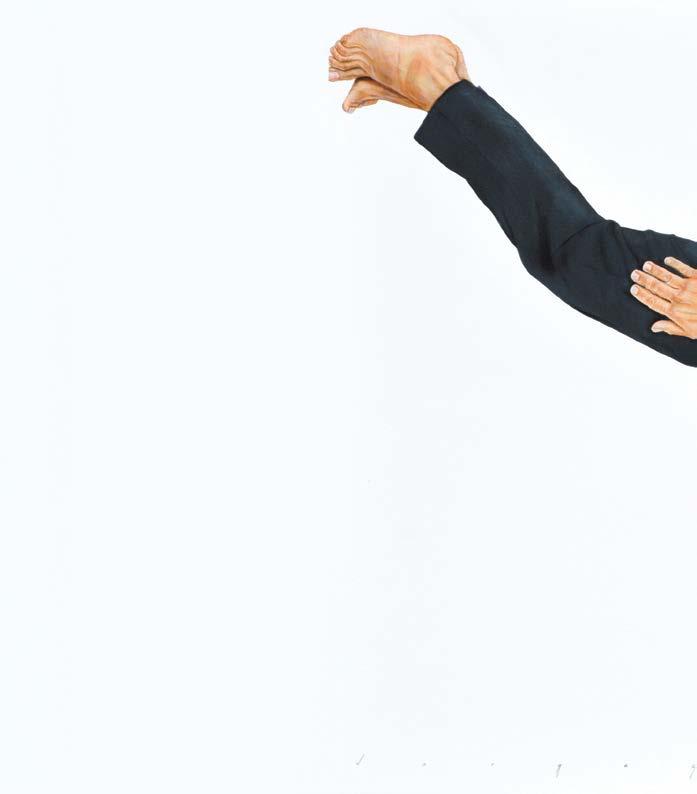
México
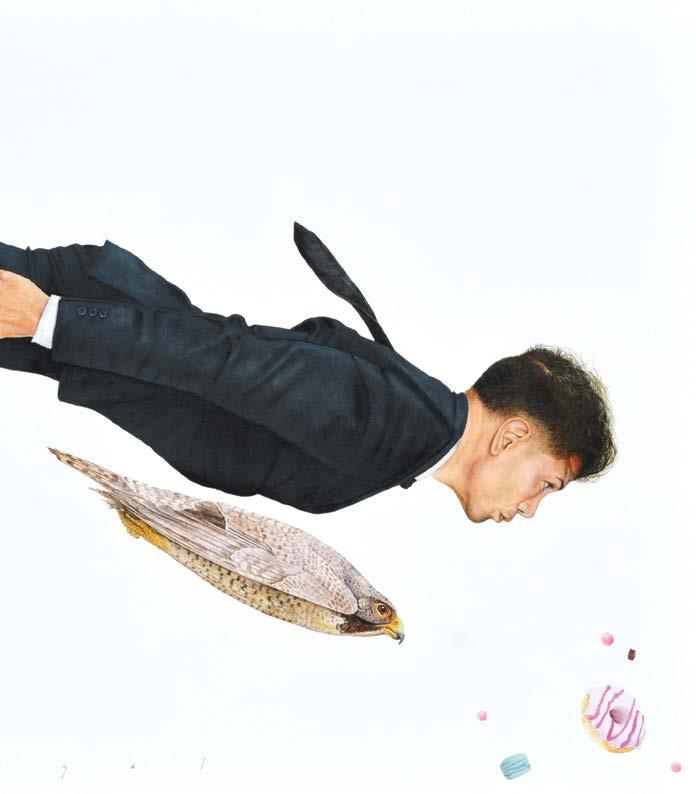 Dive to the win , 2024, acrílico sobre tela, 91 x 122 cm.
Dive to the win , 2024, acrílico sobre tela, 91 x 122 cm.
u n hombre vestido en traje de oficina vuela con aves de rapiña, pasea tranquilamente junto a una manada de hienas, salta con lémures, carga una oveja negra, tiene una cabeza de pulpo y festeja un cumpleaños con un oso pardo. Está descalzo mientras habita un espacio blanco y vacío, como una galería de artes visuales. Entre los cuerpos se vislumbran paletas de helado, chupetes, gorros de fiesta infantil, donuts y galletas de colores. Y, a pesar de la particularidad de cada elemento, las imágenes son minimalistas, elegantes, sencillas y juguetonas. Estamos ante In the Mirror, la serie de pinturas más recientes de Ariel Vargassal.
Durante sus estudios en la Universidad Nacional Autónoma de México, conoció referentes tradicionales de la pintura y el muralismo local como Diego Rivera, Frida Kahlo y Francisco Toledo, cuyas visualidades se convirtieron en una zona de confort para él. Estas influencias fueron tan grandes e innatas, que en la escuela pintaba muy parecido a estos artistas, sin embargo, en 2011 decidió migrar a Los Ángeles por la necesidad de experimentar con la pintura y conocer nuevas formas de expresarse a través de ella, al margen de la estética que caracteriza internacionalmente a las artes visuales mexicanas.
Para Ariel es muy importante abordar fenómenos sociales complejos, como el racismo, las inequidades de género, la depresión y el suicidio, pero con una impronta que no sea oscura ni remita inmediatamente al campo temático en cuestión. Utiliza el sentido del humor junto a imágenes ligeras y disímiles a la situación que quiere proyectar, para generar preguntas en los espectadores. Así, se propuso consolidar un estilo propio: “llamo a mi estilo esencialismo, no en base al concepto filosófico griego de la esencia del ser y del alma, sino como un estudio de lo esencial y lo necesario para una narrativa. No me gusta el exceso en la pintura, quiero quitarle ese concepto a la composición y dejar solamente una línea muy clara.
aman dressed in a suit flies alongside birds of prey, leisurely roams around with a pack of hyenas, jumps with lemurs, carries a black sheep, has an octopus head, and celebrates a birthday with a grizzly bear. He is barefoot while inhabiting the blank and empty space, similar to an art gallery. Among the bodies we see colorful popsicles, lollipops, children’s party hats, donuts and cookies. Despite the peculiarity of each element, images are minimalist, elegant, simple and playful. This is In the Mirror, Ariel Vargassal’s latest series of paintings.
Throughout his studies at Universidad Nacional Autónoma de México, he learned about traditional painting and mural art referents such as Diego Rivera, Frida Kahlo and Francisco Toledo, whose style became his comfort zone. These influences were so great and innate, he painted similarly to these artists. However, in 2011, he decided to migrate to Los Angeles seeking new ways of experimenting with painting and expressing himself through it, outside the aesthetics that internationally distinguish Mexican visual arts.
For Ariel, it is very important to address complex social phenomena like racism, gender inequalities, depression and suicide, but in a way that is not dark or immediately referring to the topic at hand. He uses humor and light-hearted images that contrast the situations he wants to convey in order to make viewers wonder. Thus, he set out to consolidate his own style: “I call my style ‘essentialism’, not based on the Greek philosophical concept of the essence of the self and the soul, but rather as a study of the essential and necessary for a narrative. I don’t like excess in painting, so I strip compositions from it and just leave clean-cut lines. I cannot call myself a minimalist because
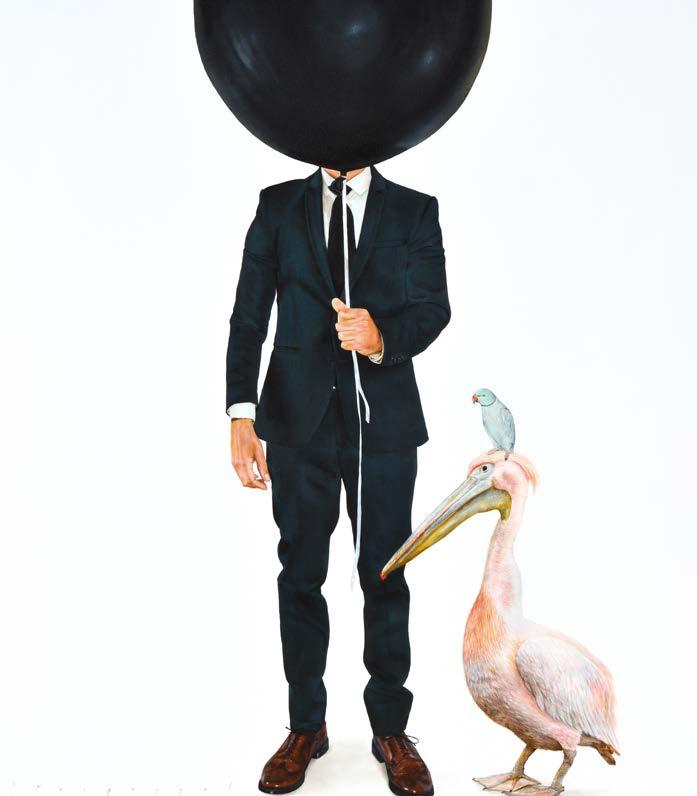 Instructions to flight, 2018, acrílico sobre tela, 152 x 122 cm.
Instructions to flight, 2018, acrílico sobre tela, 152 x 122 cm.
No me puedo llamar minimalista, porque mi obra es muy detallada y realista, tiene mucho detalle. Le llamo esencialismo, porque solo pinto los elementos que son necesarios para dar una narrativa y dejo fuera de la composición los que no son necesarios”.
Hace tres años, inmediatamente después de la pandemia, inició In the Mirror como un ejercicio de introspección, dejando de lado los conceptos universales que trabajó en series anteriores y poniéndose a sí mismo en el centro de una práctica cotidiana para mirarse al espejo. Esta serie fue impulsada por la necesidad de sanar: “fui diagnosticado con leucemia y pasé un proceso fuerte de quimioterapia. Al principio no sabía lo que tenía ni por qué estaba enfermo. Entonces tuve una necesidad de entenderme y de ver al mundo desde diferentes perspectivas, de encontrarme con otro yo. Por eso la llamé In the Mirror, porque empecé a descubrir que dentro de mí había otro punto de vista que encontré por un choque de salud”.
En estas obras hay tres elementos transversales: el autorretrato, los animales y los objetos de infancia. Ariel otorga a los animales el rol de las emociones humanas, antropomorfizándolos y caracterizándolos como seres que existen dentro del yo. Son una voz interna que sale a decir algo, o bien el desarrollo de un ego exterior que se convierte en conciencia. Por otra parte, los objetos de infancia, como los juguetes, las golosinas y los chupetes, son elementos de nostalgia y memoria, que lamentablemente el mundo de los adultos ha restringido a espacios y momentos muy específicos de la vida. Entonces, el ejercicio que él propone es imaginar que estos objetos trasciendan límites, posibilitando experiencias de inocencia y comodidad: “los objetos y los animales se convierten en parte de un diálogo y en parte de una metaforización de lo que ocurre dentro de mi voz. Se convierten en palabras visuales”.
my work is highly thorough and realist; it is very detailed. I call it essentialism because I just paint the elements necessary to craft the narrative, and I leave anything unnecessary away from the composition.”
Three years ago, immediately after the pandemic, he started In the Mirror as an introspective exercise, setting aside the universal concepts that he has addressed in prior artwork and positioning himself at the center of a daily mirror-reflection sort of practice. The series was prompted by the need to heal: “I was diagnosed with leukemia and I went through intense chemotherapy. In the beginning I didn’t know what I had or why I was sick. Then, I felt the need to understand myself and see the world differently, to find another me. That is why I titled it In the Mirror, as I found that within me there was another point of view that I discovered from a health scare.”
In these pieces, there are three cross-cutting elements: self-portraits, animals and childhood objects. Ariel assigns the animals the role of human emotions, making them anthropomorphic and beings that exist within the self . They represent the inner voice that speak to us or the development of the external ego that becomes the conscious. In turn, childhood objects such as toys, candy and lollipops are nostalgic elements that adulthood has unfortunately restricted to very limited spaces and moments in life. Thus, the exercise he proposes is to imagine the objects transcending the barriers, allowing for experiences of comfort and innocence: “The objects and animals become part dialog and part metaphor of what happens within my voice. They become visual words.”
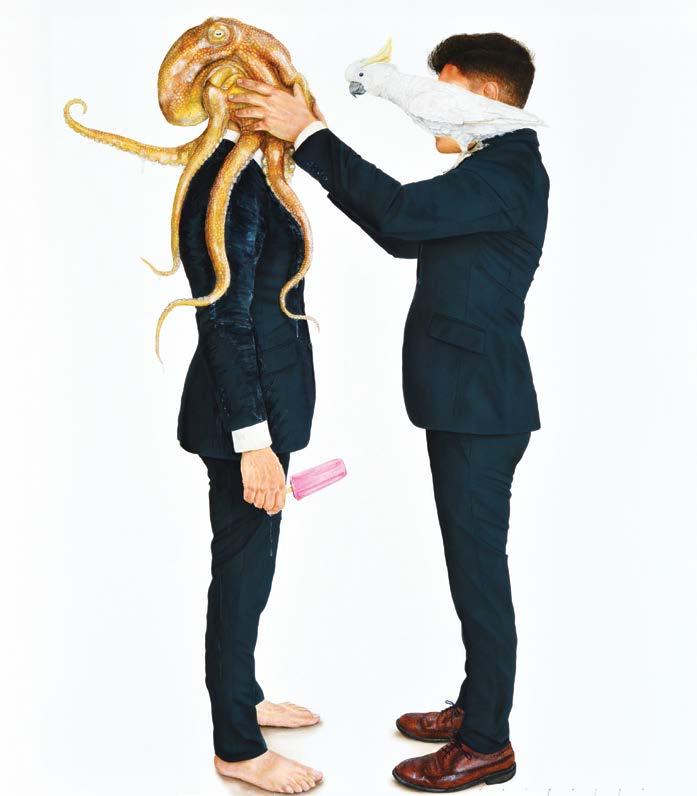 Curiosity of my other self, 2021, acrílico sobre tela, 152 x 122 cm.
Curiosity of my other self, 2021, acrílico sobre tela, 152 x 122 cm.
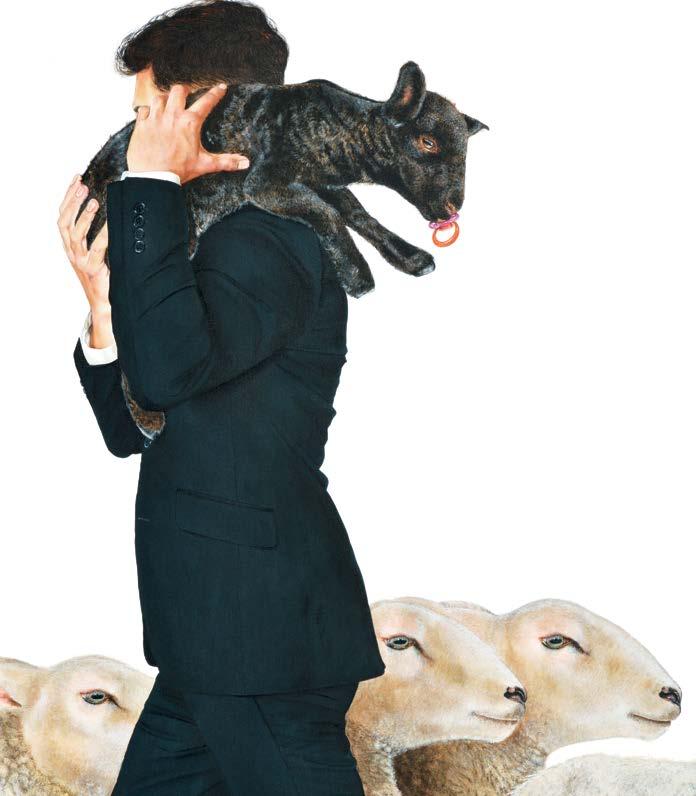
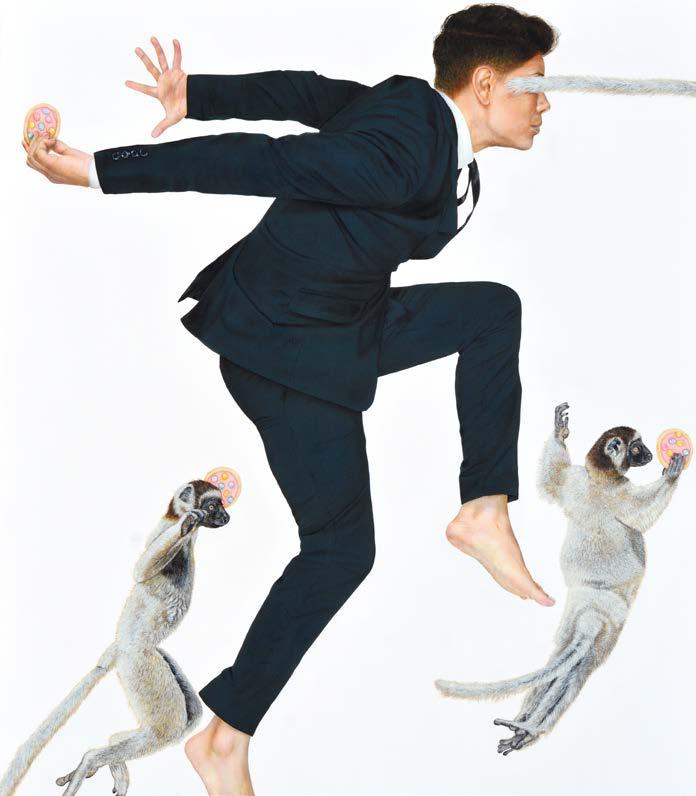 Sugar heist, 2022, acrílico sobre tela, 152 x 122 cm.
Sugar heist, 2022, acrílico sobre tela, 152 x 122 cm.
Su trabajo ha sido muy bien recibido en el extranjero, exhibiendo en ciudades de Estados Unidos y Europa. Le interesa participar de espacios donde las personas puedan acceder a sus obras y le generen ingresos para seguir pintando, sin importar si son exposiciones temporales o colecciones, tanto públicas como privadas. A pesar de que considera al arte latinoamericano como una práctica muy diversa y de la que se siente parte, afirma que en Estados Unidos se ha construido un estereotipo de cómo debería ser. Ha recibido comentarios que lo acusan de no pintar como mexicano, llevándolo a cuestionarse cómo y por qué debería pintar como latinoamericano: “si alguien de Latinoamérica migró a los Estados Unidos, es probable que tenga la necesidad de reconectarse con sus raíces, convirtiendo al arte latinoamericano en un reflejo de esa necesidad cultural. Parece ser que ese arte lleva al público estadounidense a pensar que las obras latinoamericanas deben estar muy relacionadas y atadas a ciertas influencias culturales. Nos estigmatizan, imponiendo a qué se tienen que parecer nuestras creaciones y qué estructuras deben tener. Pero cuando te sales de esa caja y experimentas con otras cosas, les rompes el esquema”.
Ahora que está fuera de México, el interés por su obra se ha incrementado. No obstante, se ha encontrado con que hay coleccionistas de América Latina que perpetúan prejuicios tradicionalistas en torno al arte creado por artistas del Cono Sur, especialmente en la pintura: “me ha tomado años desarrollar mi estilo y tener la fuerza de decir las cosas como las quiero decir, visualmente. No quiero comprometer lo que hago con las expectativas de las instituciones del arte. Si en este momento empiezo a hacer obra para satisfacer esas necesidades, va a perder su identidad”. Ariel advierte que hay agentes del medio artístico mexicano que no entienden por qué está pintando de esa forma. Por ello, ha decidido mantenerse al margen de esas expectativas del mercado, buscando nuevos horizontes para el arte latinoamericano.
His work has been very well received abroad, managing to hold exhibits in the US and Europe. He is interested in participating in spaces where people can access his work and to make a living so he can keep painting, whether that be in private or public temporary exhibitions and collections. Despite regarding Latin American art as a very diverse practice he feels part of, he states that in the US he developed preconceptions on what that meant. He has been accusingly told he does not paint as a Mexican , making him question how and why he should paint as a Latin American : “If a Latin American migrates to the US, it is very likely that they feel the need to reconnect with their roots, making Latin American art a reflection of that cultural need. It seems that the American public believes Latin American artwork must be very tied to certain cultural influences. We are stigmatized, imposed what our creations must look like and what structures they must have. But when you step out of that box and experiment, you break their mold.”
Now that he is out of Mexico, interest for his work has increased. However, he has found that many Latin American collectors still perpetuate traditional prejudice surrounding art created in the Southern Cone, particularly for painting: “It has taken me years to develop my style and having the strength to say things my way visually. I don’t want to compromise what I do due to the expectations of art institutions. If I start conforming to that now to create artwork that meet those needs, it will lose its identity.” He has noticed Mexican art agents do not understand why he is painting the way he does. For this reason, he has decided to steer clear of such market expectations, seeking new horizons for Latin American art.
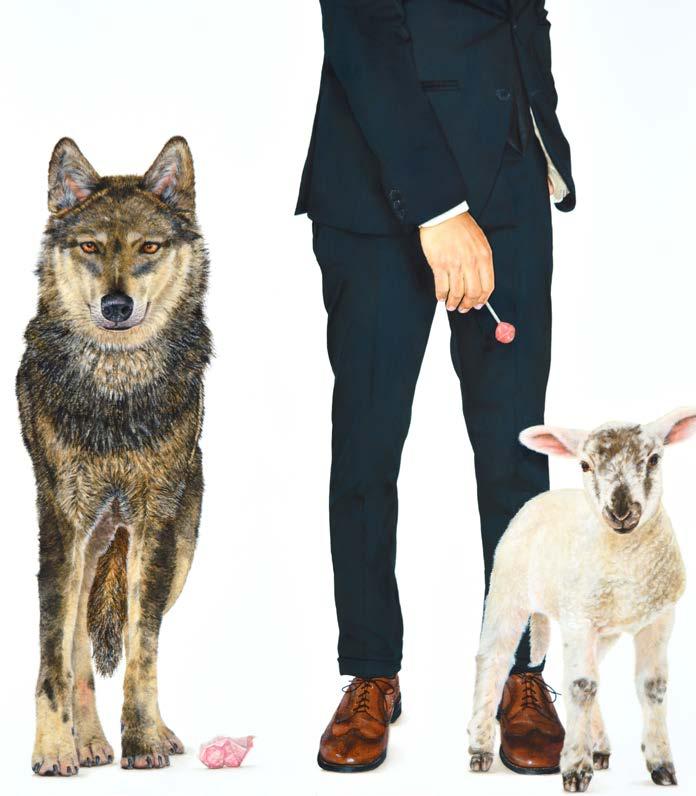 Between Lamb and Wolf , 2018, acrílico sobre tela, 152 x 122 cm.
Between Lamb and Wolf , 2018, acrílico sobre tela, 152 x 122 cm.
Imágenes cortesía del artista. Chile
Por Lucía Rey. Académica e investigadora independiente (Chile)
Representado por Spacio Nomade.
 De la serie
álbum Negro de humo , 2015, humo sobre papel, 35 × 45 cm.
De la serie
álbum Negro de humo , 2015, humo sobre papel, 35 × 45 cm.
Entre el velo de la memoria y la negrura de lo no revelable
Between the veil of memory and the blackness of the undisclosable
el humo como índice habla de la presencia del fuego y en sus múltiples sentidos nos transporta al invierno, a escenas láricas, al calor que reúne circularmente, a la acción ritual de sahumar, pero también nos puede hablar de situaciones trágicas, traumáticas y memorables, como momentos decisivos en la vida. A través de la diversidad de estas coordenadas desplegadas en el tiempo, Danilo ingresa en la poética del humo, cuya marca en los espacios es tanto presencia como ausencia. Desarrolla un modo de crear imágenes a través del humo en la búsqueda de rostros y escenas, que parecieran huir de la memoria. Así, elabora una poética simbólica del humo, que apunta con sentido histórico y político al pueblo mapuche. El uso del humo contrasta con las técnicas contemporáneas del arte que apuntan muy frecuentemente, mediante su intensa precisión, a la literalización de la imagen. Valor estético y simbólico no menor en una cultura que pareciera querer olvidar el oscuro mundo análogo, para rendirse ante la automatización luminosa de la existencia. Este elemento será coherente con el contenido buscado y elaborado en su obra, pues habla de un cosmos, en donde la vida se presenta sin gran mediación tecnológica, sino de forma directa y misteriosa.
Trabajando desde mucho antes en desarrollar esta técnica, desde el 2008, Danilo presenta en sus obras el humo relacionado con el mundo mapuche y su cosmovisión, en donde está viva la práctica de rituales periódicos en los que se usa el fuego. Así, la presencia silenciosa del humo existe como indicador de actividad social, ya sea espiritual-comunitario, como también, en lo más íntimo y casero, pues la ruka (hogar) cuenta con la presencia de un kütral (fogón central) al interior. El humo, con el mülpun (hollín), deja su marca gráfica en las paredes, en los objetos y como un elemento etéreo, liviano, impreciso, también deja una marca olfativa. Como se sabe, las marcas de este tipo han sido objeto de discriminación social hacia el pueblo mapuche en las zonas urbanas de este país, relacionándose el olor a humo con el uso del mapudungun y de sus costumbres, ya que debido a las complejas condiciones de vida se han producido varias migraciones a la ciudad.
s moke adverts the presence of fire and, in its plurality of meanings, it transports us to winter, homey scenes, heat gathering people in circles, and incense burning rites. However, it also refers to tragic, traumatic and memorable situations, such as decisive moments in life. Through the diversity of this code that has developed over time, Danilo enters into the poetry of smoke, which leaves a trace in spaces from both its presence and absence. He has developed an image-creating method through smoke, seeking out faces and scenes that seem to elude memory. Thus, he has crafted a symbolic poetry around smoke that references the history and politics of the Mapuche people. The use of smoke contrasts with contemporary art techniques that tend to make images excessively literal due to their high-level precision. The aesthetic and symbolic value of his artwork is of note in our culture, which seemingly wants to forget the darkness of the analog world and submit to the brightness of automating existence. This theme is consistent with the content he sets out to and manages to convey in his artwork, as it addresses a universe where life is portrayed with little technological intervention in a direct and mysterious manner.
Having worked on the development of this technique for a long time –since 2008–, Danilo presents smoke in connection to the Mapuche people and their world view, which has kept alive the tradition of regular fire-related rituals. Thus, the silent presence of smoke serves as a signal of social activities, whether these be spiritual-communal or intimate and homey, since ruka (home) has a kütral (central fire pit) within. Smoke, along with mülpun (soot), leaves visible marks on walls and objects. As an ethereal, light and imprecise element, it also leaves a scent behind. Marks of this type, as it is well-known, have been the object of social discrimination against the Mapuche people in the urban areas of this country, as the smell of smoke is related to the use of Mapudungun and Mapuche customs, and complex living conditions have caused them to migrate to the city.
 De la serie
álbum de Elena Mercado
Marileo , 2015, humo sobre papel, 70 x 100 cm.
De la serie
álbum de Elena Mercado
Marileo , 2015, humo sobre papel, 70 x 100 cm.
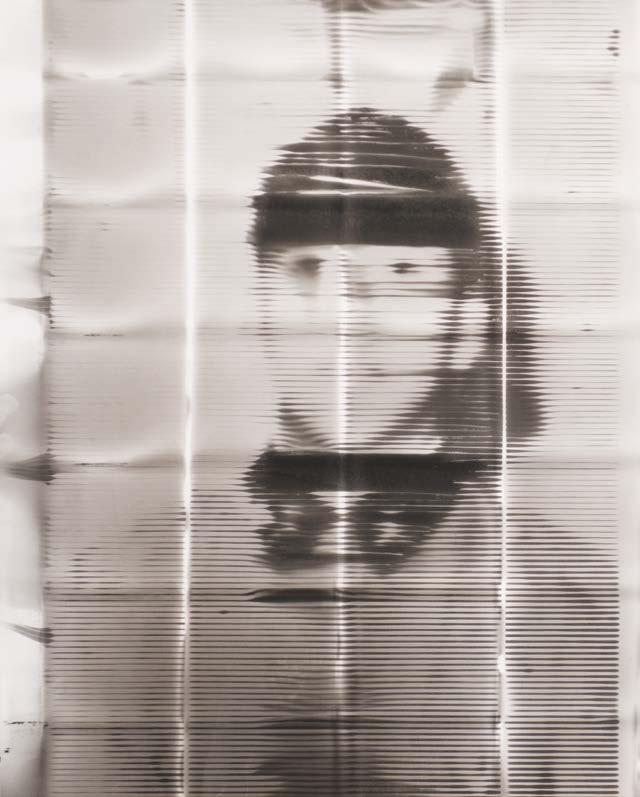
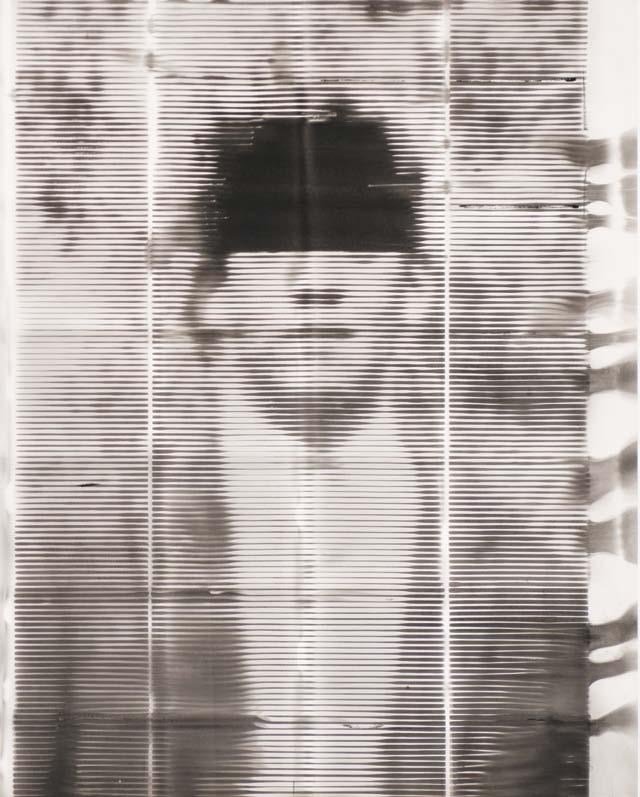 Álbum familiar Ramos Huina, 2017, humo sobre papel, 100 × 70 cm.
Álbum familiar Ramos Huina, 2017, humo sobre papel, 100 × 70 cm.
Las marcas de humo, entonces, nos hablarán tanto de tragedias, como de la quema abrupta de libros, archivos, fotografías, en la violenta invisibilización, aculturación, desaparición y borradura de memorias y conocimientos. De manera que las marcas de humo se presentan como veladura de la realidad y, en este sentido además, el autor las relaciona con los detenidos desaparecidos durante la dictadura militar en Chile; como también, al sentido de lo íntimo y del calor familiar, en el ámbito de los espacios donde se traspasan oralmente sabidurías y conocimientos no escritos.
En lo técnico, se destaca una etapa transversal en la creación de las obras. De forma análoga aplica herramientas del grabado (esténcil) que, según indica: “consiste en la impregnación de hollín sobre el papel usando plantillas caladas en el sector en que las fotografías tienen sus sombras”, ampliando las nociones tanto del dibujo y del grabado tradicional, en una articulación estética que las profundiza y poetiza. Las imágenes fotográficas aportan elementos formales, figurativos, tramas compositivas que parecen abstraerse entre las imprecisas marcas del humo. En este sentido el autor se configura, perseverantemente, como un investigador de la técnica y de la poética material, en la creación artística sensible a los contenidos mnémicos y simbólicos del dolor del otro y de los propios. Danilo trabaja transdisciplinariamente, en el sentido de que sus búsquedas y procedimientos técnicos que atraviesan diversas dimensiones de la realidad y disciplinas del saber, razón que le lleva a convocar diferentes áreas (historia, antropología, estética) para exponer su trabajo.
Aquí contamos con una selección de series de obras pertenecientes a tres contundentes proyectos: Negro de Humo, Ñamen. Desaparecer, venir en olvido y Técnica Seca (2021). Considerando que el artista llevaba a lo menos 15 años en la experimentación y elaboración de una técnica antes de hacerlas decantar en estas obras, las dos primeras series mencionadas están unidas por el contenido enfocado en el trauma que ha vivido el pueblo mapuche, en tanto imágenes que se van diluyendo en el mar de la memoria y hollín, de un grito que pareciera no tener eco en Chile.
The markings of smoke also speak on tragedy, such as abruptly burning books, archives, and photographs, in a violent obliteration, acculturation, forced disappearance and erasure of memories and wisdom. Therefore, smoke represents glazes of reality, which the artist threads to the people that were detained or who disappeared during the military dictatorship of Chile, as well as intimacy and family warmth in spaces where non-written knowledge and wisdom are transmitted orally.
In terms of technique, there is a stage that is common to the creation of all his artwork. He employs analog etching stencil tools that, as he states: “Consist of coating paper with soot using perforated stencils in the shadows of the photographs.” This way, he builds on the notions of drawing and traditional etching in an aesthetic construction that deepens and poeticizes them. Photographs contribute formal and figurative elements, compositional weaves that seem to abstract among the imprecise curls of smoke. In this sense, the author perseveringly configures himself as a researcher of technique and material poetry in artistic creation, sensitive to memories and symbolic contents of the pain of others, as well as his own. Danilo works transdisciplinary, in the sense that his research and technical procedures involve different dimensions of reality and fields of knowledge, which is why he calls on different areas (history, anthropology, aesthetics) to explore his work.
The selection of art series here belongs to three powerful projects: Negro de Humo, Ñamen. Desaparecer, venir en olvido and Técnica Seca (2021). The artist has been experimenting and perfecting a technique for at least 15 years before channeling them into these pieces. The first two are linked by themes of the trauma experienced by the Mapuche people in images that dilute in the sea of memories and soot, shouting for something that does not seem to echo in Chile.
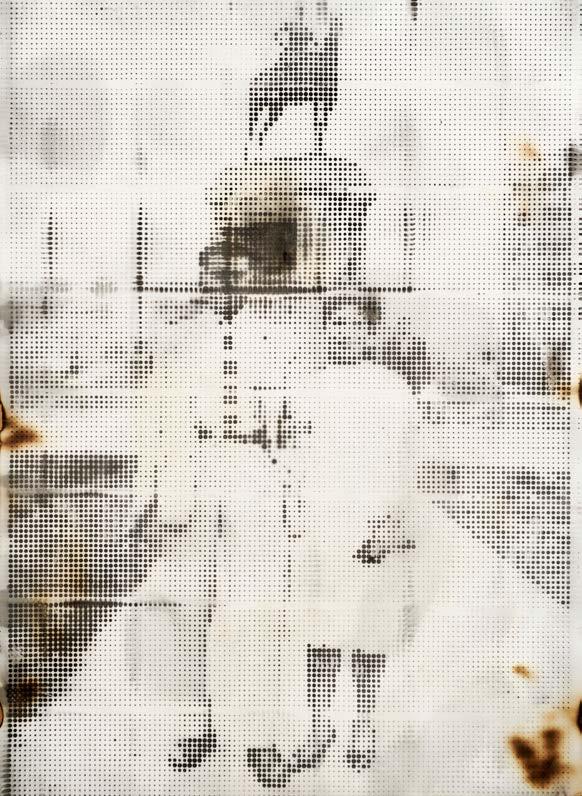 De la serie
álbum de Elena Mercado Marileo , 2015, humo sobre papel, 70 x 100 cm.
De la serie
álbum de Elena Mercado Marileo , 2015, humo sobre papel, 70 x 100 cm.
Para el proyecto Ñamen, las imágenes fotográficas son reproducciones de otras originales que muestran personas desaparecidas, otorgadas por sus familiares, a través de un largo proceso de acercamiento e indagación, donde tuvo acceso a relatos asociados a la violencia contra el pueblo mapuche, días después del golpe de Estado en Chile. Esta obra cuenta con la elaboración poética de acciones, videos-performances e imágenes trabajadas a partir de las fotografías reproducidas. Dentro de Ñamen, homónimas a la serie, hay un conjunto de obras organizadas grupalmente mediante amarres de hilos, en donde, manteniendo el tamaño original de las fotografías, el artista realiza una analogía estética del álbum familiar ahumado, dando cuerpo artístico a las narrativas íntimas pudiendo, prácticamente, visualizar el momento en que las fotografías fueron recogidas tras el desastre y atadas con la fuerza simbólica de un hilo rojo.
En la tercera serie, Técnica Seca, el autor se inspira en la experiencia práctica y sensible de su obra anterior, para ahora enfocar su propia vida en una investigación estética auto-etnográfica. En estas obras las imágenes elaboradas son expuestas tras estructuras metálicas similares al diseño de las rejas de ventanas de su infancia, transportando al espectador hacia algún hogar de antaño, tal vez hacia una propia ventana interior.
Es llamativa la persistente trama y retícula de las imágenes que consta de finísimas líneas horizontales, que nos hacen proyectar un horizonte imaginario; y otras verticales, más anchas, que como marcas dan cuenta del gesto mnémico del doblado del papel para guardarlas. Todo esto dentro del marco expandido que las pone a levitar dentro de un marco ausente. Estas particularidades estéticas que tiene la técnica desarrollada por el autor nos llevan a un estado de ensueño, como si la imagen no estuviera impresa, sino que fueran los mismos personajes etéreos mirándonos hacia dentro, en algún recuerdo.
For Ñamen , the photographs reproduce pictures of some of the people who disappeared, which were donated by their families. Through a long process of outreach and research, he accessed stories of violence against the Mapuche people, days after the Chilean coup d’état. The work creates poetry through action, video-performances and images of photographic reproductions. Within the series Ñamen, there is a set of homonymous pieces where the artist arranges original-size photographic reproductions in groups and bounds them together with thread to create a smoked family album. In doing so, he builds intimate narratives, allowing us to virtually visualize the moment the original photographs were rescued after the disaster and bound symbolically with red thread.
In the third series, Técnica Seca , the artist draws inspiration from the practical and emotional lessons learned in his prior work to now turn his own life into an auto-ethnographic aesthetic exploration. These images are shown from behind metal structures similar to the window grille in his childhood, transporting viewers to homes of yesteryear, or perhaps windows to our inner selves.
This eye-catching and recurrent grid on the images is made up of very fine horizontal lines that refer us to an imaginary horizon, and thicker vertical lines reminiscent of the markings we make upon folding a piece of paper to store it. All this happens within an expanded frame that makes the images seem to levitate on another missing frame. These aesthetic features of the technique the author has developed take us to a dream-like state, as if images were not printed, but as though the ethereal beings themselves were looking inside us, reminiscing.
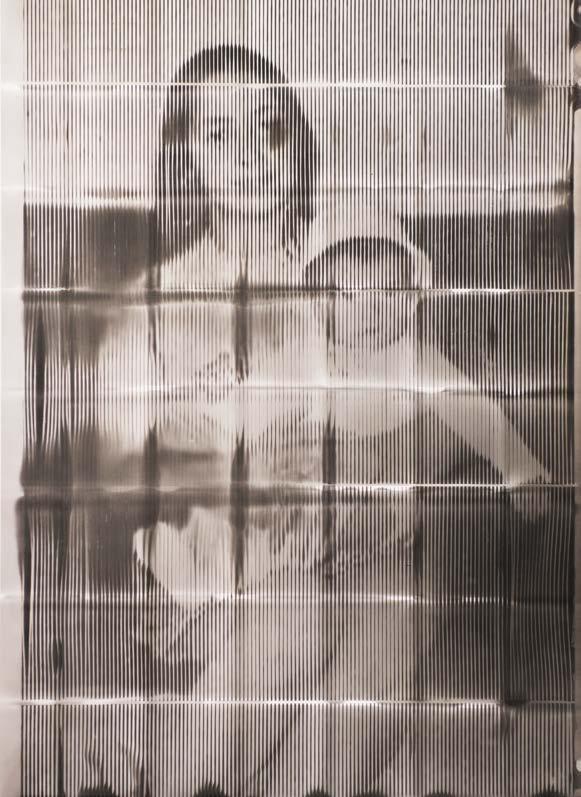 De la serie
álbum de Joel Huaiquiñir, 2017, humo sobre papel, 100 x 70 cm.
De la serie
álbum de Joel Huaiquiñir, 2017, humo sobre papel, 100 x 70 cm.
Por Ivón Figueroa Taucán. Socióloga (Chile) Imágenes de Rafael Guillén, cedidas por el artista.
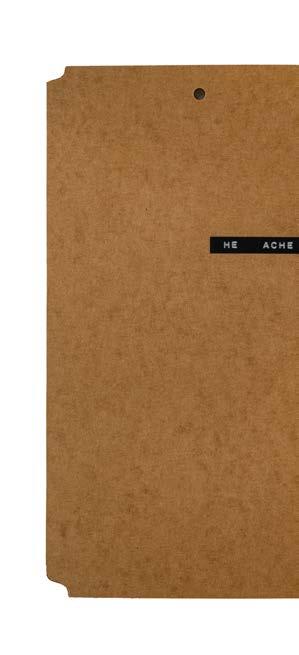
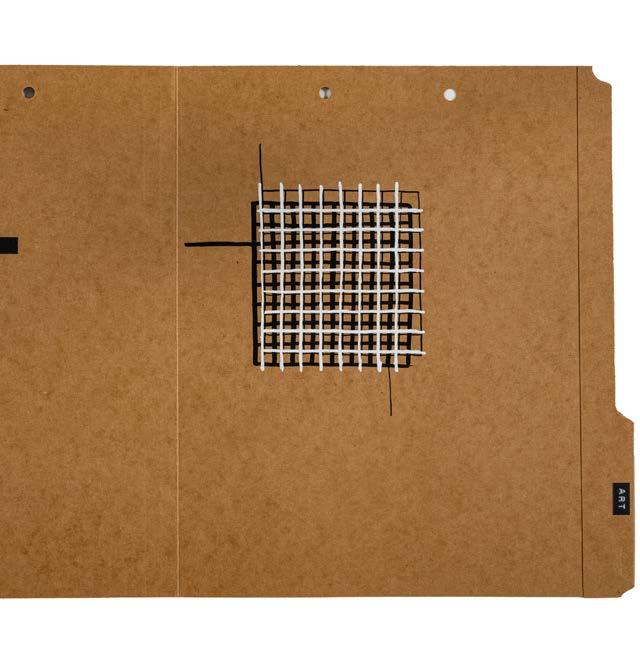 De la serie Men-Art-Work, “He ache”, 2014, tinta negra, tippex líquido, dymo negro en carpeta, 29.21 x 49.53 cm.
De la serie Men-Art-Work, “He ache”, 2014, tinta negra, tippex líquido, dymo negro en carpeta, 29.21 x 49.53 cm.
en medio de su jornada laboral, Andrés Michelena se da un espacio para conversar extendidamente sobre su obra. Se encuentra en la sala de exhibición de la Juan Carlos Maldonado Collection, localizada en el Design District de Miami, una colección de arte contemporáneo enfocada en la abstracción geométrica, de la cual es director.
Nació en Caracas en 1963, en el seno de una familia muy relacionada con el arte en sus diferentes vertientes. Realizó estudios de arquitectura en la Universidad Central de Venezuela, los cuales abandonó al cuarto año para dedicarse por completo al arte. El año 2000 decidió migrar a los Estados Unidos, donde desplazó su producción artística desde la pintura hacia el video y la videoinstalación.
Ahí empezó a tener contacto con el budismo Zen. Si bien no es budista, se considera practicante del Zazen —la meditación Zen—, una disciplina que transformó sustancialmente sus creaciones, poniendo la idea del vacío como eje de acción. Andrés ha construido modos sutiles, frágiles y delicados para -al vacío- presente en sus obras, ante la imposibilidad de trabajar directamente con él: “compongo imágenes que tienen un cierto grado de inconcluso, de algo que no está totalmente resuelto. Y son, de alguna manera, pistas de estrategias que he implementado en mi trabajo para sugerir ese vacío”.
in the middle of his work day, Andrés Michelena gifts us a moment to talk about his artwork. He is in the exhibition hall of the geometric-abstraction focused contemporary art collection he directs in the Juan Carlos Maldonado Collection, located in the Design District, Miami.
He was born in Caracas in 1963, in the bosom of a family closely related to the different branches of art. The pursued architecture studies at Universidad Central de Venezuela, which he abandoned in his fourth year to completely devote himself to art. In 2000, he decided to migrate to the United States, where his art production shifted from panting to video and video installation.
There, he also started engaging with Zen Buddhism. Though not a Buddhist himself, he practices zazen –zen meditation–, a discipline that substantially transformed his creation and positioned the concept of emptiness as the main axis of his work. Andrés has built subtle, fragile and delicate ways of representing emptiness in his work, as it is impossible to work with it directly: “I compose images that are somewhat unfinished quality, a quality of something that hasn’t been fully resolved. Somehow, they hint to the strategies I have implemented in my work to allude to that emptiness.”
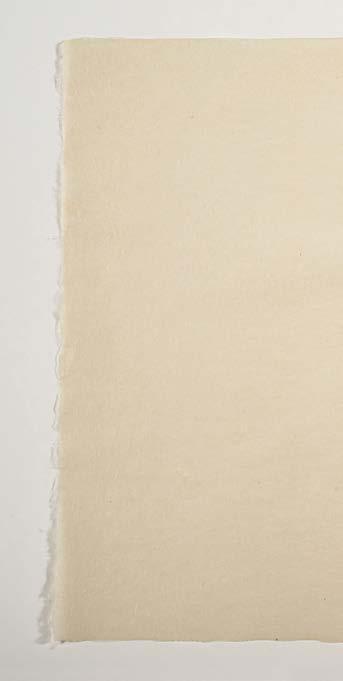
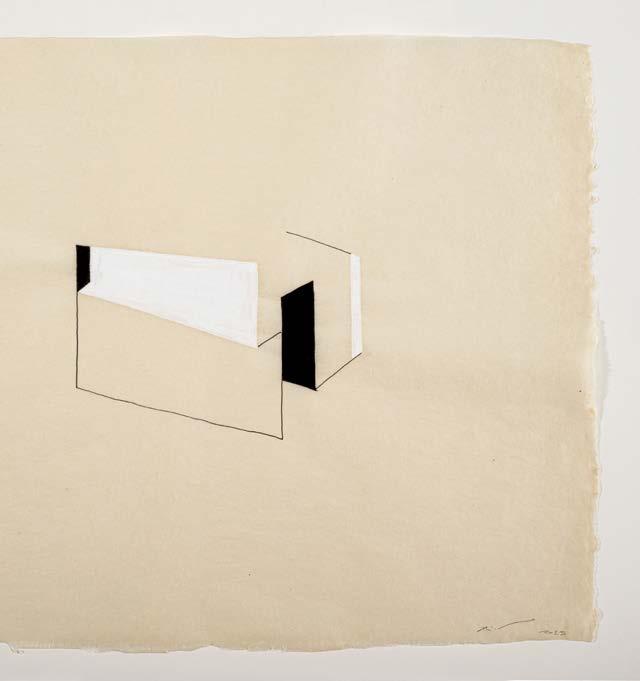 Untitled “9” , 2023, acrílico, tinta de archivo en papel yamagampi, 45.72 x 59.69 cm.
Untitled “9” , 2023, acrílico, tinta de archivo en papel yamagampi, 45.72 x 59.69 cm.
No espera tener los materiales ni las condiciones ideales. Gran parte del tiempo lo dedica a su empleo en el Design District, circunstancia que aprovecha para robustecer su cuerpo de obra. La colección que dirige está rodeada por tiendas de alta categoría que generan basura con el potencial de ser reutilizada en el diseño de una estética con componentes laborales: “una de las primeras obras que generé bajo esa actitud, fue trabajando como asistente para una galería que existió aquí en Wynwood, que fue una zona muy famosa de galerías en Miami. Sobre un bloc de notas, agarré la engrapadora de la galería. En un borde puse once grapas y en el otro borde puse cinco grapas, porque ese era mi horario. Yo trabajaba de once de la mañana a cinco de la tarde”.
Men Art Work es el título de una serie de obras en el que juega conceptualmente con las frases “hombres trabajando” y “obra de arte de los hombres”, ambas en inglés. En ella utiliza carpetas de cartón que presentan tres elementos. Por una parte, tienen un dibujo hecho con materiales propios de una oficina, como tinta negra y correctores de texto con tinta blanca. Esos dibujos proponen un reto visual, la obra no está totalmente resuelta en ellos. Al estar trazados sobre carpetas, cambian su estatus de contenedor a contenido, bajo la convención de que el dibujo es una de las formas más reconocibles del arte. Luego, en cada carpeta hay dos situaciones lingüísticas que hacen uso del vacío: “cuando la abres, en tu mano derecha vas a tener el dibujo y en tu mano izquierda vas a tener este enigma verbal que se resuelve con un pequeño detalle que está en la solapa: la palabra arte. Entonces, cuando agregas esa partícula dentro
He does not expect to have the ideal materials or conditions. Most of his time is spent on his job at Design District, which nurtures his body of work. The collection he directs is surrounded by high-end shops whose waste has the potential of being reused in the design of an aesthetic with work-related components: “One of the first pieces I created under this concept happened when I was working as an assistant for a gallery here in Wynwood, which was a very famous area for its galleries here in Miami. I grabbed the gallery’s stapler and I placed eleven staples on one of the edges of a notepad and 5 staples on another. That was my schedule, I worked from eleven to five.”
Men Art Work is the title of one of his series, a play on words of “men at work” and “men’s artwork.” In the series, he uses cardboard folders featuring three different elements. First, drawings made with office supplies such as black ink, and white liquid paper. These drawings pose a visual challenge; the pieces are not totally resolved with them. Since they are drawn on folders, their status changes from container to content, under the convention that drawing is the most recognizable form of art. Then, every folder contains two linguistic puzzles that use the empty space: “When you open the folder, the drawing is located to the right and that verbal enigma is to the left, which can be solved with the tiny detail in the tab: the word art. Then, when that particle is added to the

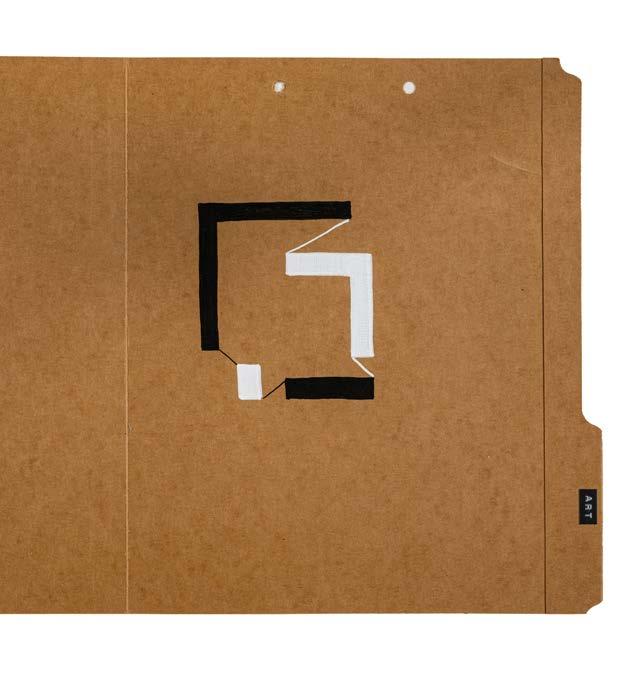
iculation”,
la serie
De Men-Art-Work, “Dis 2014, tinta negra, tippex líquido, dymo negro en carpeta, 29.21 x 49.53 cm.de la palabra que está al lado izquierdo del dibujo, se completa”. Las palabras tienen un rol importante en algunos de sus procesos creativos, estableciendo una conexión directa con el arte conceptual.
Siente una relación emotiva con la estética japonesa, especialmente el Mono-Ha, un movimiento iniciado en la década de los sesenta cuando los artistas reinterpretaron el minimalismo de forma más naturalista, dándole cabida al error y posicionándose críticamente ante el avance de la industrialización: “me gusta mucho la combinación de sobriedad con profundidad, incluso con poesía. Ellos han creado la posibilidad de algo muy poderoso a partir de lo débil, de lo frágil. La relación con ese tipo de manifestaciones creo que se puede notar en mi trabajo”.
Ejemplo de ello es una serie de obras sin título creadas en 2023, que pertenecen a la serie Incoherencias. Fueron nueve dibujos con influencias de la arquitectura, construidos a partir de líneas sin pretensiones de perfección y abiertas en términos de su interpretación: “la idea era hablar de cómo los seres humanos hemos abordado el progreso. Hemos crecido, avanzado, progresado, pero, en muchos casos, hemos debilitado la base de los que nos mantiene unidos como sociedad y es parte de nuestras incoherencias en este mundo”. Los dibujos están hechos sobre papel Yamagampi, un material japonés hecho a mano que impide corregir los trazos , revelando la fragilidad del pulso y de la ejecución.
word to the left of the drawing, it becomes complete.” Words have an important role in some creative processes, establishing a direct connection to conceptual art.
The artist feels emotionally linked to Japanese aesthetics, especially Mono-ha , a 60s movement led by artist who interpreted minimalism the naturalist way, allowing for mistakes and criticizing the advent of industrialization: “I like the combination of austerity and depth, even in poetry. These create the possibility of something very powerful through something weak, fragile. I think the relationship with this sort of manifestation is noticeable in my work.”
An example of this is a set of untitled works created in 2023 from the series Incoherencias (Incoherences). These are nine drawings inspired by architecture, built through lines with no claims of perfection, open in terms of their interpretation: “The idea was to speak on how human beings have address progress. We have grown, advanced and progressed but, in many cases, we have weakened the foundation that keeps us united as a society, and that is part of the incoherence in this world.”
The drawings are made on Yamagampi paper, a handmade Japanese material that prevents stroke correction, thus evincing the fragility of the pulse and execution.

 Untitled “6” , 2023, acrílico, tinta de archivo en papel yamagampi, 45.72 x 59.69 cm.
Untitled “6” , 2023, acrílico, tinta de archivo en papel yamagampi, 45.72 x 59.69 cm.
Andrés afirma que, con el paso del tiempo, su obra se ha ido colando en el medio artístico de Miami. Cuando decidió migrar, había tenido algunas exposiciones individuales en galerías de renombre y tenía el reconocimiento público de algunos artistas de su generación, pero no era ampliamente reconocido en Venezuela, su país natal. En los Estados Unidos empezó desde cero, lo que valora positivamente; la falta de éxito y reconocimiento en sus inicios le otorgó la libertad de seguir ejecutando sus ideas en un ritmo propio y de generar cambios en el camino: “muchas veces ocurre que hay artistas que se terminan convirtiendo en esclavos del mercado. Una vez que tienes un éxito muy grande y empiezas a ser reconocido por un cierto tipo de obra, el mercado empieza a reclamar ese estilo de piezas y muchas veces se termina esclavizando a una expresión única. Ese es el tipo de cosas que maneja el mundo del arte de una manera muy peculiar. Ese matrimonio con estéticas, con producciones exitosas, muchas veces crean una cárcel donde el principal guardián termina siendo el propio artista”.
Antes de terminar la videollamada, reafirma, con una sonrisa en el rostro, que el éxito no es sinónimo de reconocimiento público, sino que está en la oportunidad de continuar creando y viviendo procesos creativos en los que pueda modificar sus piezas al margen de lo que el mercado artístico espere de él.
Andrés states that, in time, his work has penetrated the Miami art scene. When he decided to migrate, he had had solo exhibitions in renowned galleries and was publicly praised by some artists of his generation, but was not widely acclaimed in Venezuela, his native country. In the United States, he started from scratch, which he regards as a positive thing. The lack of success and recognition in his early days granted him the freedom to continue developing his ideas at his own pace and to make changes along the way: “Many times, artists end up becoming slaves to the market. Once you are very successful and begin to be celebrated for a specific type of artwork, the market starts demanding those sorts of pieces and that single expression enslaves them. That is the kind of thing that the art world handles in a very peculiar manner. That being committed to a single style, successful productions, oftentimes creates a prison in which the main guardian are artists themselves.”
Before hanging up from our video call, he states, with a smile on his face, that success is not synonymous with public acknowledgment, but it rather lies in the possibility to keep creating and experiences creative processes that allow for shifts in his work, regardless of what the art market expects from him.
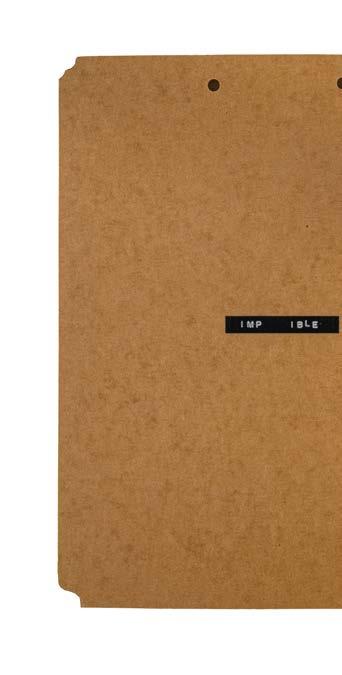
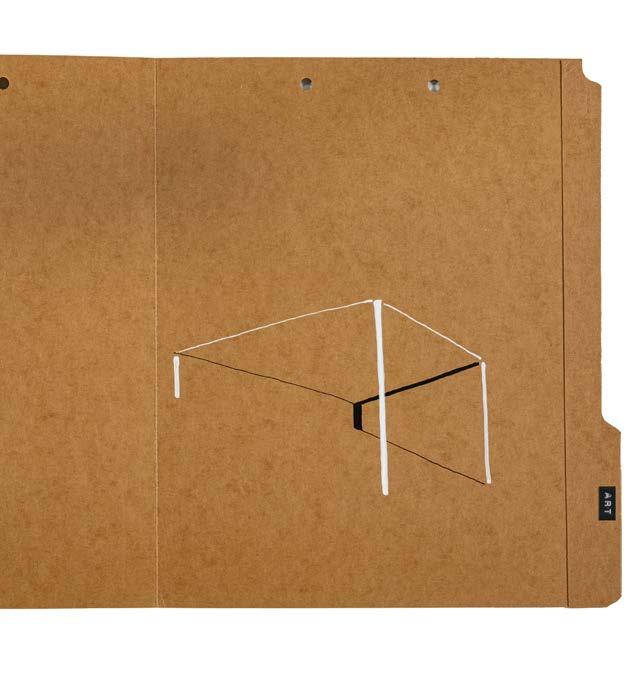 De la serie Men-Art-Work, “Imp ible”, 2014, tinta negra, tippex líquido, dymo negro en carpeta, 29.21 x 49.53 cm.
De la serie Men-Art-Work, “Imp ible”, 2014, tinta negra, tippex líquido, dymo negro en carpeta, 29.21 x 49.53 cm.
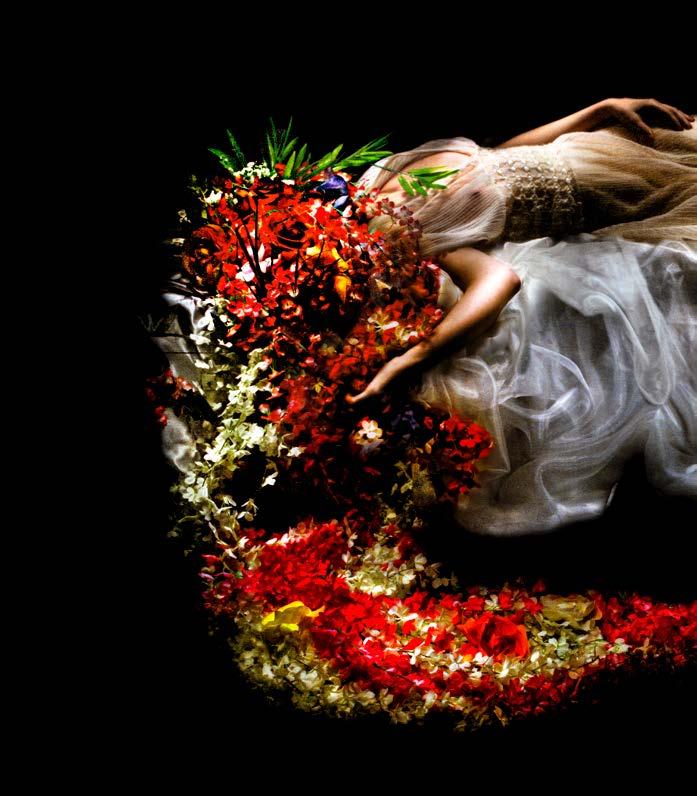

Por Julio Sapollnik. Crítico de Arte (Argentina) Imágenes cortesía del artista.
El retorno de la tristeza, 2023, fotografía color, foto performance lumínica, sublimación sobre seda, 140 × 160 cm.
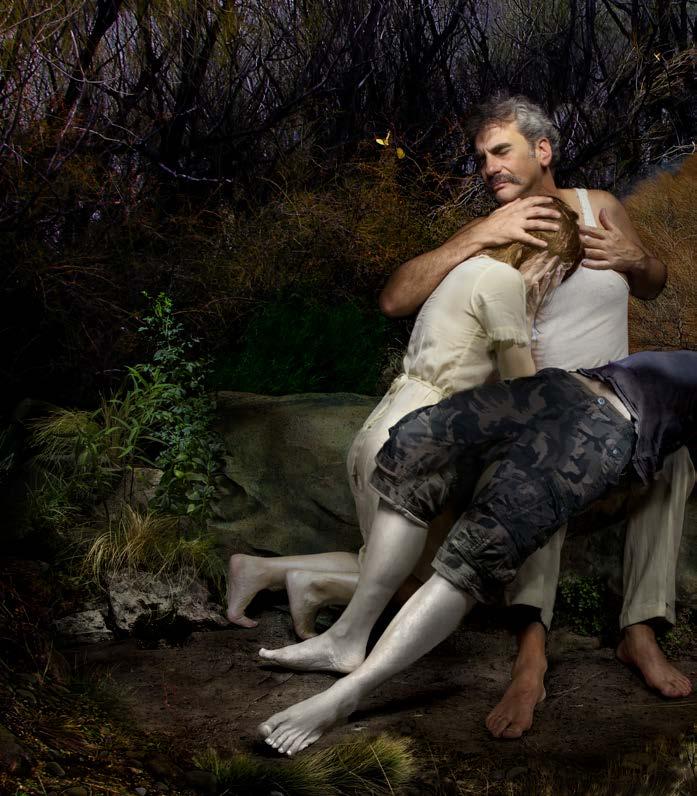
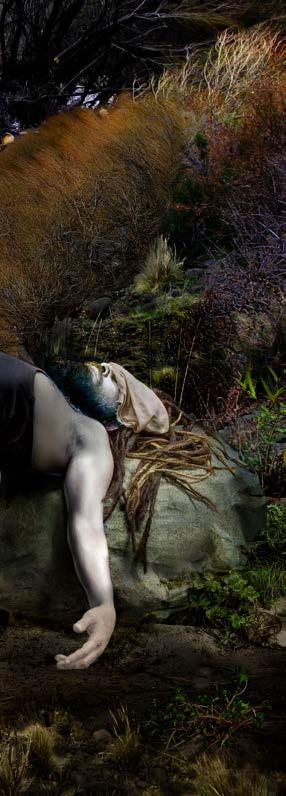
la entrada de Arturo Aguiar al arte fue por la pintura. Esto nos recuerda los inicios de la fotografía. Los primeros fotógrafos fueron pintores. Al realizar un retrato, el elevado tiempo de exposición requería de grandes habilidades técnicas para efectuar los retoques necesarios.
La búsqueda estética de Arturo está en consonancia con el pictorialismo, un movimiento fotográfico que, partiendo de las teorías románticas del siglo XIX, destacaba la jerarquía de la sensibilidad asociada a la inspiración. La imagen adquirió un nuevo valor, superó la mera técnica y se alejó de la esencia instantánea y documental que se le otorgaba a la fotografía en aquella época.
Arturo cursó estudios para la Licenciatura en Ciencias Físicas en la Universidad de Buenos Aires. Al leer un artículo de Umberto Eco donde reflexionaba sobre la “creación del propio saber”, comenzó a pintar y a experimentar con la práctica fotográfica. El primer desafío fue desarrollar como tema el autorretrato. De su estudio universitario lo que más lo cautivó fue la representación del tiempo y el espacio. Así unió en la imagen esos dos conceptos, sumando la luz.
Al abordar el autorretrato comenzó a jugar delante de la cámara, moviéndose e iluminando con un dispositivo experimental, mientras mantenía abierto el obturador de la cámara. Ese módulo que controla el tiempo en que llega la luz a la película o al sensor digital, le permitió descubrir una propia performance.
A partir de sus lecturas sobre teoría del conocimiento, Aguiar aprendió que solo “vemos lo que podemos nombrar”. Fue el punto de partida para ir en
arturo Aguiar’s introduction to art was through painting. This reminds us of the early days of photography, as the first photographers were painters. To produce a portrait, low shutter speeds required photographers to possess great technical skill to make the necessary retouches.
Arturo’s artistic quest aligns with pictorialism, a photography movement inspired by romanticized 19th century theories that emphasized the hierarchy of sensitivity related to inspiration. The image gained new value, surpassing the quality of mere technique and moving away from the instant and documentary nature of photography at the time.
Arturo pursued studies in Physical Sciences at Universidad de Buenos Aires. When he read an article by Umberto Eco in which he reflected on “creating one’s own knowledge”, Arturo resolved to start painting and experiment with photography. The first challenge he encountered was to build on self-portraits as the main theme. Representations of time and space were the most fascinating things for him during his years at university. Thus, he merged both concepts, after which he also added lighting.
Through his work with self-portraits, he started to play in front of the camera, moving around and lighting the scenes with an experimental device, while he kept the camera shutter open. This component that controls how long the film or digital sensor is exposed to light helped him discover his very own sort of performance.
From reading about theories of knowledge, Aguiar learned that we only “see what we can name”. This was the starting point for him to set out on
La fin du monde, 2023, fotografía color, foto performance lumínica, sublimación sobre seda, 140 × 210 cm.
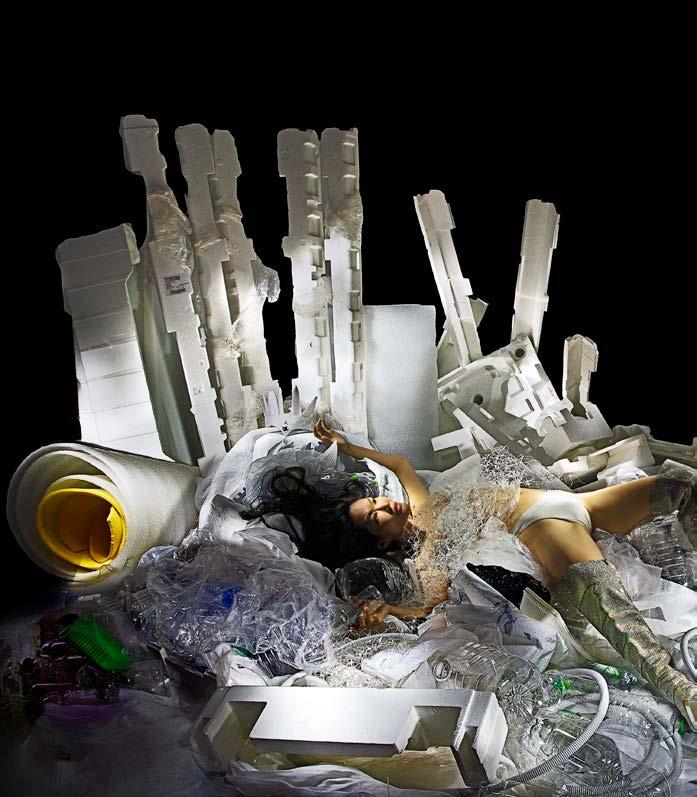

busca de lo inefable. Comenzó a desarrollar una estética propia, donde la representación de un punto de luz inquieta e interroga al espectador. Su fotografía provoca una sensación de extrañamiento, la mirada recorre la imagen buscando el Big Bang, el momento donde todo comenzó.
Puede fotografiar un paisaje nocturno que al iluminarlo aquí y allá activa la mirada del contemplador, buscando una definición para entender porqué la visión de lo fotografiado se intuye aterradora.
En 2023, Arturo Aguiar realizó una muestra en el Centro Cultural Ricardo Rojas de la Universidad de Buenos Aires. La tituló Luces y sombras de lo humano, y por medio de la inteligencia artificial basada en la arquitectura GPT3.5, creó a Gala Pandora Torrent, una exquisita y dedicada curadora especializada en artes plásticas. El lugar virtual de su existencia era la computadora personal de Arturo. Gala se transformó en su asistente personal, generando diálogos sobre su obra y la de otros artistas. Este juego virtual buscaba desenmascarar el uso de palabras vacías en la relación entre técnica y sentido. Una expresión científica del capitalismo avanzado que aleja al ser de su conciencia humanista. ¡Es increíble, pero la esencia creativa de nuestro artista le permite divertirse ampliando fronteras mentales!
En el desarrollo de su obra la fotografía iluminada a mano le permitió encontrar una técnica singular que combina precisión y sensibilidad, pero también acepta el error como aporte creativo. O la mancha, como un medio que incorpora una naturaleza impensable e imprevisible. La imagen
a quest for the ineffable. He started developing his own style, where the representation of a beam of light unsettles and questions the viewer. His photography causes a sensation of strangeness; the eye travels through the image looking for the Big Bang, the moment where it all began.
He can shoot nightscapes and, with strategic lighting, he manages to direct the viewers’ eye, looking for a way to understand why the sight of the photographs seems terrifying.
In 2023, Arturo Aguiar showed a sample at the Ricardo Rojas Cultural Center from Universidad de Buenos Aires, which he entitled Luces y sombras de lo humano. In it, he used a GPT3.5-based language model to create Gala Pandora Torrent, an exquisite and devoted IA curator specializing in visual arts. Her virtual existence resided in Arturo’s personal computer. Gala became his personal assistant, and together they discussed his and other artists’ work. This virtual game aimed to unmask the use of empty works related to technique and meaning, a scientific expression of the rampant capitalism that distances us from our humanist conscious. It is truly remarkable, but our artist’s creative essence allows him to have fun by expanding mental boundaries!
Manually lighting his photographs unlocked the discovery of a one-ofthe-kind technique that combines precision and sensitivity, but that also allows for errors to contribute to the creative process and splotching to consolidate an unthinkable and unpredictable nature. Images become
Venus, 2024, fotografía color, foto performance lumínica, sublimación sobre seda, 140 × 210 cm.
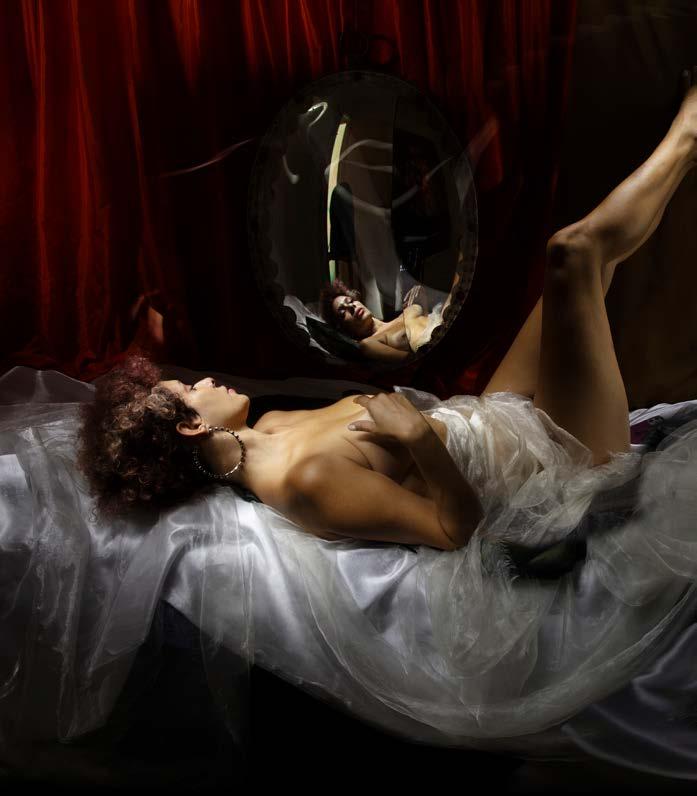
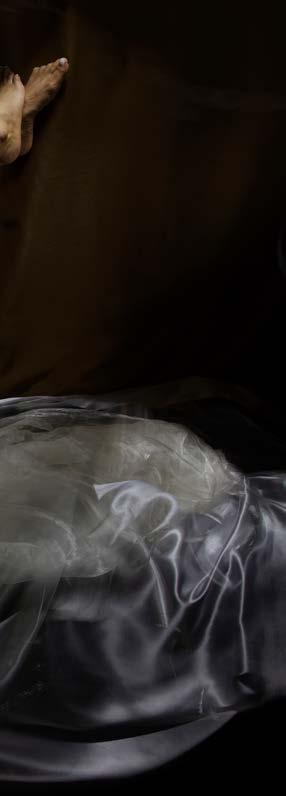
se convierte en una inimaginable fuente de creación, atraviesa un camino errático e indeterminado en su aproximación a lo real. En cada nueva toma alcanza una expresión personal, no porque capturó lo que está frente a la cámara, sino por la emoción que le imprime al momento de crearla.
A diferencia de la iluminación tradicional, Arturo creó un nuevo lenguaje que le permitió el control sobre la luz, alcanzando imágenes vivas de mayor naturaleza orgánica. La interacción entre la luz y la sombra comenzó a adquirir una importancia crucial, descubriendo contrastes intrigantes, sorprendentes y de gran profundidad visual.
La fotografía de Aguiar ofrece una versatilidad incomparable. Desde sus retratos íntimos, pasando por interiores o paisajes, captura la mirada por lo impredecible. Sus trabajos se destacan por una definida singularidad y una especial sofisticación. Cada fotografía es el resultado de una cuidadosa planificación, reflejando el compromiso del fotógrafo con su arte.
Arturo se alejó de la luz natural como fuente omnipresente que concentra lo visual sobre un ambiente realista. Desde la titilación que emite la luz dirigida manualmente, consigue fijar emociones gozosas o dramáticas, porque nacen desde la dinámica de lo que el artista quiere descubrir.
En su serie titulada Formas de luz, investigó sobre la creación de imágenes abstractas que enaltecen las propiedades de la luz y el color. La técnica creada que denominó “fotoperformance lumínica”, nació por el empleo de
an unimaginable source of creation through their erratic and undefined path towards their approach to reality. Every new shot attains a personal expression, not because he captures what is in front of the camera, but due to the emotion he captures.
Unlike traditional lighting, this technique establishes a new language that enables control over light, producing lively images with a greater organic nature. The interaction of light and shadow started thus to acquire crucial importance, discovering intriguing, surprising and visually complex contrasts.
Aguiar’s photography offers an unparalleled versatility: from intimate portraits to indoor scenes or landscapes, he captures people’s attention due to the pieces’ unpredictability. His artwork stands out for its sharp singularity and a special sophistication. Every photograph is the result of careful planning and execution, reflecting the photographer’s commitment to his art.
Arturo moved away from natural lighting as the omnipresent source highlights visuals in an organic and realist environment. Thanks to the flickering of the manually controlled lighting, he is able to capture joyful or dramatic emotions, because they are born from the dynamics of what the artist wants to discover.
In his series entitled Formas de Luz , he delved into abstract images that highlight light and color properties. The technique, which he called “light photoperformance”, was the result of using an exper -
Retrato de familia, 2023, fotografía color, foto performance lumínica, sublimación sobre seda, 110 × 140 cm.


un dispositivo experimental que le permitió representar composiciones abstractas, fotografiadas en tomas de larga duración. El tiempo de exposición, la superposición de las formas en el espacio y la exacerbación de los planos cromático-luminosos proporcionan una unidad creativa que recuerda aquella búsqueda iniciática donde todo comenzó. Así lo podemos observar en la indumentaria. Al imprimir sobre seda diseñó una vestimenta informal que se incorpora a la vida cotidiana. Recordemos a Octavio Paz cuando escribió: “La contemplación estética se terminó porque el arte se disuelve en la vida social”.
Al proponer un mundo que a simple vista no se puede ver, la fotografía de Arturo comenzó un derrotero internacional que, partiendo de sus exhibiciones en Argentina, continuó por Francia, España. Portugal, México, Estados Unidos, Costa Rica, Colombia, Bélgica y Alemania.
El impacto de la imagen nace por la acumulación de la luz en los objetos que llegan al ojo. Al introducir iluminaciones performáticas, nacidas de la intuición del artista, Aguiar interviene sobre la imprimación de la imagen. Las escenas fotografiadas revelan un universo oculto, una nueva manera de ver que sorprende e interroga.
La obra de Arturo Aguiar tiene un grado de perfección caravagesca. A partir del trabajo dinámico de la luz consigue que cada elemento se perciba de modo diferente. Nada queda unificado. Las texturas visuales resaltan su individualidad al igual que las personas se diferencian en la vida.
imental device that allowed for abstract compositions to be shot in long exposures. The shutter speed, the overlapping of shapes in the space and the heightened color-light planes provide a creative unity reminiscent of that initial quest where it all began. This is also the case for his fashion design. He has designed informal garments for daily life by printing on silk. This reminds us of Octavio Paz as he wrote: “Aesthetic contemplation is over because art dissolves into social life.”
By proposing a world that cannot be seen with the naked eye, Arturo’s photography began an international journey that started with exhibitions in Argentina and continued in France, Spain, Portugal, Mexico, United States, Costa Rica, Colombia, Belgium and Germany.
The impact of his images stems from the concentration of light on the objects that meet the eye. By introducing performative lighting led by the artist’s intuition, Aguiar influences the way images are captured. His photographed scenes reveal a hidden universe, a new way of perceiving that surprises and challenges.
Arturo Aguiar’s work features a certain degree of Caravaggist perfection. Through his dynamic work with light, he manages to make all the elements be perceived differently. Nothing is unified. Visual textures signal their individuality just like people are different in life.
MUSEO AAL TE INVITA A EXPLORAR EL PODER DEL ARTE CONTEMPORÁNEO.
AAL MUSEUM INVITES YOU TO EXPLORE THE POWER OF CONTEMPORARY ART.
PANQUEHUE, REGIÓN DE VALPARAÍSO, CHILE

Por Elisa Massardo. Lic. en Historia y Estética (Chile) Imágenes cortesía de Alfonso Yunge.
Representada por Factoría Santa Rosa.
¡¡¡¡¿¿¿¿ Quién puso la mesa !!!!!???? , 2023, collage tridimensional, madera, porcelana, metal, 65 x 18 x 15 cm. aprox. Foto: Alfonso Yunge.
De la serie
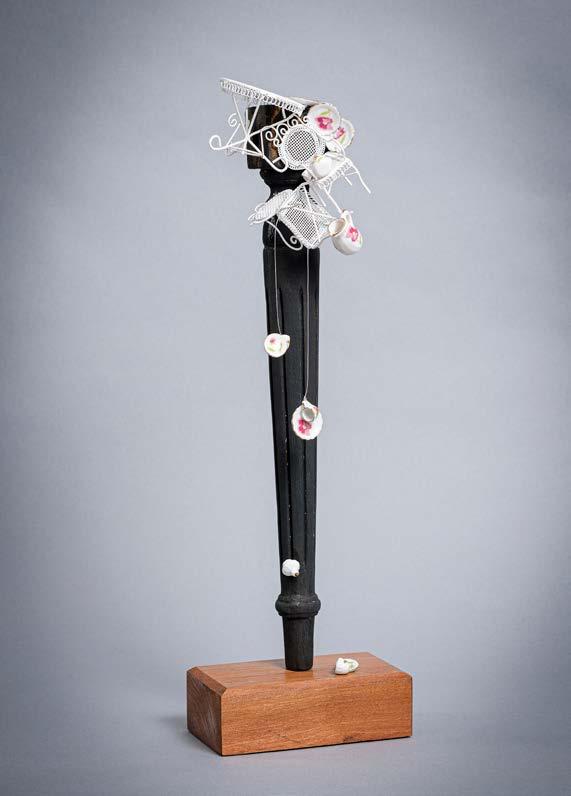
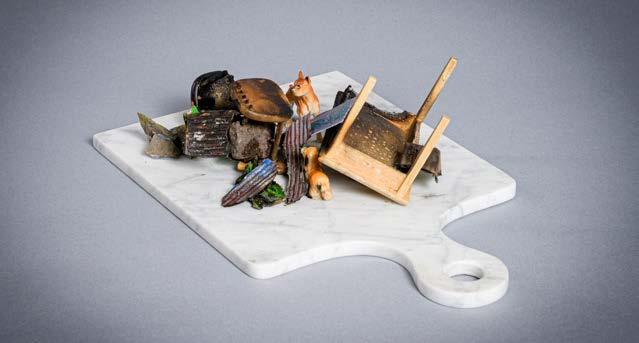
Revelar la incomodidad de la violencia
para generar incomodidad se necesita romper la armonía. Tanto en la pintura como en la escultura, donde los griegos y muchas culturas han buscado una matemática perfecta, la compensación visual, el cruce de líneas que permita dar equilibrio a la visualidad; es donde varios artistas, también, han encontrado el punto de quiebre: romper estas formas que generan armonía, para que el espectador se sienta incómodo y logre comprender que en la vida, no todo es color de rosa
“Busco enfrentar al espectador a escenas de desequilibrio y situaciones de violencia para mirar desde fuera y, en algunos casos, desde la ironía”, señala María Angélica Echavarri sobre su última serie de obras, donde la violencia en todas sus formas es el tema central. Según explica, son “situaciones que de tan comunes, ya no nos llaman la atención. Así, a través de la descontextualización logro que la gente se detenga y mire con la esperanza de ver lo que les estoy mostrando”.
Loza, sillas, una mesa, penden de unos hilos sobre una figura inestable; o se encuentran desarmados y desparramados encima de una superficie que puede ser la cubierta de un mueble de cocina o de una mesa, pero que en realidad es una tabla de picar o una bandeja de plata, ¿por qué lo íntimo se hace relevante en la obra de María Angélica Echavarri?, ¿qué busca enseñar y demostrar o revelar a través de estas instalaciones escultóricas?
La mesa es el elemento estable; aquel lugar de encuentros familiares, de trabajo, de amistad, del debate cotidiano, de lo íntimo y lo colectivo, que
to cause discomfort, you need to disrupt harmony. In both painting and sculpture –disciplines where the Greeks and many cultures have sought out perfect math, visual counterbalancing, intersections of lines providing harmony to visuals–, many artists have found a breaking point: disrupting the shapes that create balance so that viewers feel uncomfortable and understand that in life, not everything is rosy
“I aim to confront viewers with unbalanced scenes and violent situations so they can look from the outside and, sometimes, with irony,” María Angélica Echavarri says about her latest series, where violence in all its forms is the main topic. As she explains, the pieces are “situations so common, they no longer capture our attention. By decontextualizing them, I get people to stop and look, in the hopes they actually see what I’m showing them.”
Dishes, chairs and a table hang from threads and balance atop an unstable figure; or they are disassembled and scattered on top of a surface that may seem like a kitchen counter or tabletop, but is actually a chopping board or a silver tray. Why is the intimate so relevant in María Angélica Echavarri’s work? What is she trying to teach, show, or reveal through her sculpture installations?
Tables are stable elements, a place for where family, coworkers and friends gather, a place for day-to-day, intimate and collective discussions. Tables
“¿Le gustaría servirse este platito?”, 2023, collage tridimensional, mármol, porcelana, juguetes, 18 x 20 x 30 cm. aprox. Foto: Alfonso Yunge.
De la serie
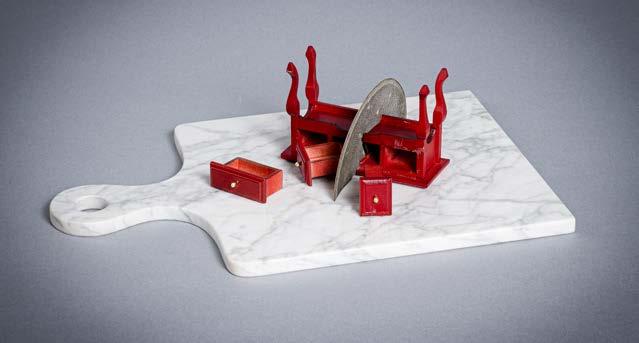
puede representar aquel espacio donde se conversa la violencia social, pero se ejerce la psicológica a través de la familia. “La temática se afirma en una pata de esa mesa, bastante inestable, por decir lo menos. Los juegos de vectores se realizan a través de estas dimensiones exageradas”, así todo queda inseguro, incierto, propenso a la fractura y a la caída.
En Chile se comenta constantemente que hay un aumento de violencia, ¿qué piensas de ello?
No solo las estadísticas muestran que ha aumentado la violencia. Se ve en las reacciones de las personas en la calle, entre los alumnos en los colegios, en la cantidad y forma de los asaltos y crímenes. El terrorismo en el Sur de Chile. Violencia en la frontera del Norte, en algunas ciudades más que en otras. Las guerras en el mundo. Es bastante violento el ambiente en general. El temor ha cambiado nuestros hábitos, nuestros horarios. Es algo muy palpable. Se siente, se nota.
¿Por qué decides abocarte a la violencia doméstica?
No solo hablo de violencia doméstica; más bien la expongo en paralelo a la pública. Quiero que pensemos cómo ambas provocan una gran inestabilidad en diferentes ámbitos de nuestra sociedad.
De todas formas, ¿cómo definirías la violencia doméstica, que parece implícita en tu obra?
La violencia doméstica para mí es la más difícil y cruel porque es la que se calla. La que se oculta. De la que no se habla. El daño es profundo
can also represent the space where social violence is discussed, but psychological violence is exerted by family. “The subject matter stands on a leg of that table, quite shaky, to say the least. The interplay of the vectors is done through these exaggerated dimensions,” and thus everything remains uncomfortable, uncertain, vulnerable to breakage and falling.
In Chile, people are constantly talking about violence increasing. What do you think about this?
It is not only statistics that show that violence has increased. We can see it in people’s reactions on the street, among schoolchildren, in the amount and the way that muggings and crimes happen. In the terrorism in the south of Chile. Violence in the northern border, though in some cities more than others. Wars around the world. Our surroundings have become very violent overall. Fear has changed our habits and our schedules. It is very palpable. You can sense it; you can notice it.
Why did you decide to focus on domestic violence?
I don’t just speak about domestic violence, but rather I show it parallel to public violence. I want us to think how both of them cause great instability in different domains of our society.
In any case, how would you define the domestic violence implied in your work?
For me, domestic violence is the most difficult and cruel form, as it is the one that is kept quiet. The one that is hidden. The one we do not speak about. The damage it
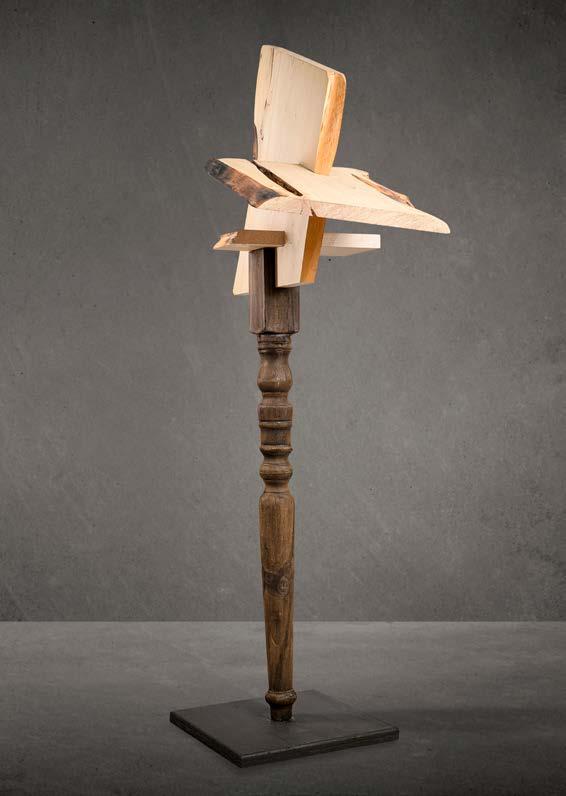 De la serie “ En una Pata” , 2023, ensambles de madera, 170 x 80 x 70 cm. apróx. Foto: Alfonso Yunge.
De la serie “ En una Pata” , 2023, ensambles de madera, 170 x 80 x 70 cm. apróx. Foto: Alfonso Yunge.
¡¡¡¡¿¿¿¿ Quién puso la mesa !!!!!???? , 2023, collage tridimensional, madera, 70 x 15 x 18 cm. aprox. Foto: Alfonso Yunge.
De la serie
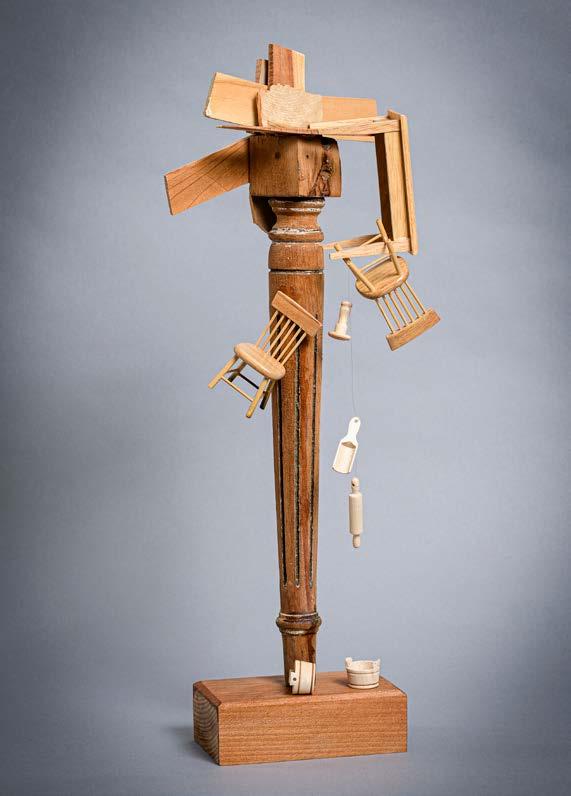
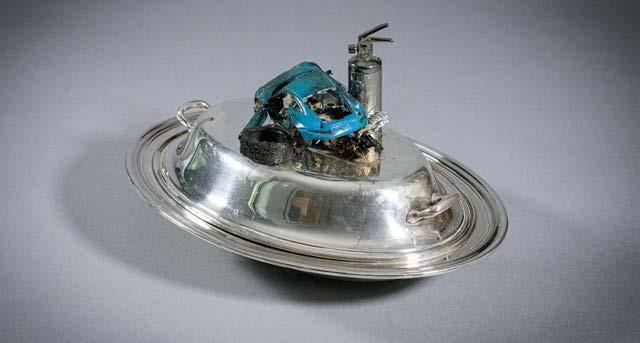
De la serie “ ¿Le gustaría servirse este platito?” , 2023, collage tridimensional, metal plateado, encendedores, madera, juguetes, 20 33 x 30 cm. aprox. Foto: Alfonso Yunge.
y crece por dentro de cada persona. Puede ser física o psicológica y al acumularla es natural que en algún momento la expreses en la intimidad de tu entorno o experimentes una catarsis en lo colectivo.
¿Por qué consideras importante trabajar con la violencia de manera metafórica?
Porque como artista, a través de la escultura y la tridimensión, quiero que pensemos que hay muchas formas de violencia. Que dentro de ella hay apariencias que la intentan “camuflar” como “bromas”, “cuidados”, “cariños”, entre otras maneras. Es una gran ironía y la uso en muchas de las obras de esta serie. La exposición se llama Peligro inminente, la serie de tablas de queso y fuentes de plaqué se llama “¿Le gustaría servirse este platito?”, porque, ¿te comerías esas escenas? ¿por qué no? A través de mis obras podrás pensar por qué no te las comerías y qué responsabilidad puedes tener frente a estas situaciones. Las escenas de mesas en plena caída sobre una pata de mesa o silla, se llama “!!!!????Quién puso la mesa ????!!!!” Porque todo está mal y nadie se hace cargo. Todo se cae y todos miramos sin hacer nada. La violencia no soluciona los problemas, solo te quiebra en mil pedazos y puedes encontrar esos pedazos que quedan de ti, puedes intentar pegarlos pero nunca quedarás igual. Y me refiero a las consecuencias que provocan en nosotros todos los tipos de violencia.
¿Hay una perspectiva feminista en tu trabajo?
El feminismo sin ideología política. Feminista por el hecho de ser mujer y sentir que todavía dentro de la sociedad somos vulnerables, exigidas y pasadas a llevar siendo nosotras las que generalmente seguimos tra-
causes is deep and grows within each person. It can be physical or psychological and when we kept it in, it is only natural that it comes out and that we express it in the intimacy of our surroundings or we experience a catharsis in a collective space.
Why do you think it is important to work with violence metaphorically?
Because as an artist, through sculpture and three-dimensions, I want us to understand violence takes on many shapes. That within it, appearances try to “camouflage”, regard it as “jokes”, “caring” or “love”, among other things. It is a huge irony and I use this in many pieces of this series.
The exhibition is called Peligro inminente (Imminent danger). The series of cheese boards and silver platters is entitled “¿Le gustaría servirse este platito?” (Would you like to help yourself to this dish?) because, who would eat those scenes up? Why wouldn’t we? Through my work, people will reflect on why they wouldn’t and what their blame might be in those situations. The scenes of tables mid-fall on a table leg or chair are called “!!!!????Quién puso la mesa ????!!!!” (Who set the table!!!??), as everything is wrong and no one takes any responsibility. As things collapse, we just watch and do nothing. Violence does not solve issues, they just shatter you to pieces and, although you can try to put them back together, you will never be the same. With this, I’m talking about the consequences of all kinds of violence.
Is there a feminist perspective in your work?
Feminism but without a political ideology. It is feminist due to the fact that I’m a woman and I still feel that we are vulnerable, sanctioned and overlooked in society. This while we
De la serie “ ¿Le gustaría servisrse este platito?”, 2023, collage tridimensional, metal plateado, encendedores, madera, juguetes, 20 33 x 30 cm. aprox. Foto: Alfonso Yunge.
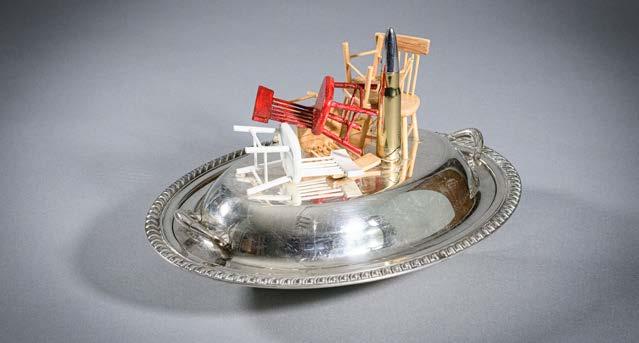
bajando dentro y fuera de la casa. Con menores sueldos, por ejemplo; o teniendo que dejar el trabajo porque por ser mujer eres quien tiene que cuidar al enfermo/a o al anciano/a de la familia. Eso es abuso y el abuso es violencia.
En estas microescenas que planteas a través de las esculturas-collage, se lee una referencia al trabajo de Liliana Porter, ¿cómo ves este diálogo?
La verdad es que si me llevas a un paralelo entre nuestros trabajos, claramente hay similitudes. Llevar situaciones cotidianas a lugares insólitos. No tengo interés en la proporción, en la escala real; hay interés en la intensidad de la escena. Ella usa el mismo recurso. Trabajo con el humor y la ironía para dar énfasis a lo que quiero decir. Todo eso en los collages tridimensionales, porque en las esculturas de madera no hay humor ni ironía, hay una preocupación escultórica solamente, que hace notar la inestabilidad que provoca la violencia.
¿De qué manera esta obra dialoga con tus trabajos anteriores?
Dialoga desde el punto de vista de la metodología de investigación, de la observación. Tu sabes que yo disfruto el proceso y en cada caso son diferentes materiales y técnicas que se van adecuando a lo que quiero decir. Que dan forma al respaldo teórico de lo que muestro. En ese sentido el cuerpo de obra ha sido siempre diferente y, en este caso, además agregué una buena cuota de ironía, porque la violencia tiene ese tono festivo; pareciera ser que quien la ejerce la disfruta y hace que la violencia sea exponencialmente aún más fuerte.
continue working within and outside the home, with lower salaries, or we are forced to quit work, as women are the one who take care of sick and old family members. That is abuse and abuse is violence.
In these micro-scenes you present through sculpture-collages, there is a reference to Liliana Porter’s work. How do you regard this connection? In truth, if you try to draw parallels between our work, there are certainly similarities, like extrapolating daily situations to unusual places. I have no interest in proportion or real scales; I’m more interested in the intensity of the scene. She uses the same resource. I work with humor and irony to highlight what I want to say. To do so, I use three-dimensional collages, because there is no humor or irony in wooden sculptures. There is only a sculptural concern, which highlights the instability caused by violence.
How do these pieces relate to your prior artwork?
In the sense that their research methodology and observation phase are the same. You know that I enjoy the process and materials and techniques vary to adjust to what I want to convey. These shape the theoretical framework of what I exhibit.
Therefore, this body of work has always been different and, particularly in this case, I added a good modicum of irony since violence has a festive tone, it seems that the people that exert violence enjoy it, and this makes the violence exponentially more powerful.
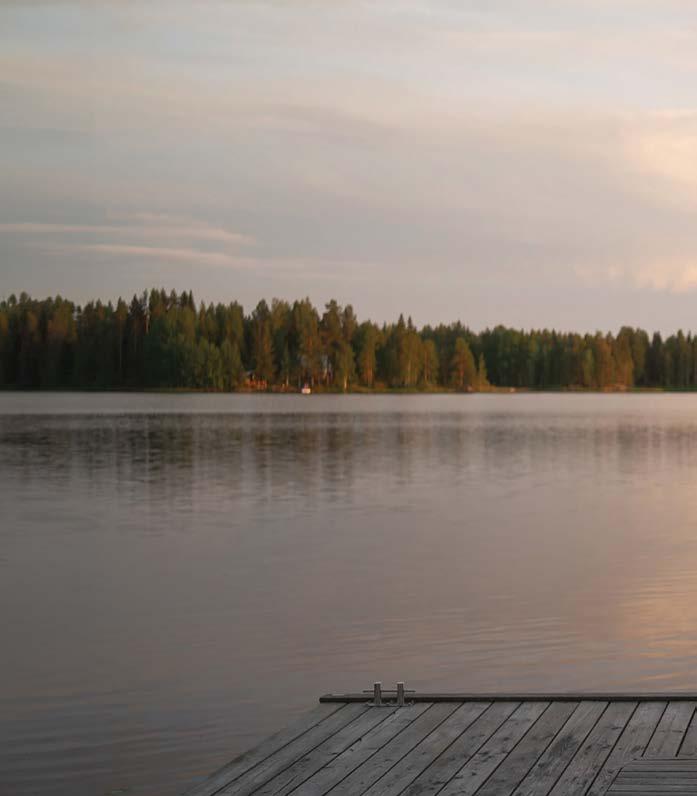
Argentina
Por Ricardo Rojas Behm. Escritor y Crítico (Chile) Imágenes cortesía del artista. Representado por Building Bridges Art Exchange.
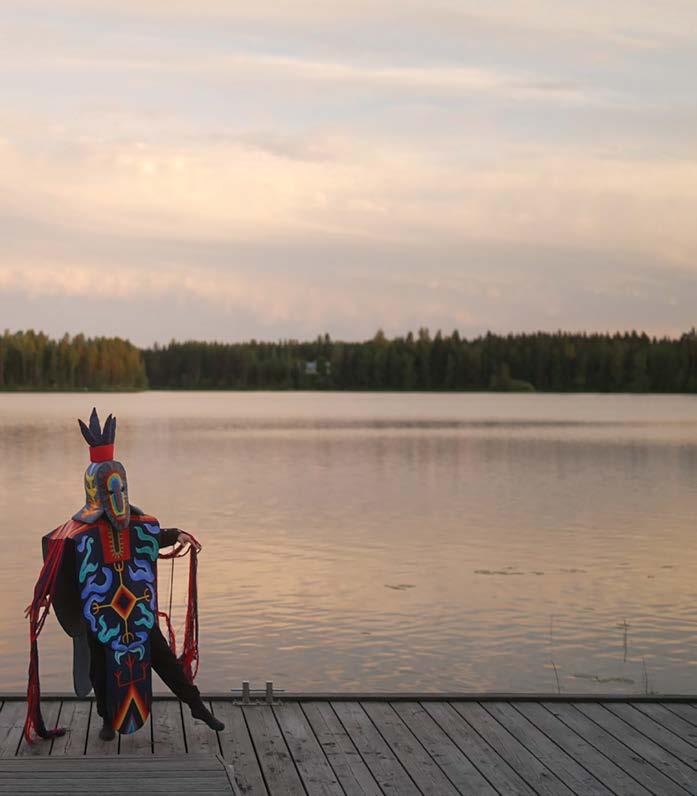 The Noaide, 2023, performance y video con traje realizado en tela y lana, Serlachius Museum, Finlandia. Foto: UTUH Studio.
The Noaide, 2023, performance y video con traje realizado en tela y lana, Serlachius Museum, Finlandia. Foto: UTUH Studio.
tal como afirma Byuing-Chul Han: “La crisis existencial de la modernidad, como crisis de la narración, se debe a que ambas van cada uno por su lado”. No obstante, en el artista visual Tadeo Muleiro, que vive y trabaja en Buenos Aires, ese escollo no es del todo insalvable, dado que ha sabido articular un lenguaje en cuya fenomenología se inscribe una narración visual surgida del inconsciente, cobijado por una técnica llamada in media res, que permite que la trama de la historia se revele mediante recuerdos y escenas retrospectivas.
Lo sorprendente es que rara vez nos encontramos con un artista con capacidad para amalgamar los saberes de una espiritualidad ancestral con la cultura mainstream. Y no deja de ser estimulante que, si bien experimenta con la óptica del chamán o del hechicero, también puede ser simplemente Tadeo. En ese contexto, cada escena da para pensar, ya que vemos cómo las fronteras se desvanecen, producto de un rito ceremonial que es un acto de reparación y recogimiento, con el cual Muleiro devela las fisuras de los pueblos originarios.
Estos agrietamientos terminan en una singular representación, la cual supone despojarse de la subjetividad, no así de ciertos referentes autobiográficos, lo que se afianza a través del simbolismo histórico, con los que se enfrenta a: “la institucionalidad de lo real”. Así, lo atávico se mezcla con lo vernáculo, retomando los vínculos con el imaginario de diversas culturas ancestrales, con ecos venidos del norte argentino y Latinoamérica, como en el video La Salamanquera, imprimiéndole una perspectiva más contemporánea a la leyenda de la Salamanca del norte y sur de Argentina. Además, recurre a referentes de Asia y África e incluso de su imaginario más interno -entre y más allá de lo que se pueda expresar con palabras- evocando relatos mitológicos sudamericanos contados por su padre (también escultor), muchos remitidos a su infancia, con trajes de monstruos creados por su madre, quien además le enseñó a coser. Criaturas invocadas y emuladas como inolvidables seres, encarnados en grandes piezas escultóricas textiles, donde tanto el molde, el hilván y la costura es realizada por el mismísimo Muleiro.
as Byung-Chul Han states: “Modernity’s existential crisis –a crisis of narration– is caused by the splitting of life and narrative.” However, for visual artist Tadeo Muleiro, born and based in Buenos Aires, this obstacle is not entirely insurmountable. He has been able to articulate a language whose phenomenology contains a visual narrative that stems from the subconscious, using a technique called in media res, which allows the plot of the story to unfold through memories and retrospective scenes.
The surprising thing is we can rarely find an artist who can manage to combine the knowledge of ancestral spirituality with mainstream culture. What is even more stimulating is that, although he experiments with the point of view of shamans and sorcerers, he can also just simply be Tadeo. In this context, every scene makes us think as we witness frontiers vanish following a ceremonial rite that serves as an act of reparation and remembrance with which Muleiro reveals the cracks in native peoples.
These fissures end up composing a unique representation that involves shedding subjectivity, but not all autobiographical aspects, strengthened through historical symbolism to confront: “the institutionalization of reality.” Thus, the atavistic merges with the vernacular, revisiting connections with the imagery of various ancestral cultures, with echoes coming from the north of Argentina and Latin America. Such is the case of the video La Salamanquera, which imbues the legend of La Salamanca in northern and southern Argentina. He also turns to references in Asia and Africa, as well as his innermost personal imagery –beyond what words can express–, to evoke South American mythological stories his father told him (also a sculptor) during his childhood, dressed in monster costumes made by his mother, who taught him how to sew. These creatures are summoned and emulated as unforgettable beings, incarnated in large textile sculptural pieces, where both the mold, the thread and the sewing are done by Muleiro himself.

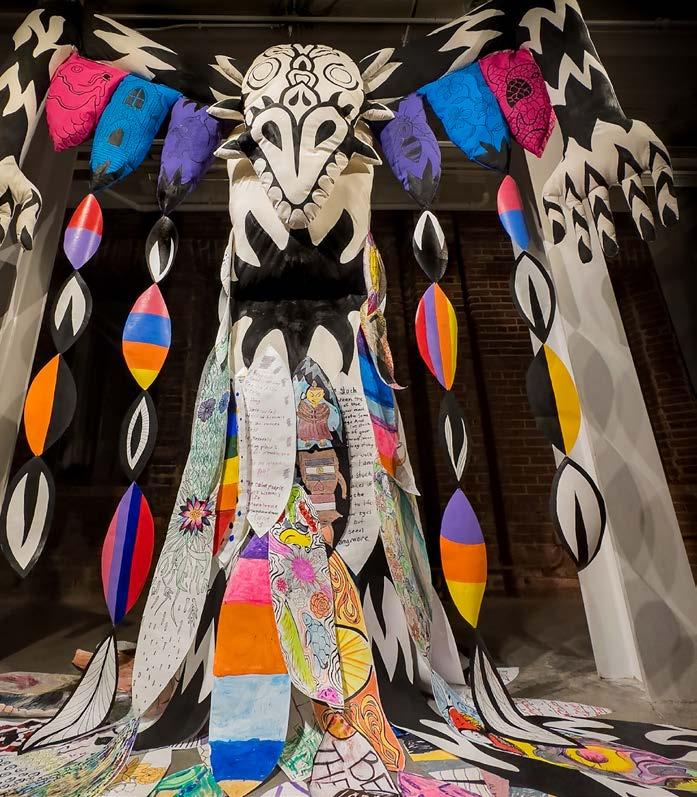 Collective Tótem , 2023, pintura sobre escultura textil y piezas de papel entelado intervenidas por la comunidad de Charlotte NC,
500 x 250 x 150 cm.
MCCOLL Center, EE.UU.
Foto: Tadeo Muleiro.
Collective Tótem , 2023, pintura sobre escultura textil y piezas de papel entelado intervenidas por la comunidad de Charlotte NC,
500 x 250 x 150 cm.
MCCOLL Center, EE.UU.
Foto: Tadeo Muleiro.
Vertientes multidisciplinares, a través de las cuales alimenta sus propios mitos, los que como es lógico, devienen en un rito que supera la malignidad, no así una ferocidad determinada por una “insurgencia cromática”, que desde ya lo hacen ver no sólo ungido de misterio, sino también de exuberancias que están en constante transformación. Tal como describe en La eficacia del arte José Luis Tuñón: “Aquellos rostros fieros del terror se convierten, entonces, en una mezcla rara - como corresponde al arte - de juguete y vestido disponible. No es difícil proyectarse en ellos y arroparse en la amable compañía de unas serpientes milenarias. Podemos estar seguros de evocar el asombro de lo sagrado ante la vista de estas criaturas, pero también de que allí hay lugar para nosotros y nada puede hacernos daño”.
Pero no todo es inocuo, y Tadeo Muleiro lo experimentó cuando su padre fue asesinado en 2014; luego de esto vino un incendio que lo llevó a realizar la obra El Padre, donde asume la pérdida y el duelo, vistiendo un traje cubierto de espejos, con el que deambula largamente sobre los cimientos del hogar convertido en cenizas. Una foto familiar y un conjunto de piezas escultóricas realizadas por su padre son los justos testigos que cierran este rito fúnebre, y que lo conectan intrínsecamente con otras obras que también abordan su faceta más emotiva, como Papá y mamá, El hijo, La casita, Los hermanos, El abuelo
Aunque sus propuestas artísticas lo hacen ver como el portavoz de una historia inconclusa entre lo ancestral y lo real, lo vemos agregar colorido a una opaca vida citadina, presa de su obsecuente pasividad, propiciando el desborde con todo un despliegue de simbolismos y una sensación atemporal, sustentada en una práctica revestida de una insurgencia conceptual que va de la provocación a la reflexión, y en cuya dialéctica subyacen una serie de vibrantes acciones: con videos y performance donde el traje es una escultura habitual-habitable que lo eleva a la categoría de performer, permitiéndole encarnar un atuendo con el que devela distintas historias que unen el pasado más primigenio con su universo autobiográfico, y donde cada personaje de este ámbito mitológico construye nuevas alteridades y alegorías que se constatan en sus últimos proyectos del 2023 como
He nurtures his own myths with multi-disciplinary sources which, as is logical, become a rite that overcomes evil, but not the ferocity resulting from a “chromatic insurgence” that makes it appear not only anointed with mystery, but also with exuberances that are in constant transformation. As José Luis Tuñón described in La eficacia del arte: “Those fierce faces of terror become, then, a rare mixture - as befits art - a toy and available costume. It is not difficult to project oneself onto them and tuck oneself in the kind company of millenarian snakes. We can be sure to evoke the awe of the sacred at the sight of these creatures, but also that there is room for us there and nothing can harm us.”
However, not everything is harmless. Tadeo Muleiro experienced this when his father was murdered in 2014, followed by a fire that led him to create El Padre (The Father), where he grieves his loss dress in a mirror-covered garment and long roams among the foundations of his home turned to ashes. A family picture and a set of sculptured made by his father are the only witnesses to this mournful ritual, also connecting it intrinsically with other pieces that address his most emotional side such as Papá y mamá, El hijo, La casita, Los hermanos, and El abuelo.
Even though his art proposals make him the spokesperson of an unfinished story between the ancestral and real, the artist adds color to the opaqueness of city life, a prisoner of its obedient passivity. This leads to an overflow with a whole array of symbolism and a timeless nature, sustained by a conceptually insurgent practice ranging from provocation to reflection. Underlying his dialectic is a series of vibrant actions: videos and performances in which costumes are inhabitable sculptures that elevate him to the category of performer, allowing him to incarnate an outfit that unveils different stories, merging the most primitive past with his autobiographical universe. In these mythological environments, he builds new allegories and feelings of otherness. This can be seen in

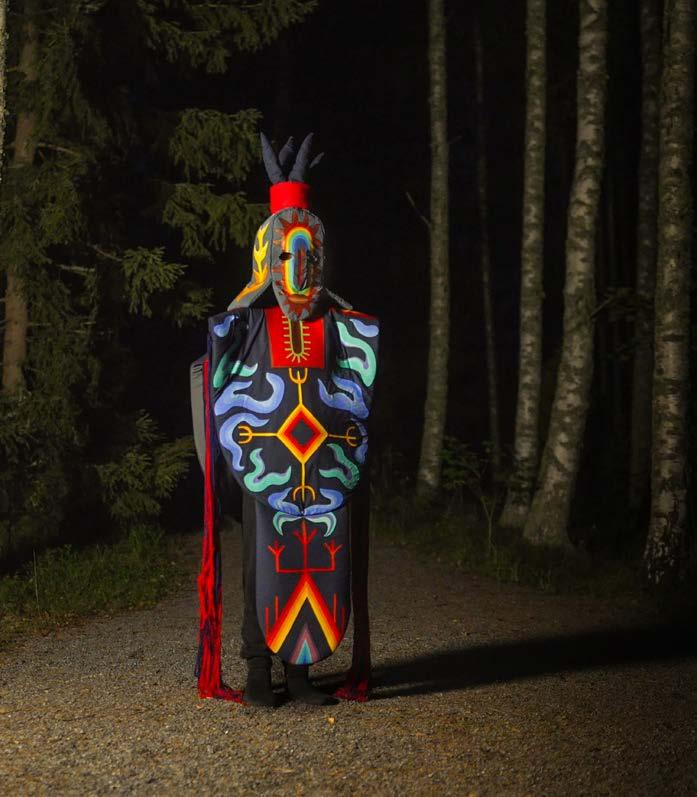 The Noaide, 2023, performance y video con traje realizado en tela y lana, Serlachius Museum, Finlandia.
Foto: UTUH Studio.
The Noaide, 2023, performance y video con traje realizado en tela y lana, Serlachius Museum, Finlandia.
Foto: UTUH Studio.
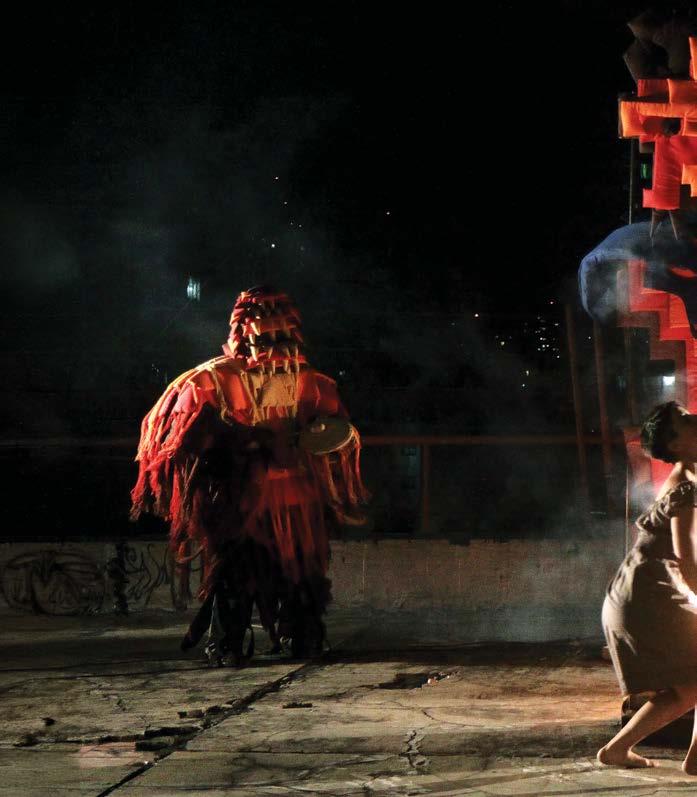
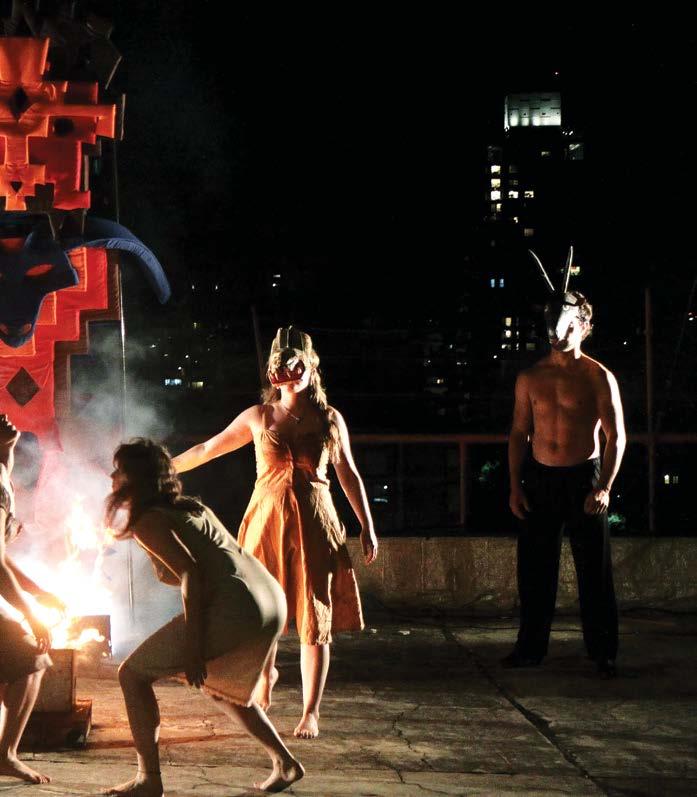 La Salamanquera, 2014, video, 07:01 min, Argentina.
Foto: Martina Matusevich.
La Salamanquera, 2014, video, 07:01 min, Argentina.
Foto: Martina Matusevich.
Animus & Anima, representando las formas arquetípicas de lo femenino y lo masculino que conviven dentro nuestro; The Noaide, con un traje que hace referencia a la vestimenta Sami, pueblo originario nórdico, y Collective Tótem, El Thunderbird o Pájaro de Trueno, representando los tótem realizados por nativos norteamericanos.
Todos, referentes de gran potencia, y que lo conectan a través de una monumentalidad textil revestida de significados, vez que se convierte en un espíritu indígena, el cual irrumpe en la ciudad para manifestarse frente a la estatua de Julio Argentino Roca, el principal artífice de la campaña de exterminio y usurpación de las tierras de los pueblos originarios argentinos. Un vívido ejemplo de cómo este artista ocupa la raigambre prehispánica y una serie de sincretismos para no sólo sentirse un poseedor de una plusvalía que le da licencia para retrotraer una narración tan plural como Latinoamérica, sino para sentirse un testigo más, víctima de esta cultura antropofágica que suele naturalizar el sacrificio, hecho que remarca el propio Muleiro - “Para el pensador francés Georges Bataille el acto sacrificial no es matar, sino abandonar y dar. Supone salir de un mundo de cosas reales y devolverlas a una inmanencia sagrada, transgrediendo los límites y las prohibiciones establecidas. Los chamanes han funcionado y siguen haciéndolo como los mediadores entre mundos, navegan entre el universo mítico y el universo profano, salen de los límites dados y conectan este plano real con otras realidades. Me gusta pensar estas ideas en la actualidad como una posible abertura, una posibilidad de transgresión al orden lógico de las cosas en una vida contemporánea cada vez más opaca”.
A fin de cuentas la luminosidad y la lobreguez son sus componentes esenciales, y se supedita a esos fantasmas, lo que quizás parezca pintoresco, porque su arte, en gran medida, es consecuencia de una inevitable apropiación cultural, remitiéndolo a un territorio donde, cual paradoja, el realismo mágico se presenta en multiplicidad de formas por el simple hecho de ser parte de nuestra epidermis, y Muleiro lo demuestra siendo un artista profundamente argentino, pero también entrañablemente Latinoamericano e incuestionablemente universal.
his latest projects in 2023 such as Animus & Anima, representing the archetypal forms of the feminine and masculine that coexist within us; The Noaide, with a costume alluding to Sámi clothing, a Nordic native people; and Collective Totem, Thunderbird, representing Native American totems.
All these powerful pieces, threaded with monumental textiles brimming with meaning, connect him with and allow him to become a indigenous spirit, the same one that bursts into the city to face the statue of Julio Argentino Roca, the main architect of the extermination campaign and usurpation of the lands of Argentina’s native peoples. This vividly exemplifies how this artist uses pre-Hispanic roots and a series of syncretisms to feel like a holder of such value that it gives him license to retrace a narrative as diverse as Latin American culture. Conversely, this also makes him feel like one more witness, a victim of this cannibalism culture that tends to normalize sacrifice. In fact, Muleiro himself states: “For the French thinker Georges Bataille, sacrificial acts are not killing, but abandoning and giving. This involves stepping out from the realm of real things and restoring them to their sacred immanence, transgressing established limits and prohibitions. Shamans have served, and continue to do so, as mediators between worlds. They navigate between the mythical and profane universes; they transgress given limits and connect this plane of reality to others. I like to think of these ideas today as a possible window, an opportunity to transgress the logical order of things in an increasingly opaque contemporary life.”
In the end, brightness and darkness are his essential components. He subjects to these ghosts, which might seem picturesque, but he does it since his art is largely the product of an inevitable cultural appropriation. Paradoxically, this lands him on a territory where magical realism is present in a multitude of ways due to the simple fact that it is part of our DNA, which Muleiro proves as a profoundly Argentinian artist, but also deeply Latin American, and undoubtedly universal.

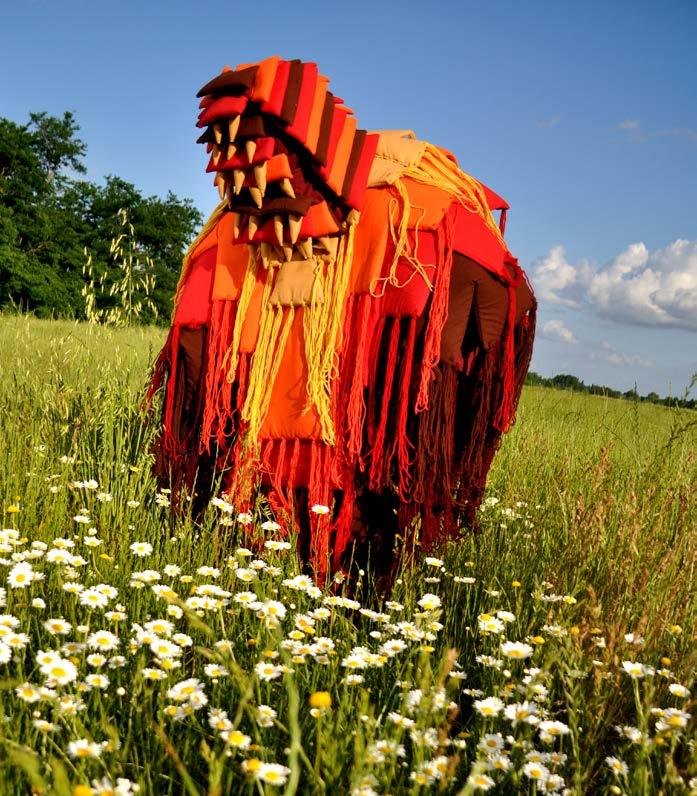 El Abuelo, 2012, video, 05:13 min, Argentina.
Foto: Martina Matusevich.
El Abuelo, 2012, video, 05:13 min, Argentina.
Foto: Martina Matusevich.
Por Javiera Fernández. Periodista (Chile) Imágenes cortesía del artista.
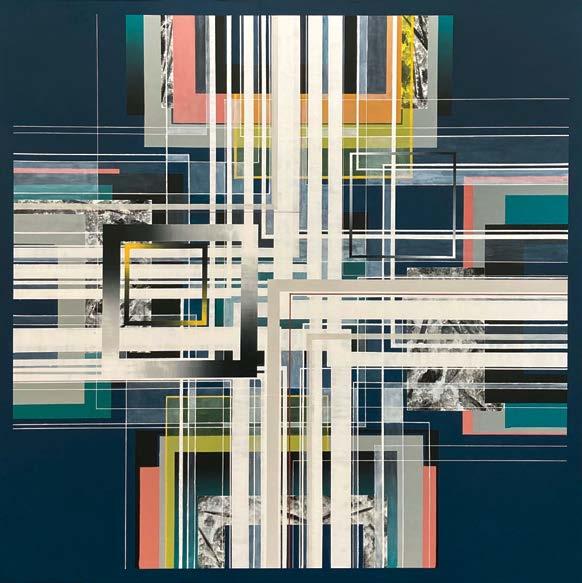 C.137.23 , 2023, acrílico sobre tela, 120 x 120 cm.
C.137.23 , 2023, acrílico sobre tela, 120 x 120 cm.
frente a frente con el lienzo en blanco, el mundo de Jairo Robinson va apareciendo de a poco, con gestos pictóricos que no necesitan premeditaciones. Más bien, son un cruce de trazos geométricos y colores superpuestos que develan la interioridad de su autor, su cosmos sensible. Se trata, explica él, del acto más rebelde que ha efectuado como artista, remontado a sus estudios de pintura en la Escuela de Bellas Artes de Lima, donde decidió liberarse de las representaciones realistas, en ese momento aún canónicas dentro del panorama pictórico nacional, para iniciar un camino sin retorno a la abstracción geométrica.
Desde aquel entonces, presentando muestras individuales y colectivas en diversas instituciones culturales y galerías de Perú; en certámenes como la Bienal Internacional de Muralismo y Arte Público en Colombia y la Bienal Latinoamericana de Muralismo en Argentina, Jairo Robinson revela, a través de un total geometrismo abstracto, los periplos que conforman su atmósfera interior, colmada de cavilaciones y pensamientos que se manifiestan a medida que mueve el pincel. Como si fueran un conjunto de sentires y memorias autobiográficas amalgamados en un especie de laberinto, a veces los colores y trazos son gruesos, enmarañados y cálidos, y en otros momentos son más apacibles y pequeños. En ese ejercicio, ninguna pincelada es explícita ni figurativa, sino que sugiere un gesto emanado desde la intimidad del autor para mostrar la complejidad de la vida humana, en constante desciframiento. Luego, ya acabado el cuadro, pasa a ser observado por otro que lo interpreta, acorde a su propia vida interior y experiencia de mundo.
“La tesis visual de la pintura se desarrolla dentro del cuadro. Entre sus cuatro lados se da ese misterio que podríamos llamar arte. Solo la mirada sin prejuicios podría decodificar esa tesis”, expresa Robinson. Por eso, cuando comienza a pintar, se sitúa en su propia sensibilidad corporal y psíquica, y afianza un relato expansivo al interior del lienzo. “Son las sensaciones, lo que el entorno emana, geográficamente hablando y hasta humanamente. Mi verdad es una maraña de sensaciones que trato de plasmar. Busco traducir lo que pasa por mi retina y lo que se somete a los juicios de mi mente”.
¿Te hace sentido la idea de pintar como un ejercicio de confrontación personal y develamiento del mundo interior?
El conflicto de ese develamiento siempre estuvo allí, únicamente no era consciente de ello. Con el tiempo uno comprende mejor y aprende a lidiar con la manipulación de la imagen, yo creo que todo esto se dio de manera natural con el pasar de los años.
Pienso que la pintura, al ser una tesis absoluta, sin necesidad de traducciones verbales, encierra dentro de sí todo ese diálogo de la exteriorización del mundo interno del creador, ese mundo que es fruto de la confrontación con el exterior. Al fin y al cabo todos somos hijos de una época y como tales no podemos ocultarnos y evitar su influencia.
La pintura se vuelve mi verdad, una verdad que me muestra también como ser humano.
face-to-face with a blank canvass, Jairo Robinson’s world unveils little by little, in pictorial gestures that need no premeditation. These are rather intersections of geometric lines and juxtaposed colors that reveal the author’s inner world, his sensitive cosmos. As he explains, these gestures are the most rebellious act he has performed as an artist. In his early days studying painting at the Fine Arts School in Lima, he decided to free himself from realist representations –at that time still canonical within the national pictorial scene– to embark on a one-way journey into geometrical abstraction.
Since then, his work has been featured in solo and collective samples in several cultural institutions and galleries across Peru, as well as participated in competitions in the International Mural and Public Art Biennial in Colombia and the Latin American Mural Art Biennial in Argentina. Through geometric abstraction, Jairo’s work reveals the voyage into his inner atmosphere, brimming with pondering and thoughts that manifest as he moves his brush. As if autobiographical memories and feelings merged in a sort of labyrinth, sometimes the colors and lines are thick, tangled and warm, and others they are calmer and smaller. In this exercise, no brush stroke is explicit or figurative. Instead, these gestures stem from the author’s inner world to showcase the complexity of human life, under constant deciphering. Once a painting is completed, viewers come to interpret them depending on their own inner worlds and life experiences.
“The painting’s visual thesis develops within the canvas. Amid its four edges lies that mystery that we could call art. Only non-prejudicial eyes could decipher that thesis,” Robinson states. Due to this, when he starts painting, he inhabits his own bodily and mental sensitivity and he establishes an expansive narrative inside the canvas. “It is the sensations, what emanates from the surroundings, both geographically and humanly speaking. My truth is a tangled clutter of sensations that I try to convey. I aim to translate what passes by my retina and is subject to the judgments of my mind.”
Does the concept of painting as a personal confrontation and unveiling of the inner world make sense to you?
The struggle of the unveiling was always there, I just did not realize it. In time, we better understand and deal with image manipulation. I think this came to be naturally as years went by.
I think that painting, as an absolute thesis without the need for verbal translations, encompasses all the conversation on the externalization of the inner world of the creator, a world that comes from confronting the exterior. At the end of the day, we are all the product of an era and, as such, we cannot hide from it or its influence.
The painting becomes my truth, a truth that also shows me how to be human.
 C.134.23 , 2023, acrílico sobre tela, 50 x 50 cm.
C.134.23 , 2023, acrílico sobre tela, 50 x 50 cm.
 C.135.23 , 2023, acrílico sobre tela, 100 x 100 cm.
C.135.23 , 2023, acrílico sobre tela, 100 x 100 cm.
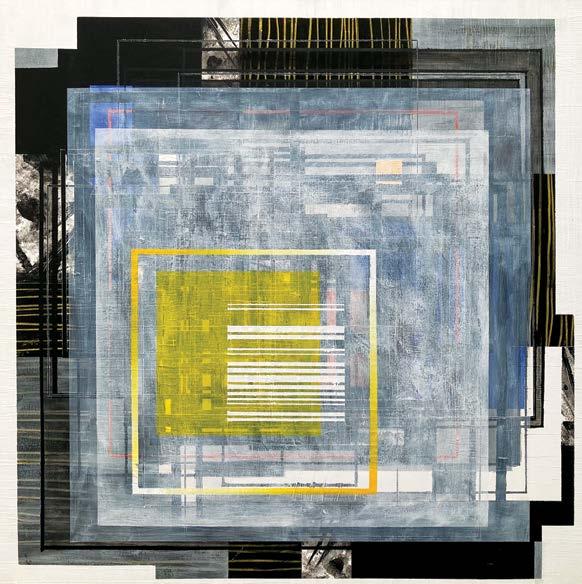 C.139.23 , 2023, acrílico sobre papel, 48 x 48 cm.
C.139.23 , 2023, acrílico sobre papel, 48 x 48 cm.
La ciudad, o su alusión a esta, es un elemento que la audiencia ha distinguido particularmente en tus obras. En ellas pareciera verse una alusión a ese caos, ese ruido e intermitencia propia de las grandes urbes. ¿Qué aparece en ti si piensas en la ciudad? Es bueno conocer las interpretaciones que le dan a mi obra las diversas personas que se confrontan a ella, a veces me ayudan a descubrir historias que no habían pasado por mi cabeza. Son sensaciones y/o visualizaciones de las cuales no se puede escapar ya que de una u otra manera evidenciamos lo que nos rodea, el entorno en el que coexistimos.
Dicho esto, quisiera poner un límite con el discurso representativo del arte como mímesis de la naturaleza. Al no ser figurativo no doy pistas sobre lo que el espectador ve. Como es natural en el ser humano, se tiende a buscar un punto de apoyo y se termina en una relación de la imagen con algo próximo que conocemos. Con respecto a la mención de las grandes ciudades, no descarto que al ser confrontado a éstas, terminen influyéndome como un todo estético. Como una especie de gran tapiz geométrico. Esto lo digo como habitante de una ciudad caótica, Lima; y también como un asiduo visitante de las grandes ciudades alrededor del mundo. Siempre es la gran ciudad la que con su vitalidad termina influyendo en mi pensamiento. Ahora que lo pienso, privilegio a las ciudades por sobre la naturaleza. Tal vez encuentro belleza en las líneas rectas que se proyectan al cielo y ocultan toda la putrefacción que se puede generar dentro de su imperfecto desarrollo.
El color en tu obra y sus superposiciones parecieran reflejar una multiplicidad de propósitos: una emoción, una pregunta, un estar en el mundo. ¿Cómo te vinculas con los colores durante tu proceso creativo? El color es un detonante dentro de mi obra. Cuando inicio una pintura y voy generando unas manchas y chorreaduras violentas en el plano, éstas van impregnadas de un color en particular. Esa es la primera decisión tomada: el color del punto de partida. De ahí se van generando los primeros planos superpuestos a este caos. Son los pasos más delicados, pues ahí se manifiesta el futuro de la obra, de esa toma de decisiones cromáticas y formales. El color es portador de sensaciones y como tal me termina acompañando por diversos periodos. Por un tiempo todo se oscurece y llega al insondable negro y otro periodo llega a la brillantez de los fondos claros y traslúcidos. En estos cambios atmosféricos se debaten mis núcleos cromáticos que terminan a su vez siendo seccionados por densas redes negras o blancas. Es el filo del no color el que termina ordenando todo y lo lleva al orden deseado.
Lógicamente, con todo esto en mente, es inevitable “pensar en color” y esto es un fenómeno real en el que hay días en los que no visualizo un determinado color como necesidad. De ahí que hay momentos en que el azul es un refugio absoluto y otros en los que el amarillo se despliega con toda su neurótica potencia. Así los días pasan y cada uno porta un color diferente.
Cities, or allusion to them, are elements that the public has noticed in your work. There seems to be a reference to the chaos, noise and intermittence that distinguishes great cities in your work. What comes to mind when you think of cities?
It is good to learn the interpretations given to my work by the different people who are confronted with it, sometimes they help me to discover stories that had not crossed my mind. These are sensations or views we cannot escape from because, one way or the other, they evince what surrounds us, the environment where we coexist.
Having said this, I would like to draw a limit with the representational rhetoric of art as a mimesis of nature. As a non-figurative artist, I do not provide viewers with any clues on what they see. As it is human nature, we tend to seek some sort of reference and end up relating the image to something near and familiar to us. In regard to large cities, I do not rule out that, since I am exposed to them, they end up influencing me aesthetically as a whole, as a sort of large geometric tapestry. I say this as an inhabitant of a chaotic city, Lima; and also as a regular visitor to large cities around the world. Ultimately, big cities and their vitality always influence my thoughts. Now that I think about it, I prioritize cities over nature. Perhaps I find beauty in their straight lines that rise to the sky and hide all the putrefaction that can be generated within their imperfect development.
In your work, color and overlapping colors seem to convey multiple elements: an emotion, a question, a sense of being in the world. How do you deal with colors during your creative process?
Color is what kick-starts my work. When I begin a painting and I create violent splotches and drips on the canvas, these are soaked in a particular color. That is the first decision that I make: the starting color. From there, I create the first overlapped planes in this chaos. These are the most sensitive steps because the hold the future of the piece, of the color and formal choices.
Color is a conveyor of sensations and, as such, it ends up staying with me for different periods of time. For a while everything becomes darker and reaches an endless black, and another period reaches the brightness of light and translucent backdrops. The core of my colors is debated in these atmosphere changes and they are ultimately segmented by dense black or white networks. It is the edge of non-color that ends up arranging everything and brings it to the desired order.
Logically, bearing all this in mind, it is inevitable to “think in color.” This is a real phenomenon; there are days where I cannot picture a given color as a necessity. Hence, sometimes blue constitutes an absolute shelter and other times it is yellow that unfolds with its full neurotic power. This way, days go by and each wears a different color.
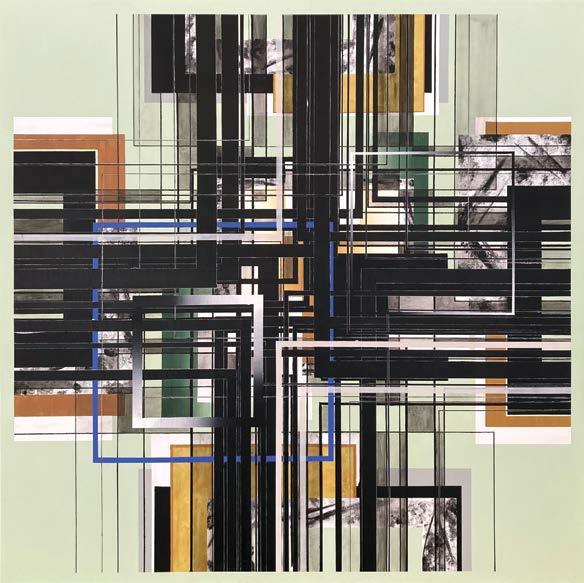 C.136.23 , 2023, acrílico sobre tela, 120 x 120 cm.
C.136.23 , 2023, acrílico sobre tela, 120 x 120 cm.
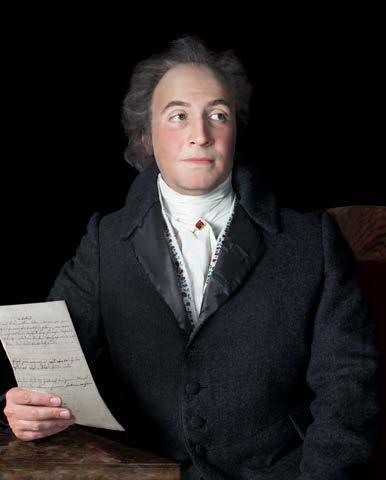
christian.fuchs.artist
mail: christianh.fuchs@gmail.com
Exposición 13 de Julio 2024
Galerie PJ, 10 Rue des Jardins, Metz, France
Johann Wolfgang von Goethe, autoretrato fotográfico impreso en papel de algodón.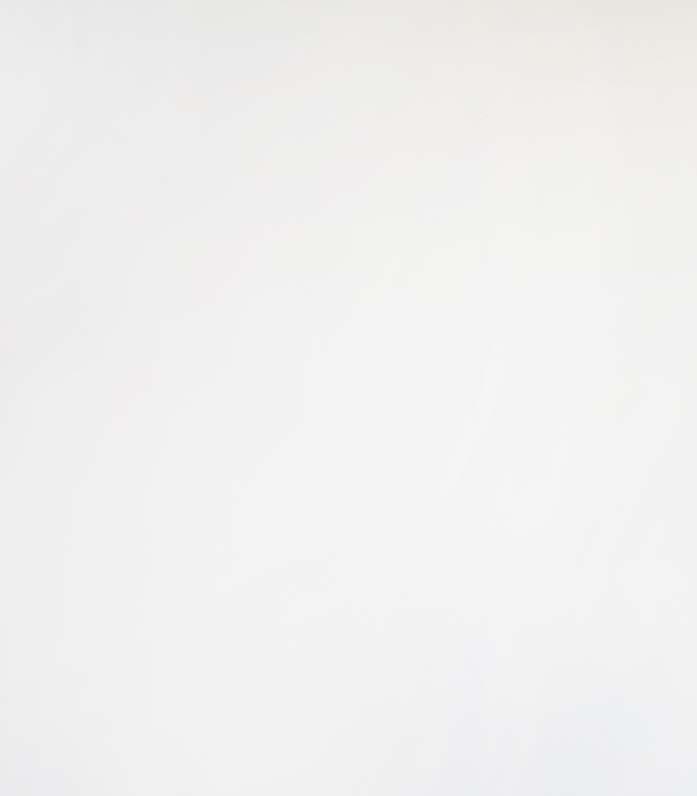
Por Ricardo Rojas Behm. Escritor y Crítico (Chile) Imágenes cortesía de la artista.
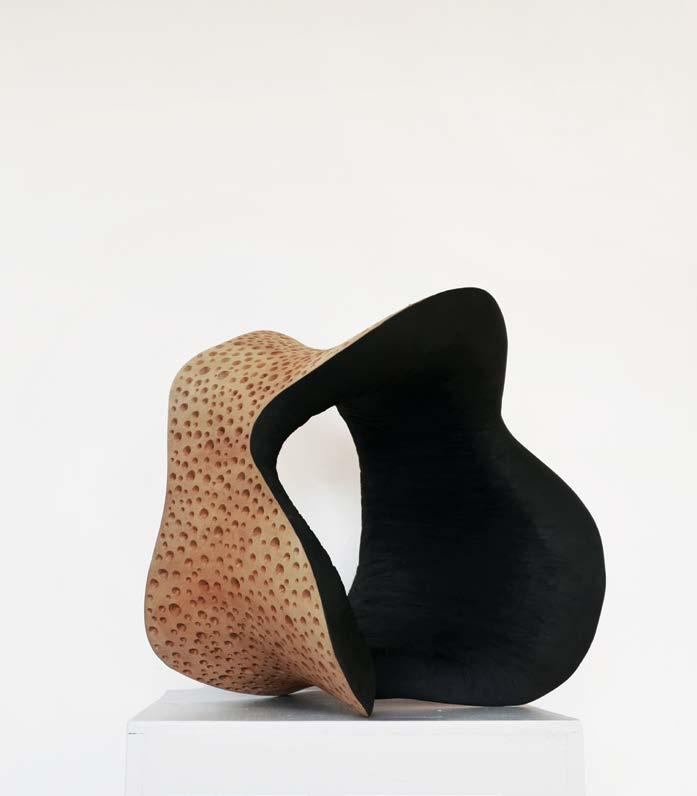 Anillo solar, 2021, madera de roble, 37 x 40 x 31 cm.
Anillo solar, 2021, madera de roble, 37 x 40 x 31 cm.
More than a sculptor, a
uizás el cotidiano de nuestra existencia ha mermado significativamente esa capacidad para observar un paisaje que en gran medida pasamos por alto, no porque haya desaparecido, sino porque somos esclavos de esa desmedida competitividad y creemos que la naturaleza está exenta, pero no es así. Porque su adyacente cercanía depende de cómo la integramos, hecho que se hace palpable en Sandra Santander, artista visual y escultora que, en su amplia trayectoria, por el sólo hecho de disponerse a observar, ha descubierto un espacio inagotable que va desde la frondosidad de un bosque al rescate de lo derruido. Labor que realiza desde que se formó en la región del Bíobío, entorno que la dotó de un particular sentido a su obra. “Es una región muy rica en recursos naturales, generosa en paisajes de cordillera a mar. Aquí nací, aquí me formé como escultora, aquí he desarrollado mi trabajo muy conectado con mi entorno. Todo lo que hago parte de esa conexión muy profunda que tengo y mantengo con la tierra, con el paisaje, con mi territorio de origen”.
Dejando de lado lo estrictamente académico, ¿qué otros estímulos fuera de la naturaleza endémica determinaron tu quehacer artístico? por ejemplo, artistas chilenos o extranjeros. Indudablemente que recibo influencias de muchos artistas, en particular de escultores que trabajan la madera, no podría mencionarlos a todos, pero me interesan los que trabajan con el paisaje. Tal vez de manera inconsciente, me siento heredera de muchos escultores que vinieron antes que yo, y como decía Chillida, “de los buenos se aprende lo que hay que hacer y de los otros lo que no”. Nunca se es totalmente original, siempre habrá alguien que trató la madera de la forma que lo hago yo, hay al menos unos 50 escultores que me interesan y sigo en su desarrollo artístico, como Jaume Plensa, Anish Kapoor, Ai Wei Wei, Isamu Noguchi, Hernán Dompé o Sopheap Pich, pero no podría decir que han sido determinantes en mi quehacer escultórico… ¿o tal vez sí?
perhaps the routine of our existence has significantly diminished our ability to appreciate landscapes. We mostly overlook them, not because they have disappeared but because we are slaves to our relentless competitiveness. We believe that nature is exempt from it, but it is not. Closeness to nature depends on how we integrate it. This is evident in Sandra Santander’s work, a visual artist and sculptor. In her long-standing career, from mere observation, she has discovered an inexhaustible space, ranging from dense forests to the rescue of the devastated. This has been the focus of her work since she studied in the Biobío region, an environment that gave her work a specific meaning. “The region is rich in natural resources, generous in its coastal mountain range landscapes. This is where I was born, where I trained as a sculptor, and where I have developed with artwork, which is very linked to my surroundings. Everything I do stems from the profound connection I have and maintain with the earth, with landscapes, with my native land.”
Setting aside the strictly academic, what other stimuli outside endemic nature have shaped your artwork? Any Chilean or foreign artists, for example?
I am undoubtedly influenced by many artists, particularly wood sculptors. I couldn’t mention all of them, but I am mostly interested in artists who work with landscapes. Perhaps unconsciously, I feel I am heir to many sculptors who came before me, and as Chillida used to say “you learn what to do from the good ones, and what not to do from the bad ones”. No one is totally original; there will always be someone who worked with wood the same way I do. There are at least 50 sculptors I admire and whose career I follow: Jaume Plensa, Anish Kapoor, Ai Wei Wei, Isamu Noguchi, Hernán Dompé and Sopheap Pich, but I wouldn’t say they have shaped my work with sculpture... or have they?

 Semilla sueño, 2019, roble, 38 x 48 x 18 cm.
Semilla sueño, 2019, roble, 38 x 48 x 18 cm.
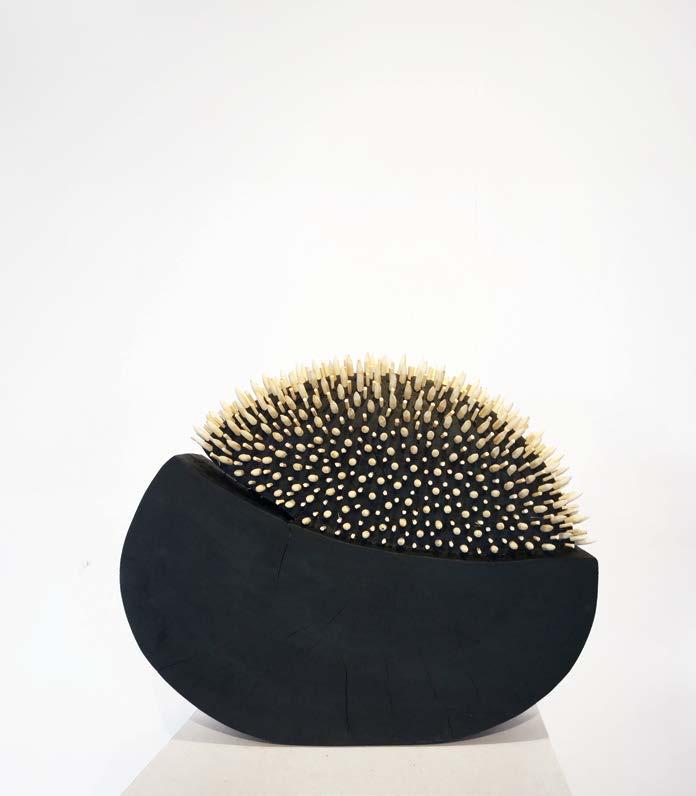 Mamilaria II, 2020, roble, 36 x 42 x 12 cm.
Mamilaria II, 2020, roble, 36 x 42 x 12 cm.
En tu propuesta escultórica, la madera es siempre determinante, pero en ese connatural trasvasije por diversas materialidades, ¿con cuál te identificas más ya sea por su ductilidad, color y textura, o qué otras técnicas incorporarías?
Las materialidades como las dimensiones se establecen de acuerdo a cada proyecto, en el caso de la escultura pública es determinante el tema y el lugar en el que se emplazará la obra, donde operan ciertas condiciones del entorno, como la arquitectura circundante o la distancia que habrá con el observador, por ejemplo. De igual modo el acero estructural y la piedra son los materiales que prefiero. El primero por su ductilidad, es un material que, sin violentarlo, se somete a lo que le pidas, solo necesitas una mano de obra muy especializada para lograrlo; y, el segundo, la piedra, habla por sí misma, es muy corpórea, rotunda y es por lejos el material que mejor traduce el concepto de memoria.
¿De qué manera incide tu propuesta escultórica en el espacio urbano? cuando afirmas que: “El artista es un experto en recuperar la memoria urbana en espacios abiertos. El artista es quien primero debe someterse al contexto”. El arte urbano, sea escultórico o pictórico, está permanentemente sometido al escrutinio público y por lo mismo se debe a un espectador que en este caso es el transeúnte citadino, hoy cada vez más opinante frente a la obra artística que se le impone en su entorno inmediato. De allí la importancia de proponer obras con lenguajes contemporáneos, universales, pero con temas locales, que contengan rasgos identitarios, contextualizados con el medio, sea natural, social o cultural, posibilitando así un proceso de apropiación y pertenencia que se sostenga en el tiempo. Lo óptimo es que la obra le termine perteneciendo a la comunidad, no al artista ni a la autoridad que lo patrocinó.
Ciertamente, la permeabilidad del paisaje es un territorio natural, del cual Sandra Santander se apropia, sin desconocer ese maravilloso semblante que se despliega frente a sus ojos, ya sea urbano o rural, ya que tiene esa capacidad para reconocer y adaptarse al entorno, a tal grado que cuando ve que ese “boscaje” es vulnerado en su precario equilibrio, arremete con un nuevo proyecto escultórico que la revela como una legítima artista que hace del paisaje su leitmotiv, pero dándole siempre un sentido nuevo, el cual se surge desde lo más profundo y con el que ha estado conectada desde su infancia.
In your sculptural work, wood is always a determining factor, but in the innevitable shift to different materials, which one do you identify yourself with most, either for its versatility, color or texture? What other techniques would you incorporate?
Materials, just like dimensions, are selected depending on the project. In the case of public sculptures, the topic and the site are crucial due to considerations about the environmental conditions, surrounding architecture or distance with viewers, for instance. Anyway, steel and stone are the materials I prefer. In the case of the former, it is because of its malleability; steel is a material that submits to whatever you ask from it without violence. Stone speaks for itself; it is very corporeal, emphatic, and it is by far the material that best translates the concept of memory.
You have said: “Artists are expert in recovering urban memory in open spaces. Artists are the first ones who should subject to the context.”
How do your sculptures affect urban spaces?
Urban art, whether it be sculptural or pictorial, is permanently subject to public scrutiny and, thus, it is indebted to viewers, or city passersby in this case, who are more opinionated about artwork imposed on them in their close surroundings. Hence the importance of proposing works with contemporary, universal languages, but with local themes, and identifying features, contextualized with the environment, whether natural, social or cultural, thus enabling a process of appropriation and belonging that can be sustained over time. Ideally, the work should end up belonging to the community, not to the artist or the authority that commissioned it.
Certainly, the permeability of landscapes is a natural territory that Sandra Santander appropriates. She cannot ignore the marvelous sight that unfolds before her eyes, whether urban or rural, since she has the ability to recognize and adapt to the environment. Her connection to nature is such that when she senses that the precarious balance of this “forest” is in danger, she lunges with a new sculpture project that proves she is a legitimate artist who makes landscapes her leitmotiv, but always giving it a new meaning, which arises from the innermost depths, a connection she has had since her childhood.
 Semilla Cascada, 2021, roble y sauce, 39 x 38 x 27 cm.
Semilla Cascada, 2021, roble y sauce, 39 x 38 x 27 cm.
¿Hasta qué punto la sostenibilidad se reconoce en esa paisajista de la escultura que habita en ti?
El artista es también un ciudadano, tal vez más sensible frente a las catástrofes, sean naturales o provocadas por el hombre, en las que los equilibrios de nuestro hábitat quedan extremadamente frágiles. En ese sentido mi obra es una reflexión, desde la escultura y desde la madera, sobre el paisaje y esa naturaleza vulnerada, y en ese proceso de obra puedo agregar que estoy intentado cerrar un ciclo que comenzó hace varios años: la construcción de un paisaje metafórico, como una obra en progreso, cada obra nueva es un elemento más de ese mismo paisaje. Así voy llenando un espacio que a ratos se vuelve infinito. Puede decirse que he realizado una sola obra en estos últimos 20 años.
¿Por qué ese bosque frondoso, ahora ennegrecido, fue el motor para dar forma a esa Canción para mi bosque muerto? Canción para mi bosque muerto es un proyecto escultórico que comienza a configurarse hace unos 8 años y se refiere específicamente a un bosque, particularmente el que conocí de niña en el campo de mi abuela, que fue tristemente violentado por las llamas hace algún tiempo. Siempre pensé que ese bosque era mío, al que regreso cada vez que cierro los ojos, el que he llevado conmigo como una morada espiritual. En esa serie, están también todos los bosques que año a año se vuelven negros sacudidos por el fuego, la negrura entonces se va incorporando de tal manera a nuestro paisaje que ya nos deja de sorprender.
Al momento de concluir este artículo, cito unos versos de “Aves de paso” de la poeta Elvira Hernández: “Sí. Eso somos, pero nos hemos acostumbrado a comportarnos como monumentos y así nos va”. Dado que a menudo se naturalizan realidades, que lamentablemente un gran número de veces terminan en una conducta extractiva, como son la tala o quema de bosques milenarios, pero que artistas de la magnitud de Sandra Santander nos hacen reflexionar que más allá de su propia cosmovisión, el trabajo altamente comprometido y bien canalizado es garantía de esperanza, ya que por sobre cualquier entramado que la modernidad vaya tejiendo alrededor, atomizando el entorno natural, existen artistas que velan por su inmanente presencia y continuidad. Lo que por cierto se agradece, en especial porque su obra es un verdadero tributo al paisaje.
To what extent is sustainability acknowledged in the sculptural landscape artist in you?
Artists are also ordinary citizens; perhaps they are more sensitive to both natural and man-made catastrophes that reveal the equilibrium of our habitat is extremely fragile. In this sense, my work is a reflection on landscapes and the vulnerability of nature, using sculpture and wood. In that process, I am trying to close a chapter that started several years ago: building metaphorical landscapes like works in progress where each piece is a new element of the whole. In this way I am filling a space that at times becomes infinite. It can be said that I have produced only one work in the last 20 years.
Why was a lush forest, now blackened, the driving force in shaping Canción para mi bosque muerto?
Canción para mi bosque muerto (Song for my dead forest) is a sculpture project that started taking shape around 8 years ago. Specifically, it refers to a forest in my grandmother’s countryside home that I visited as a child and that was sadly devastated by flames some time ago. I always thought that forest was mine. I return to it when I close my eyes; I have carried it with me like a spiritual home. That series also addresses all the forests that are blackened by fires year after year, and blackness becomes so common in our landscapes that it ceases to shock us.
As I conclude this article, I quote some verses from Aves de paso (Passing birds) by poet Elvira Hernández: “Yes. Indeed we are. But we grew to behave like monuments. And thus we do just fine.” Realities that become the norm unfortunately and oftentimes become exploitation, such as deforestation and human-caused wildfires in millenarian forests. However, artists like Sandra Santander make us see, beyond their own world views, that highly committed and well-channeled work is a guarantee of hope. Above any web that modernity weaves to fragment the natural environment, there are still artists who watch over its preservation and continuity. For this we are grateful, especially because her work is a true tribute to nature.
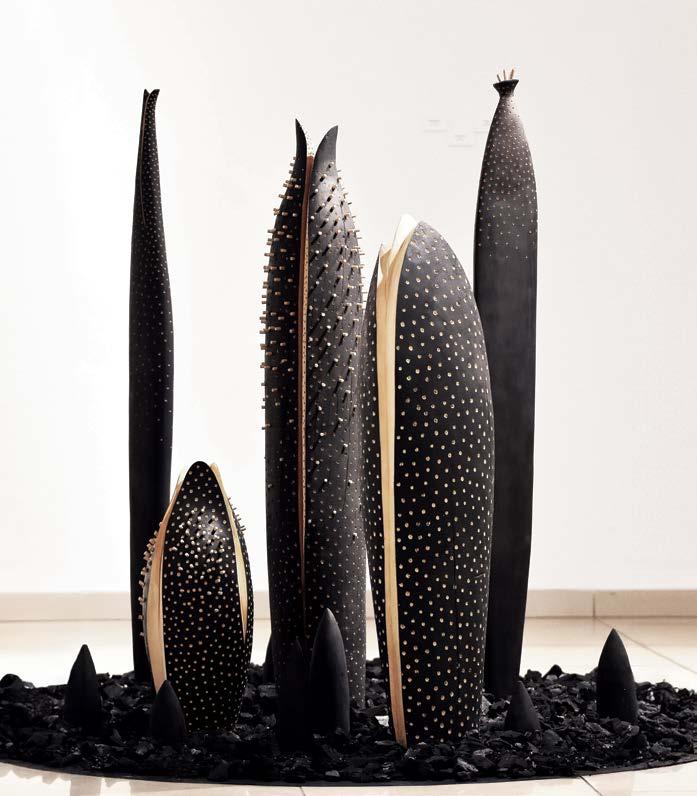
Por Lucía Rey. Académica e investigadora independiente (Chile)
Imágenes cortesía de la artista. Representada por Building Bridges Art Exchange.
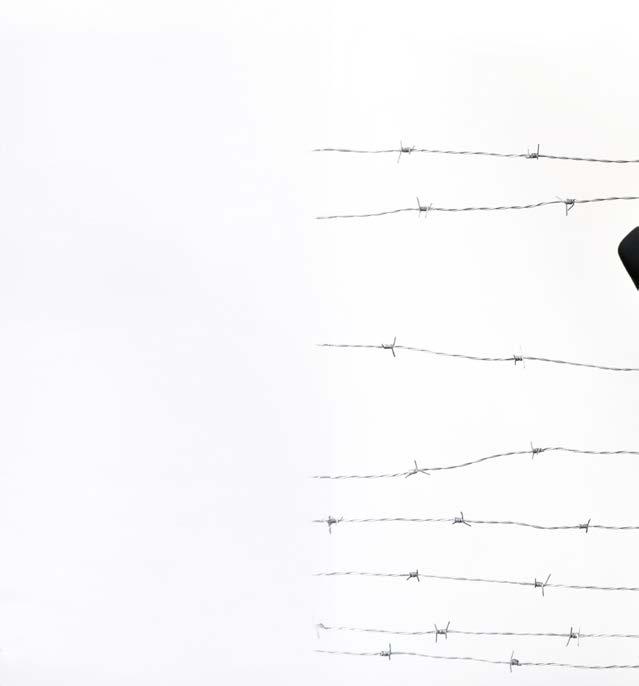
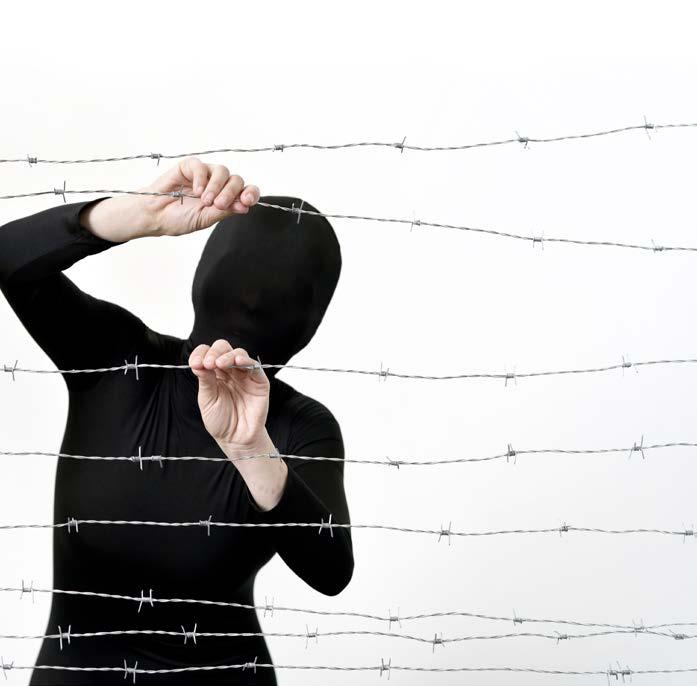
- No comment -, 2020, fotoperformance, impresión en plexiglass, 45 x 51 cm.
l as imágenes que aquí se presentan se enmarcan en un grupo de obras de Petra Eiko que están ligadas entre sí a través de la inquietud colectiva de la problemática ecológico-política actual, como también de la preocupación existencial en lo individual a la que ha sido llevada la humanidad entre la segunda guerra mundial (en Alemania, país donde nace la artista) y el presente post-pandémico.
Por una parte, en la serie No comment, se puede ver fotografiada la figura performática de “Niemand”, un personaje femenino anónimo que gesticula los diferentes tránsitos emocionales basales que se desencadenan en periodos intensamente inestables para la sociedad, como también, pretende dar espacio a la fuerza del anonimato para superar las dificultades. La figura está completamente vestida con una segunda piel negra, dejando solo al descubierto sus manos, responsables corporales de la expresión del hacer; ocultando en la imagen los pies, lo que le da un carácter espectral. Esta cobertura, casi total del cuerpo, invita a la pregunta por el desplazamiento contemporáneo de la identidad personal, en medio de una cultura de masas impuesta como código en las más diversas direcciones, que debilita la inquietud y la intensidad de lo propio. El color negro neutraliza la personalidad de la modelo, la vacía simbólicamente para que, como imagen, esté disponible a ser llenada por cada espectador que se involucre con la obra. También, lo negro, alude a las luchas internas y materiales, que como individualidades humanas vivimos
the images presented here, part of a series by Petra Eiko, are intertwined through collective concern over current eco-political issues and individual existential concerns that humanity has been led to since the Second World War (in Germany, the artist’s native land) until our post-pandemic present.
On one hand, the series No comment features the performative figure of “Niemand.” an anonymous female character that conveys the raw waves of emotion triggered by intensely uncertain periods in society, in an effort to overcome difficulties from the tenacity of anonymity. The figure is fully dressed in a black skintight suit, baring just her hands for expression, and hiding her feet, which gives the figure a spectral quality. This almost full body coverage sparks the question of the contemporary development of personal identity, in the midst of a mass culture widely imposed like a code that weakens the pursuit and the intensity of the self. Black neutralizes the model’s personality, symbolically emptying it so, as an image, it is available to be filled by the viewers who engage with the piece. Moreover, it alludes to the inner and material struggles that, as human individuals, we deal with from birth to death, and which worsen in times of social
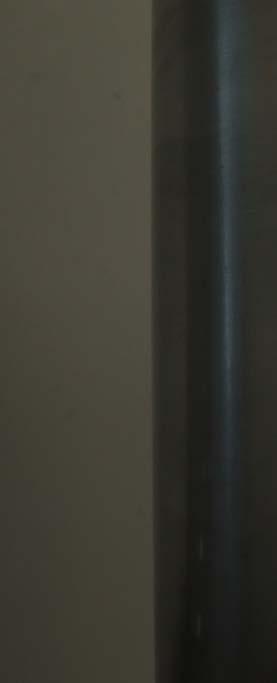
 - Sense of space - 2022, instalación, tubos de aluminio con plexiglás, semiesferas, 154 x 45 cm. de diámetro. Foto: Martin Cohen.
- Sense of space - 2022, instalación, tubos de aluminio con plexiglás, semiesferas, 154 x 45 cm. de diámetro. Foto: Martin Cohen.
“Los espectros están ahí, aunque no existan, aunque ya no estén. Aunque todavía no estén. Nos hacen pensar el ‘ahí’ desde el momento en que abrimos la boca.”
desde el nacimiento hasta la muerte y que son aumentadas en momentos de crisis social. No comment fue creada poco antes de la pandemia y traduce, estéticamente, la opresión de una sociedad altamente urbanizada, alienada, alejada de la naturaleza y burocratizada por los sistemas políticos.
La segunda serie: Sense of Space, es una instalación de seis tubos verticales de aluminio con incrustaciones hemisféricas de plexiglás, dentro hay fotografías intervenidas digitalmente o con pintura directa sobre el acrílico. Los tubos, como materialidad destinada a reflexionar sobre la sequía indican los conductos del agua, que desvían, o sea, dan un tránsito artificial a los fluidos hídricos del planeta en las megalópolis. Los hemisferios de acrílico, vueltos hacia el exterior, contienen fotografías de ojos, que fueron tomadas y seleccionadas tras un largo proceso fotográfico a más de 260 personas. Los hemisferios que están vueltos hacia el interior contienen fotografías emanadas de la serie: No comment. Esta forma hemisférica nos remite, por una parte, a un aislamiento abovedado sintético que limita, pero también nos puede transportar al lugar específico de la figura del ojo observador que, en el intento de salir del tubo para observar, es penetrado y observado entre los reflejos del plexiglás. En este sentido, este material elegido por la artista, siendo industrial, de difícil manejo, refleja al observador casi como un espejo.
crisis. No comment was created shortly before the pandemic and it aesthetically translate the oppression of a highly urbanized, alienated, society that has become removed from nature and bureaucratized by political systems.
The second series, Sense of Space , is an installation of six upright aluminum pipes with embedded plexiglass hemispheres showcasing either digitally-manipulated or paint-treated photographs. As chosen materials, the pipes are meant for us to reflect of droughts, as they symbolize the vessels that carry or divert water, giving it an artificial pathway from the planet’s natural water sources to megacities. The hemispheres protruding outwards contain pictures of eyes, carefully shot and curated from a long photo-recording process involving over 260 participants. The hemispheres sinking inwards have photographs from the series No comment . These hemispheres seemingly allude to a synthetic vaulted isolation, which constrains us, but can also make us zero into the figure of the observing eye that, in an attempt to glimpse out of the pipe, is in turn pierced and observed, among the reflections of the plexiglass. In this sense, the material the artist chose, which is industrial in nature and difficult to handle, reflects the viewer, almost like a mirror.

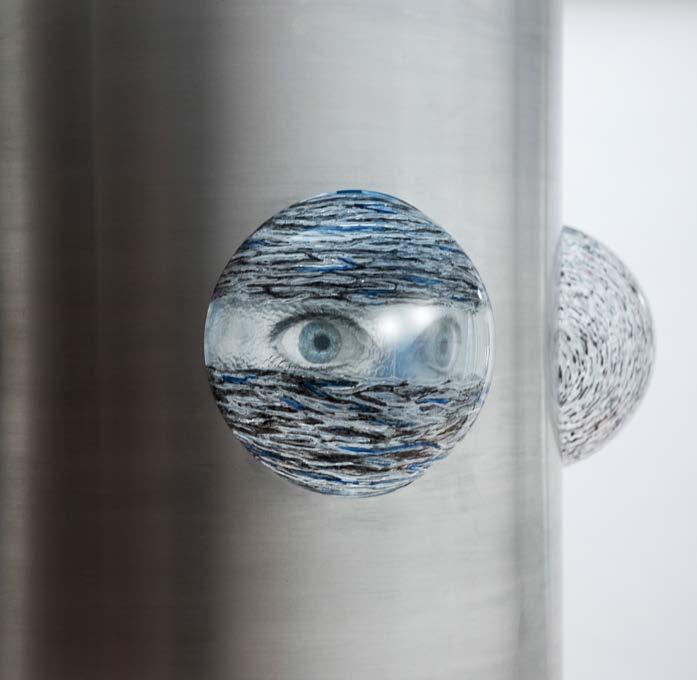 - Sense of space -, 2022, tubos de aluminio con plexiglás, semiesferas, 154 x 45 cm. de diámetro. Foto: Niku Kashef.
- Sense of space -, 2022, tubos de aluminio con plexiglás, semiesferas, 154 x 45 cm. de diámetro. Foto: Niku Kashef.
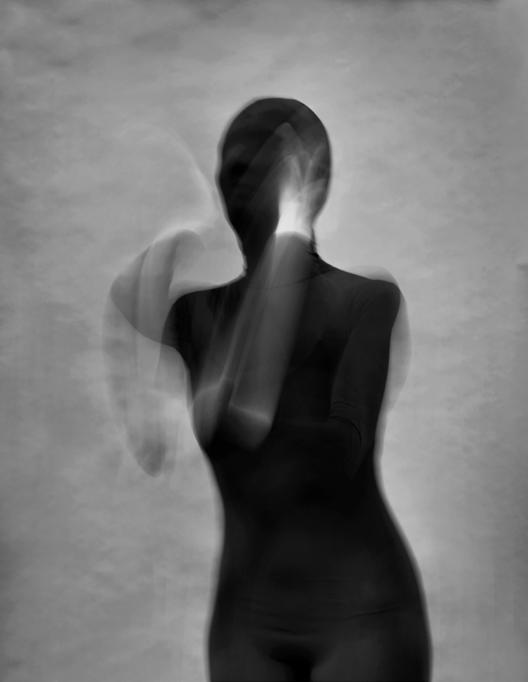
- No comment -, 2020, fotoperformance, impresión en plexiglass, 45 x 51
cm. Foto: Martin Cohen.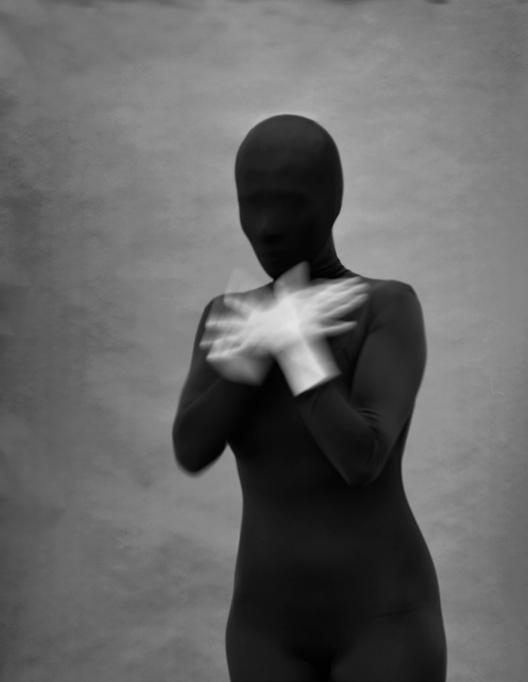 - No comment -, 2020, fotoperformance, impresión en plexiglass, 45 x 51 cm. Foto: Martin Cohen.
- No comment -, 2020, fotoperformance, impresión en plexiglass, 45 x 51 cm. Foto: Martin Cohen.
“They are always there, specters, even if they do not exist, even if they are no longer, even if they are not yet. They give us to rethink the ‘there’ as soon as we open our mouths.”
Este efecto espejo se acentúa en la siguiente serie con forma de cajas. Son objetos escultóricos construidos con plexiglás color negro, en cuyo interior hay fotografías que muestran ejercicios performativos conectados con la primera serie “Niemand”, pero esta vez, la figura anónima está dentro de tubos de aluminio, intentando salir por entre las rejillas. En uno de los cubos se puede ver la figura de una colectividad de “Niemand”, pintada en el interior de un hemisferio hacia dentro. Aquí aparece el color rojo en la base, que podría implicar la sangre como vida que une. En otro cubo elabora, con fotografías intervenidas y pintura sobre el acrílico, diversidad de ojos que contienen escrituras reconocibles como voces. Estos objetos funcionan como metáforas de un proceso interior de reflexión en torno a la propia proyección en la esfera global del planeta y sobre cómo el mundo proyecta sobre nosotros su sistema, dando cuenta de la necesidad de liberación.
En estas tres series de obra la artista realiza un cruce estético-metafórico, entre problemáticas vitales y existenciales de la hiper-urbanización y la reflexión en torno a la manera en que desemboca en los cuerpos humanos, modificando emocionalmente la mirada ante la realidad. Además se propone destacar la necesidad de generar cambios en lo individual y lo colectivo para alcanzar alguna armonía ambiental y política en la reflexión y práctica cotidiana en la ciudad.
This mirror-like effect becomes recurring in the following series, but in the shape of boxes. They are sculptures built in black plexiglass with photographs depicting the performance gestures of “Niemand” in the first series. However, this time the anonymous figure is within the aluminum pipes, trying to escape from behind the grilles. In one of the cubes, this collective figure of the “Niemand” is painted on an inward facing hemisphere. Red is featured at the base, which might suggest blood as uniting life. In another cube, the artist artfully crafts an array of eyes through manipulated photographs and paint on acrylic, creating pieces of writing one might recognize as the voices in our heads. These serve as metaphors of inner reflection about our own projection in the spheric globe of the planet and about how the world projects its system onto us, thus denoting the need for liberation.
In the three series, the artist manages to aesthetically and metaphorically link the vital and existential issues with hyper-urbanization, as well as encourage reflection on the way it affects human bodies and emotionally alters their perception of reality. The artist aims to highlight the need to effect change, both individually and collectively, to achieve some sort of balance with the environment and politics in the daily reflections and practices of life in the city.
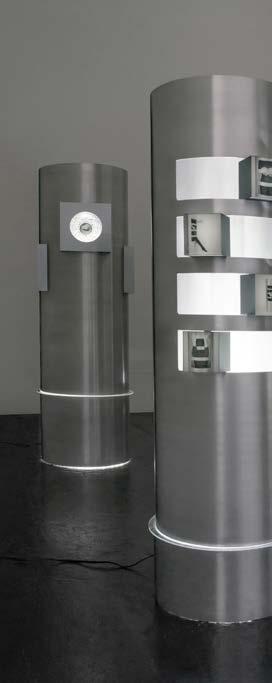
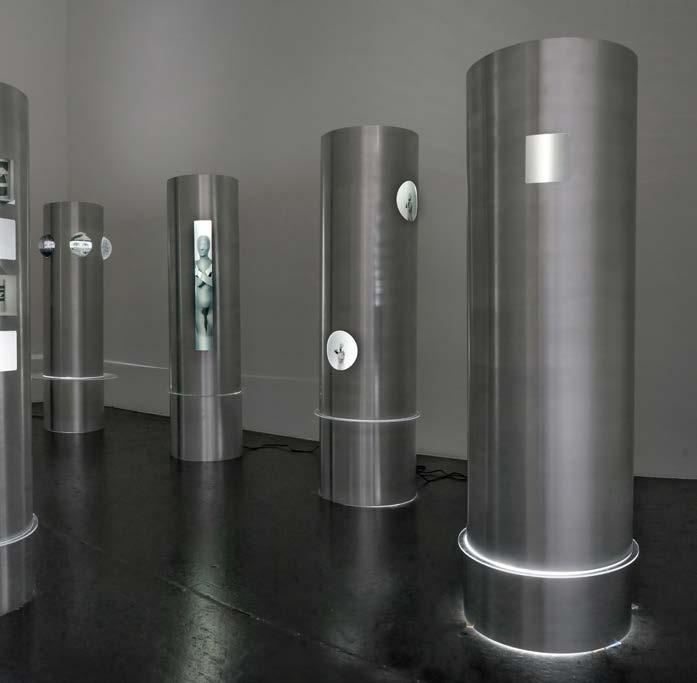 - Sense of space -, 2022, tubos de aluminio con plexiglás, semiesferas, 154 x 45 cm. de diámetro. Foto: Martin Cohen.
- Sense of space -, 2022, tubos de aluminio con plexiglás, semiesferas, 154 x 45 cm. de diámetro. Foto: Martin Cohen.
Por Anubis Burgos. Periodista (Chile) Imágenes cortesía del artista.
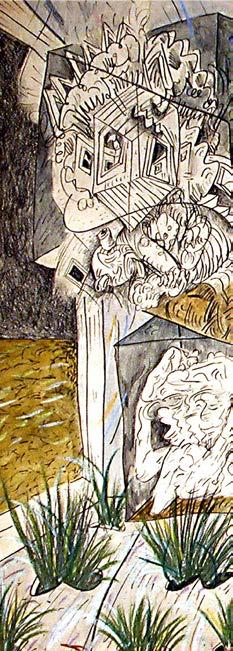
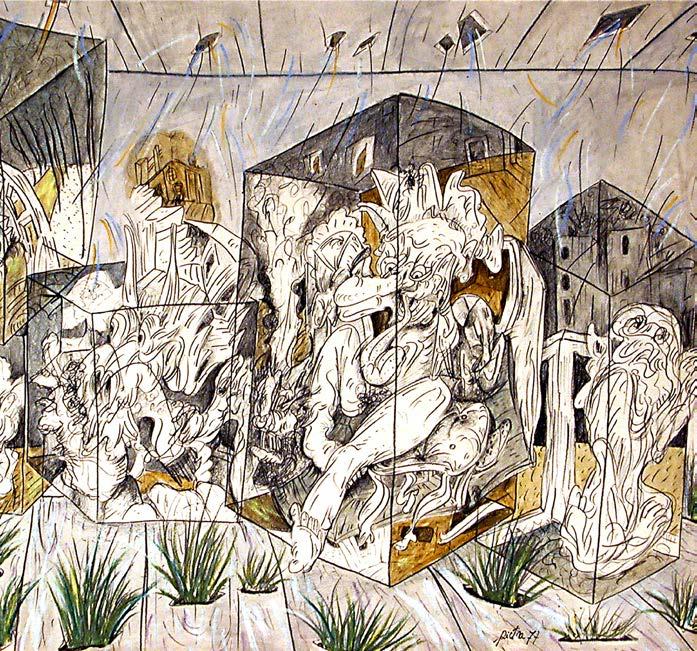 El Jardín, 1977, grafito sobre papel, 45 x 68 cm.
El Jardín, 1977, grafito sobre papel, 45 x 68 cm.
recuerda el momento con nostalgia: 3, 2, 1… ¡Sonrían! Amigos, artistas y colegas posaban alrededor de Alberto Heredia, admiraban a este enigmático escultor y pintor. Al lado de Jorge estaba Carmen Waugh, gestora cultural chilena. Se habían conocido a través de Yuyo Noe, artista plástico argentino, y ella le había ofrecido la oportunidad de presentar su primera exposición Espacios Añicos, el 24 de marzo de 1976. Quién hubiera dicho que ese nombre representaría tan bien ese día: AÑICOS. 1976, 24 de marzo. Algunas de las personas de esa foto no se volvieron a ver.
La foto fue un eco antes de la despedida; al poco tiempo, algunos como Jorge se fueron, otros se encerraron en sus hogares, o como en el caso de Hilda Fernández, con tan solo 26 años, fue declarada desaparecida el 21/01/1977. El clima de la primera exposición de Jorge Pietra fue alegre. Había felicidad por estar juntos, pero también angustia al saber que detrás de ellos todo se estaba haciendo … añicos. La galería quedaba en el centro de la ciudad, muy cerca de la importante Plaza San Martín, la cual se encontraba rodeada por tanques de guerra que días antes habían permanecido estáticos. Ese día fue la excepción, fue el golpe de Estado de Jorge Rafael Videla.
Las fisuras políticas se quedan en el alma
El mismo año en que ocurrió el golpe, Pietra abandonó Argentina. “No fue un viaje con un afán poético de experimentación y autodescubrimiento. Yo huí de una situación insoportable”, confiesa. Pero no se limitó a salir del país, sino que decidió cortar todo contacto con su familia, amigos y colegas durante 6 años. En este tiempo, se enfocó en su desarrollo personal, explorando su identidad y descubriendo quién era realmente. A pesar de las dificultades, nunca dejó de dibujar y pintar. Vivió en Perú,
he remembers the moment fondly: 3, 2, 1… Smile! Friends, artists and colleagues posed around Alberto Heredia, admiring the enigmatic sculptor and painter. Next to Jorge was Carmen Waugh, a Chilean cultural manager, whom he had met through Yuyo Noe, Argentinian visual artist, and she gave him the chance to put on his fist exhibition Espacios Añicos (Shattered Spaces), on March 24, 1976. Who would have thought that name would come to represent that day well? AÑICOS (SHATTERED). March 24, 1976. Some of the people in that photograph never met again.
The picture echoed before the farewells: shortly after, some of them, like Jorge, went away, others locked themselves at home, or, like in the case of Hilda Fernández who has a mere 26 years old at the time, was declared missing on 01/21/1977. The climate surrounding Jorge Pietra’s first exhibit was cheerful. Happiness was in the air over being together, but also anguish at knowing that behind them, everything was... shattering. The gallery was located at the heart of the city, very close to the important San Martín Square, which was surrounded by war tanks that had been stationary for days prior. That day, however, was the exception; it was the day of the coup d’état headed by Jorge Rafael Videla.
Political cracks remain in the soul
The same year of the coup d’état, Pietra left Argentina. “It was not a journey motivated by poetic experimentation and self-discovery. I fled from an unbearable situation,” he confesses. But he did not stop at just leaving the country, he cut all ties with his family, friends and colleagues for 6 years. During that time, he focused on his personal development, exploring his identity and discovering who he really was. Despite the hardships, he never stopped drawing and

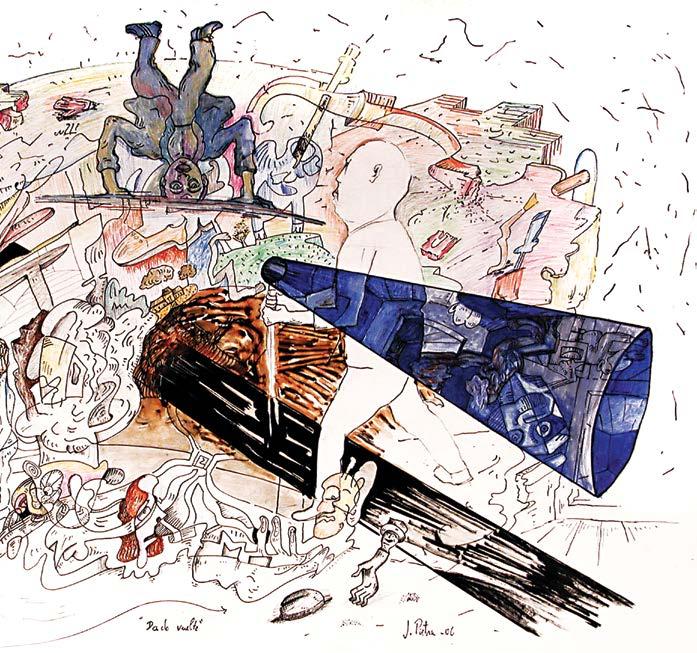 Dado vuelta, 2010, tinta y acuarela sobre papel, 70 x 100 cm.
Dado vuelta, 2010, tinta y acuarela sobre papel, 70 x 100 cm.
México y España, donde su arte floreció y se perfeccionó. En 1982, su talento fue reconocido con el premio Braque, lo que le permitió obtener una beca para estudiar en París. Para Jorge, esta etapa marcó un punto culminante en su vida.
Pero antes de alcanzar este punto, hay que asumir que había vivido plenamente. Después de graduarse de la escuela de Bellas Artes, Pietra comenzó a sentir una fascinación por el surrealismo y por escritores influenciados por la cultura hippie y las “Cartas del Yagé”. Todo esto amplió su mente y su curiosidad sobre qué significaba realmente el surrealismo, un movimiento que sentía latente no solo dentro de él, sino dentro de cada uno de nosotros, y con la ayuda del Yagé, podría vivirlo fuera del lienzo.
Viajó a la selva peruana, recorrió el Amazonas y experimentó el Ayahuasca. Fue una experiencia poderosa para el cuerpo y para el alma, “cambiante y alucinógena, un nuevo cambio de escena como los <<entre actos>> de mi infancia”. Esta experiencia fue en el año 1973, con el paso del tiempo siguió experimentando con otros alucinógenos, tanto naturales como químicos, como el cactus o el LSD. Jorge lo recuerda como experiencias que le aportaron otra perspectiva de las cosas, ¿acaso no es eso el surrealismo? Pietra encontró otros espacios visuales. ¿Punto culmine? Su beca para estudiar en París.
Muralismo para sanar
En 2001 Argentina se encontraba en ruinas. La economía colapsó, mientras que los niveles de desempleo y pobreza aumentaban como espuma. Bajo esta crisis política, Pietra fue convocado por Felicitas Luigi “una mujer increíble” resalta, quien
painting. He lived in Peru, Mexico and Spain, where his art bloomed and refined. In 1982, his talents were acknowledged by the Braque Prize, which earned him a scholarship to study in Paris. For Jorge, this marked a defining moment in his life.
But before he reached that point, he had admittedly lived fully. After graduating from the Fine Arts School, Pietra began to feel fascinated by surrealism and writers influenced by hippie culture and “The Yage Letters.” This expanded his mind and curiosity about what surrealism truly meant, a movement that pulsating within him and every single one of us. With the help of yagé, he could experience it outside of the canvas.
He traveled to the Peruvian jungle, navigated through the Amazon and experimented with Ayahuasca. It was a powerful experience for the body and the soul, “transformative and hallucinogenic, a change of chapter, like the ‘between acts’ in my childhood.” This experience was in 1973, and in time he continued to experiment with other hallucinogenics, natural and chemical alike, such as psychoactive cactus or LSD. Jorge remembers these as experiences that gave him a new perspective on things. Isn’t that what surrealism is all about? Pietra found other visual spaces. The ending point? His scholarship in Paris.
Mural art for healing
In 2001, Argentina was in shambles. The economy collapsed, while unemployment and poverty rates ramped up. In this climate of political turmoil, Pietra was summoned by Felicitas Luigi –”an amazing woman,” he says, who was
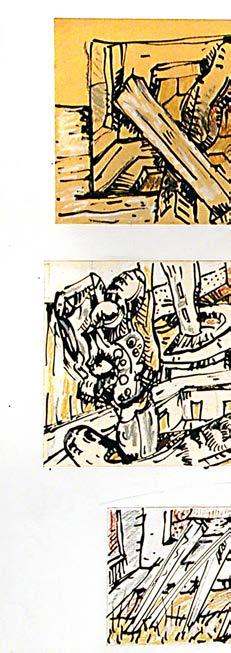
 De la serie Colonia Nápoles, 1982, tinta y grafito sobre papel, 80 x 110 cm.
De la serie Colonia Nápoles, 1982, tinta y grafito sobre papel, 80 x 110 cm.
había estado detenida muchos años por sus ideas políticas —contrarias— a la dictadura. Felicitas, quien trabajaba en la Municipalidad, convocó a pintores para colaborar y ayudar a crear murales junto a personas en situación de calle. Jorge coordinó a su propio grupo, “había de todo, gente de la calle, locos, algún travestí alcoholizado, un aprendiz de pastor evangelista y personas que estaban desocupadas, probablemente desempleadas. Una fauna variada, pero rica”, resalta.
El grupo pintó sus vidas en las fachadas de Buenos Aires, todas y todos tenían una necesidad imperiosa de expresarse. A través de esmalte, enduido y látex, fueron sanando en conjunto. Los materiales y comida los entregaba la Municipalidad por medio de donaciones, “fue una experiencia, para mí, extraordinaria”. Estuvieron pintando 6 años, hasta que Felicitas falleció en 2007.
Una vida sin arte, imposible
“Desapareció el arte como movimiento de cambio, de resistencia, de búsqueda y compromiso por nuevas formas estéticas”, señala Pietra, cuestionando la rapidez de la comunicación actual, la cual cambió la forma de pensar y observar. Además, las instalaciones más ligadas a la escenografía y al show visual son disfrutadas visualmente por el público, pero se reflexiona poco en torno a ellas: “antes, para comprender una pintura, se necesitaba un tiempo de reflexión y observación, ahora eso se puede reemplazar por buscar la explicación en el celular”.
A pesar de todo eso, ve el arte como fundamental para crecer, no rendirse y acercarse a infinitos mundos, “la vida sería terrible sin arte -sonríe-, el objetivo con que
detained for many years due to her political ideology challenging the dictatorship. Felicitas, who worked for city hall, summoned painters to help create and collaborate on murals along with the unhoused. Jorge led his own team: “it was a diverse group: homeless people, crazy people, an inebriated drag queen, an apprentice evangelist pastor and idle people who were probably unemployed. A varied but rich diversity,” he emphasizes.
The group painted their lives on the facades of Buenos Aires; everyone had a pressing need to express themselves. Through varnish, caulk and latex, they healed together. The materials and food were provided by city hall through donations. “For me, it was an extraordinary experience.” They painted for 6 years, until Felicitas passed away in 2007.
Life without art, impossible
“Art disappeared as a movement for change, resistance, search for and commitment to new aesthetics,” Pietra states, questioning the speed of current communications, which shifted ways of thinking and contemplating. Likewise, installations related to stage design and visual shows are appreciated by the public for their visuals, but there comes little reflection from them: “Before, time for reflection and contemplation was necessary to understand a painting. Now, that can be replaced by finding an explanation of a cellphone.”
Despite this, he regards art as fundamental for growth, not giving up and exploring infinite worlds: “Life would be terrible without art –he says smiling. The
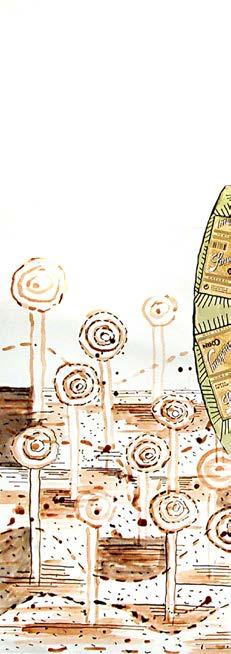
 Esmoquin de Papel, 2010, tinta, collage y acuarelas sobre papel, 70 x 100 cm.
Esmoquin de Papel, 2010, tinta, collage y acuarelas sobre papel, 70 x 100 cm.
el que yo he compartido mi obra es transmitir mis visiones, emociones, sueños y pensamientos expresados en imágenes. Siempre de forma genuina y energética”. Para Pietra, es compartir su mundo interno y con eso llegar al corazón de la gente, lo motiva y le da las ganas que necesita para seguir pintando a sus 70 años.
Dar vida al mundo interno
Jorge pinta sobre materiales tradicionales como tela con óleos y acrílicos. Además, trabaja sobre papel con tinta china, utilizando lápices y acuarelas. Sus dibujos pueden parecer paisajes oníricos en cada trazo, como él comenta “hay que reflexionar en torno a ello”, y envolverse en estos grandes óleos que eclipsan las paredes inmaculadas de los museos. Entre más se observa, nuevos elementos aparecen en escena y dan vida a un sinfín de historias dentro de la misma pintura.
Los lienzos tienen elementos de color que destacan lo que el artista busca transmitir, además de caras deconstruidas y otras realistas. Algunas de las obras parecen la explosión del pensamiento y sentimiento, otorgando sentido a este mundo surrealista en el que Pietra se ha sumergido desde siempre.
El arte de Jorge Pietra es la búsqueda del mundo interno, del arte americano que ha cosechado durante tantos años de carrera. Esto se ve reflejado en las raíces latinas de sus pinturas; en la forma en que decidió escuchar su mundo interno; y en el cómo, con 17 años, se unió a la Escuela de Bellas Artes. Más de 50 años después, sigue soñando despierto y luchando por las cosas que le parecen correctas.
goal of sharing my work is to convey my vision, emotions, dreams and thoughts expressed in images, always in a genuine and energetic way.” For Pietra, sharing his inner world, and reaching people’s heart by doing so, drives him and gives him the encouragement he needs to continue painting at the age of 70.
Jorge paints with traditional materials like oil and acrylic on canvas. He also works with Chinese ink, pencils and watercolors on paper. His drawings seem like dreamlike landscape with every stroke. As he comments: “We must reflect on them,” and surround ourselves with these great oil paintings that eclipse the immaculate walls of the museums. The more attention paid to his work; the more elements appear on the scene to breathe life into countless stories within the same painting.
Canvases feature colors that highlight what the artist is seeking to convey, along with some deconstructed and realistic faces. Some pieces look like explosions of thoughts and feeling, providing meaning to the surrealist world that Pietra has always immersed himself in.
Jorge Pietra’s artwork is the quest for the inner world, of the American art he has cultivated for so long in his career. This is reflected in the Latin roots of his paintings, in the way he decided to listen to his inner world, and in how, at 17, he joined the Fine Arts School. Over 50 years later, he keeps daydreaming and fighting for the causes he believes to be right.
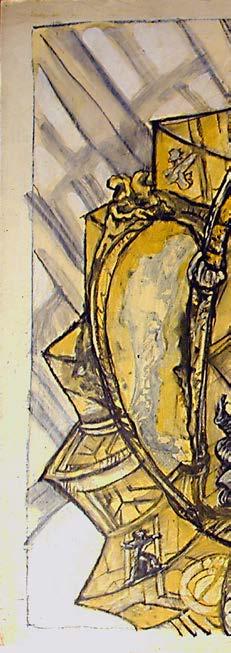
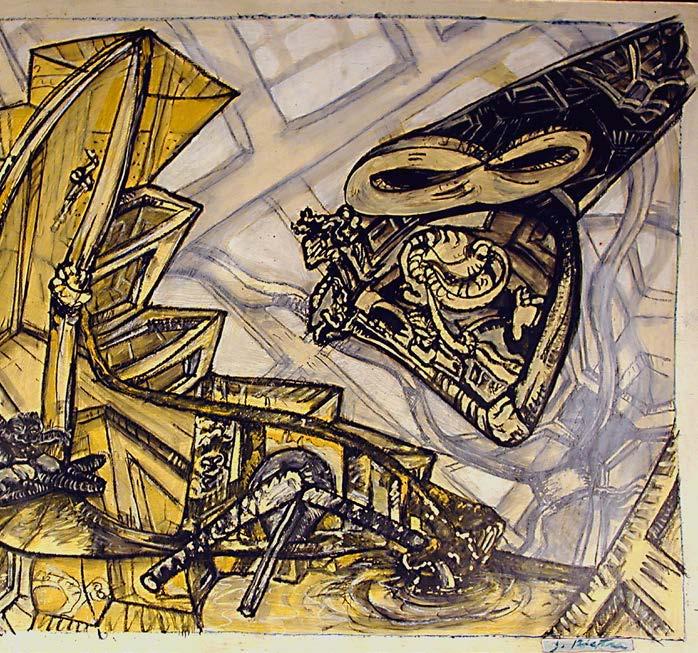 De la serie, Colonia Nápoles, 1982, tinta y grafito sobre papel, 80 x 110 cm.
De la serie, Colonia Nápoles, 1982, tinta y grafito sobre papel, 80 x 110 cm.
Por Emilio Senn. Periodista (Chile) Imágenes cortesía del artista.
Representado por Isabel Croxatto Galería.
 Cíclope, 2022, óleo sobre tela, 169 x 142 cm.
Cíclope, 2022, óleo sobre tela, 169 x 142 cm.
monstruoso
“la estructura de una película de terror tiene por función velar al espectador el objeto de su miedo. Lo traslada a otro objeto, una sábana, por ejemplo. Lo sobrenatural no tiene forma ni nombre, eso es lo inquietante”. Así define su propia obra el artista visual e ilustrador Rolankay. En detalle, se refiere a la representación de figuras salvajes y bestiales en sus retratos, una constante que trenza las piezas de un catálogo regido por tintes sólidos, colores electrificantes y mitos para fantasear.
Con una carrera relativamente joven -su primera exposición data de 2015-, Rolankay admite que tomó el camino largo hasta llegar a su primer lienzo. Uno que empezó en el calor de una familia trabajadora tradicional del norte de Chile y que lo llevó luego a formarse como psicólogo. Sin embargo, y pese a que puedan parecer capítulos diferentes, tanto el origen como la configuración académica del autor son líneas que él aún traza en sus pinturas. “Hay una ebullición en las cosas que se regula por la sociedad, pero está ahí”, reflexiona. De esta forma, y citando a Freud, Rolankay reconoce sus inquietudes y manifestaciones artísticas.
Así es como su camino artístico no siempre estuvo tan definido como los colores de su obra. Al repasar su historia, analiza su aproximación al arte y concluye que Chile es un país muy pobremente educado visualmente, sin eximirse de ello. A modo de anécdota, cuenta que no conoció a Picasso, más allá de su nombre, hasta los 21 años, y que esa carencia formativa también era un alma en pena durante sus años de universitario cuando, después de psicología, ingresó a la carrera de ilustración. “Me miraban como a alguien anacrónico. Encontraban extraño, en 2011, que en plena explosión de las herramientas digitales o en la tendencia académica por el arte conceptual y performance, estuviese pintando cuadros al óleo”, relata. De allí su inquietud por habitar la selva del arte visual, en un escenario ideal donde todas las disciplinas pueden coexistir. Su apuesta es compartir lo que ve en ciertos autores como David Hockney, e inscribir a la vez una propuesta estética completamente identitaria.
Asociación, construcción y aplicación. Esas son las tres postas creativas que sostienen el trabajo de Rolankay. “Al ponerme a trabajar en la tela, es importante estar atento a lo que pasa en ella”, y cuenta que antes de sentarse frente al lienzo en blanco, conjuga accidentes y experimentos que pueden desembocar en una arrebatada primera línea dentro de un espacio vacío o de un bosquejo que sirve como punto de partida. “Hay que construir la posibilidad de un diálogo con los materiales que estás trabajando. Si empieza a aparecer el diálogo, hay que estar atento a guiar lo que está ocurriendo. Probablemente el resultado es más satisfactorio entre más complejo es el conocimiento técnico previo e intuición perfilada”, concluye.
The coexistence
“the structure of a horror film aims to conceal the object of fear from viewers. It transfers it to an object, a bed sheet, for example. Supernatural things do not have a name or shape, that is what makes them unsettling.” This is how visual artist and illustrator Rolankay defines his own work. More precisely, he turns to the representation of wild and monstrous figures in his portraits, a common thread that weaves the elements of a portfolio dominated by solid electrifying colors and myths that make us fantasize.
Still relatively in the early days of his career –his first exhibition was in 2015–, Rolankay admits he took the long way to land on his first canvas. His journey started in the bosom of a traditional working-class family from northern Chile and later led him to train as a psychologist. Though these might seem like different chapters, both the author’s roots and his education are still lines that he traces in his paintings. “There’s a boiling over of things that are socially regulated, but they are there,” he reflects. To quote Freud, Rolankay thus recognizes his artistic concerns and manifestations.
However, the artist’s artistic path was not always as clearly outlined as the colors of his work. When examining his story, he ponders on his introduction to art, concluding Chile is a very poorly educated country in terms of visual arts, himself included. As an anecdote, he reveals he did not know about Picasso –or not much other than his name– before he was 21 years old. That lack of education haunted him during his years at university when, after psychology, he pursued an illustration major. “They regarded me as anachronistic. They found it odd that, in 2011, amid the full-blown surge of digital tools and academic trends leaning towards conceptual and performance art, I was doing oil paintings,” he narrates. This is the reason behind his desire to inhabit the visual art jungle in an ideal scenario where all disciplines can coexist. His mission is to share what he sees in certain authors such as David Hockney, and at the same time to set up an aesthetic proposal that is completely based on his own identity.
Association, construction and application. Those are the three creative pillars that support Rolankay’s work. “When I work on a canvas, it is important to be aware of what happens on it,” he says followed by revealing that, before sitting to face a blank canvas, he combines accidents and experiments that can lead to a sudden first line within the empty space or a sketch that serves as a starting point. “You have to build the possibility of a dialog with the materials you’re working with. If the dialog starts to emerge, you have to be watchful and guide what is going on. The result is probably more satisfactory the more complex your technical knowledge and the sharper your intuition,” he concludes.
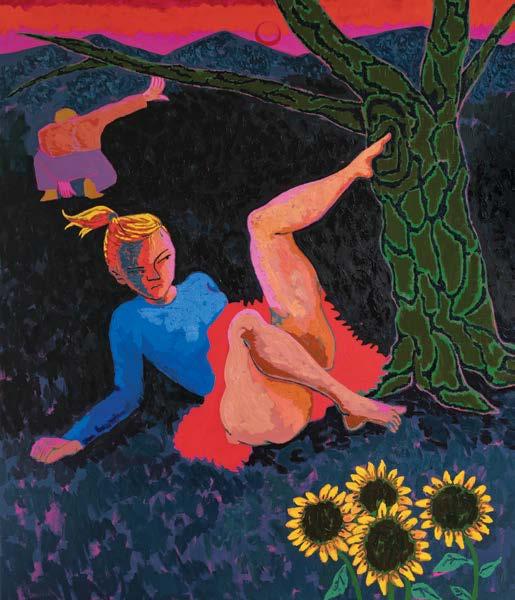 Abrir Una Herida, 2023, óleo sobre tela, 180 x 150 cm.
Abrir Una Herida, 2023, óleo sobre tela, 180 x 150 cm.
Por su parte, los colores sólidos y figuras monstruosas que transforman un departamento de ciudad y la selva en un mismo hábitat, hacen de la obra de Rolankay un verdadero eslabón único dentro del ecosistema visual. “Pienso en generar misterio cuando pienso en mis imágenes”, confiesa. Al mismo tiempo, y si bien reconoce también un subtexto político en sus pinturas, el artista releva la posición de su pincel. En ese sentido, propone que sea la abstracta estética de sus dibujos y personajes los que comuniquen sin necesidad de posar una sola letra entre ellos; además, porque percibe cierta incoherencia entre el discurso político y su arte, al cual reconoce como “burgués”. Con estos elementos en la mano, la intriga que envuelve y moviliza los tintes y trazos de su obra se hacen aún más estridentes.
Al pararse frente una obra de Rolankay se puede reconocer de forma inmediata la convivencia de dos situaciones: la intimidad le da la mano a la extravagancia. “Allí aparecen monstruos, tensión y ambigüedad, junto a la exageración de la luz y de lo emocional”, comenta. Asimismo, el tiempo da un giro a la relación entre el artista y el espectador, mediante la transición de una posición “adolescente”, basada en la idea de pintar para sí mismo, hacia la toma de conciencia de que existe un otro que completará la obra: “El espectador trasciende al individuo; es más bien un colectivo cultural”, reflexiona. En el trabajo de la pintura figurativa, se exige un diálogo entre lo contemporáneo y las inquietudes más personales.
Rolankay ha publicado dos libros de artista, “Zanshin” en 2017 y “Apariciones” en 2021. En tanto, su primera exposición individual, Supersticiones, fue presentada por la galería de Isabel Croxatto en 2022. Estos son hitos que cimentan un crecimiento que, como su autor, se mantiene insaciable y perfila para él una carrera explosiva. “El conocimiento se siente integrado y la intuición, más afilada. Lo importante ahora es tensar de manera sutil el arco -intenciones, búsquedas, plástica- para seguir profundizando”, explica Rolankay respecto al trayecto y dirección que ha tomado su obra.
Así es como se ve una película de terror, con la fascinación por lo bestial y su irrupción en lo humano, pero con la tranquilidad de que una justa cuota de ficción separa al espectador de convertirse en protagonista. La propuesta artística de Rolankay es tan enérgica e impetuosa como sus colores y ese misterio que los afirma en el lienzo.
Solid colors and monstrous figures that transform city apartments and jungles in a single habitat make Rolankay’s work a true and unique link in the visual ecosystem. “I set to build mystery when I think about my images,” he confesses. Likewise, and although he acknowledges the political subtext in his paintings, the artist relegates his stance to his brush. In this sense, he postulates the abstract aesthetic of his drawings and characters are the ones who communicate, without the need to place any letters between them. This because he senses a certain inconsistency between political discourse and his art, which he regards as “bourgeois”. With these elements in hand, the intrigue that shrouds and moves the colors and lines in his work becomes even louder.
When facing one of Rolankay’s pieces, one can immediately identify the coexistence of two situations: intimacy holds hands with extravagance. “Monsters, tension and ambiguity appear there, along with exaggerations of light and emotions,” he comments. Time has shifted the relationship between artist and viewer after he transitioned from an “adolescent” phase where he painted for himself to being aware that there are other people that complete his work: “Viewers transcend individuals; they are rather a cultural collective,” he reflects. In figurative painting, there is a demand for a dialog between the contemporary and the most personal concerns.
Rolankay has published two artist’s books, “Zanshin” in 2017 and “Apariciones” in 2021. In turn, his first solo exhibition, Supersticiones , was held at the Isabel Croxatto Gallery in 2022. These milestones serve as the foundation for a growth which, just like the author, remains insatiable and promises an explosive career. “My knowledge feels more established and my intuition sharper. The important thing now is to fine-tune the target –intentions, quests, visuals– to continue digging deeper,” Rolankay explains on the path and trajectory his work has taken.
His work can be appreciated like a horror film, with the fascination for monstrosity and its invasion into the human, but with the sense of calm that a fair share of fiction separates the viewer from becoming the protagonist. Rolankay’s artistic proposal is as energetic and impetuous as his colors and the mystery that settles them on the canvas.
 Invisible, 2023, óleo sobre tela, 180 x 150 cm.
Invisible, 2023, óleo sobre tela, 180 x 150 cm.
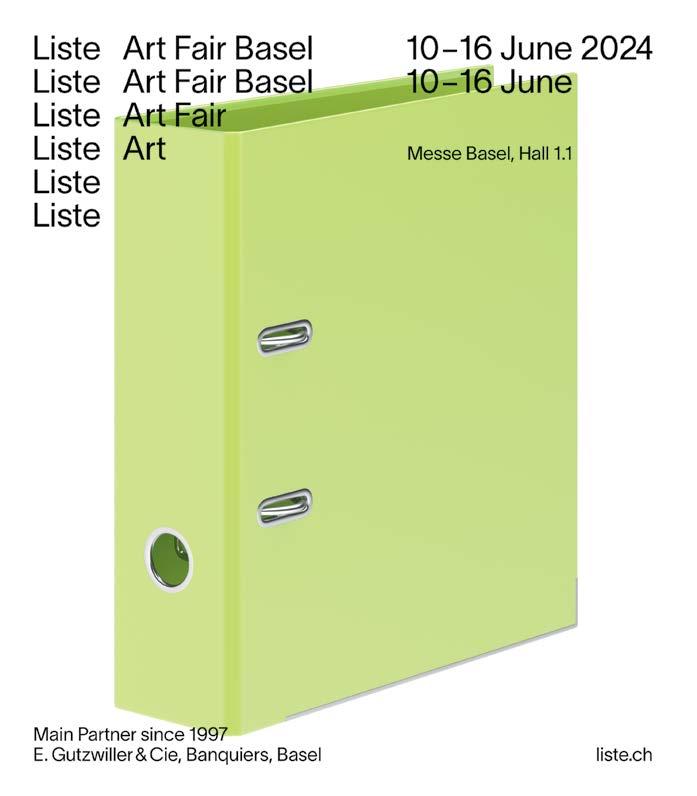
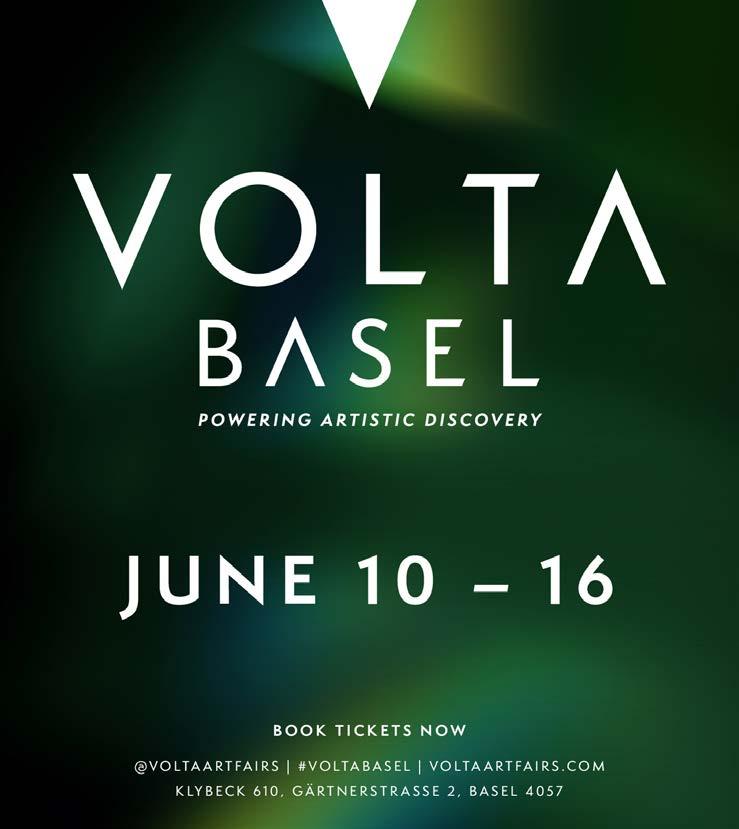
 ZULEMA MAZA | ARGENTINA
ZULEMA MAZA | ARGENTINA